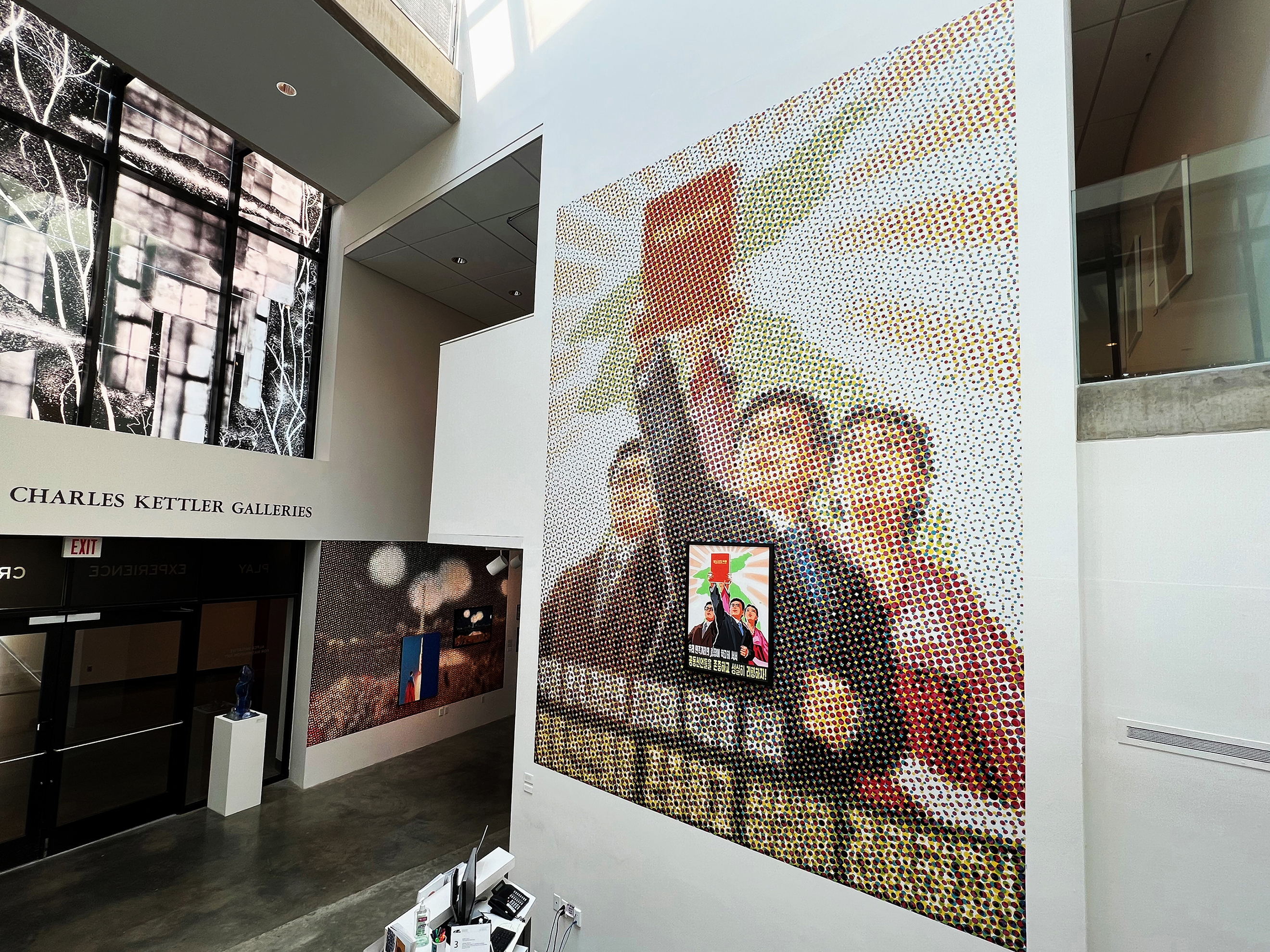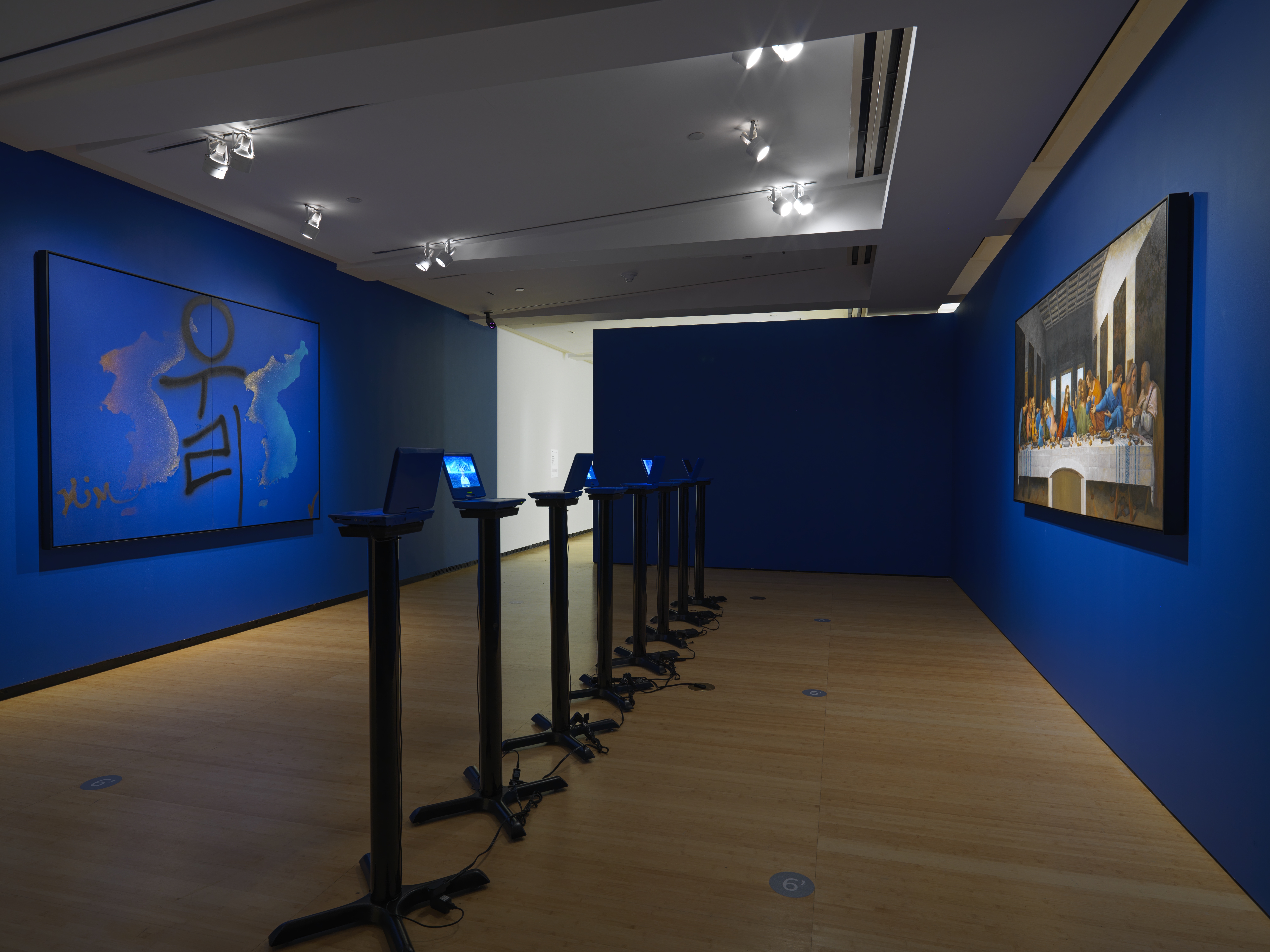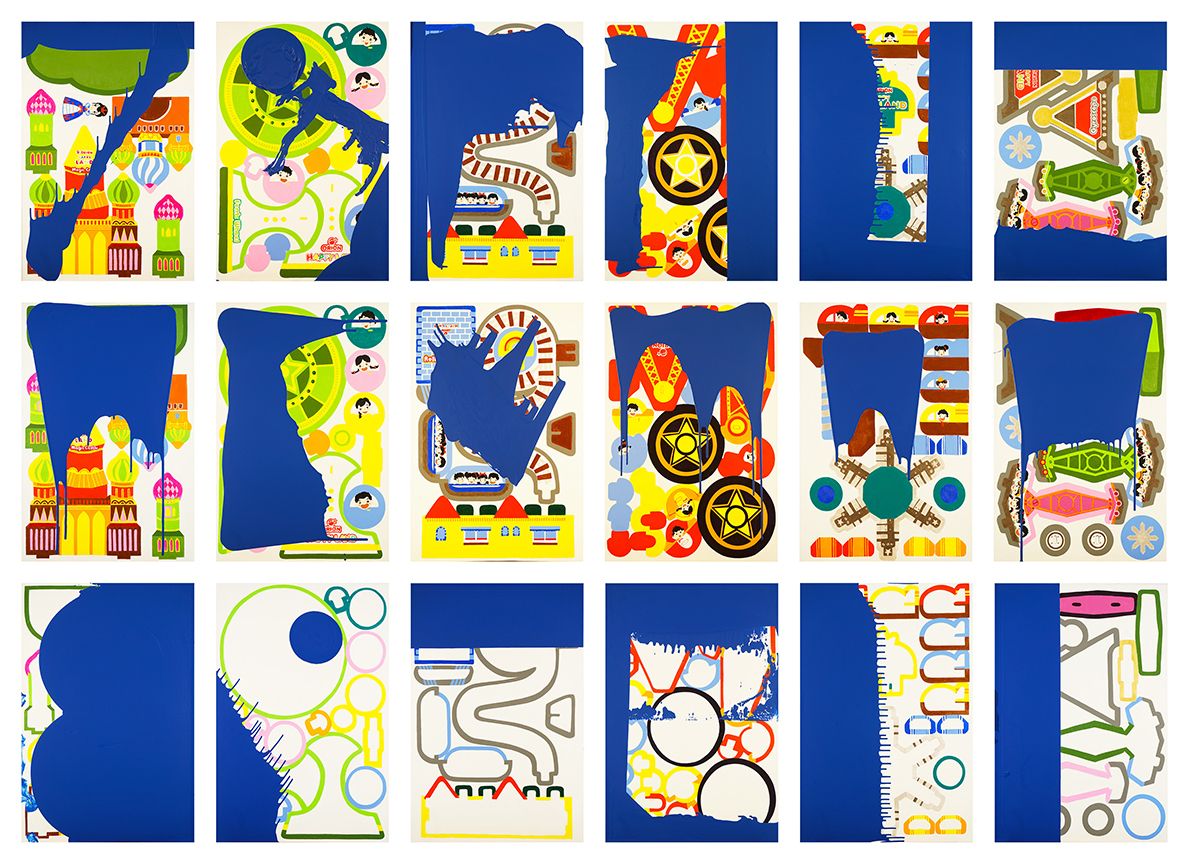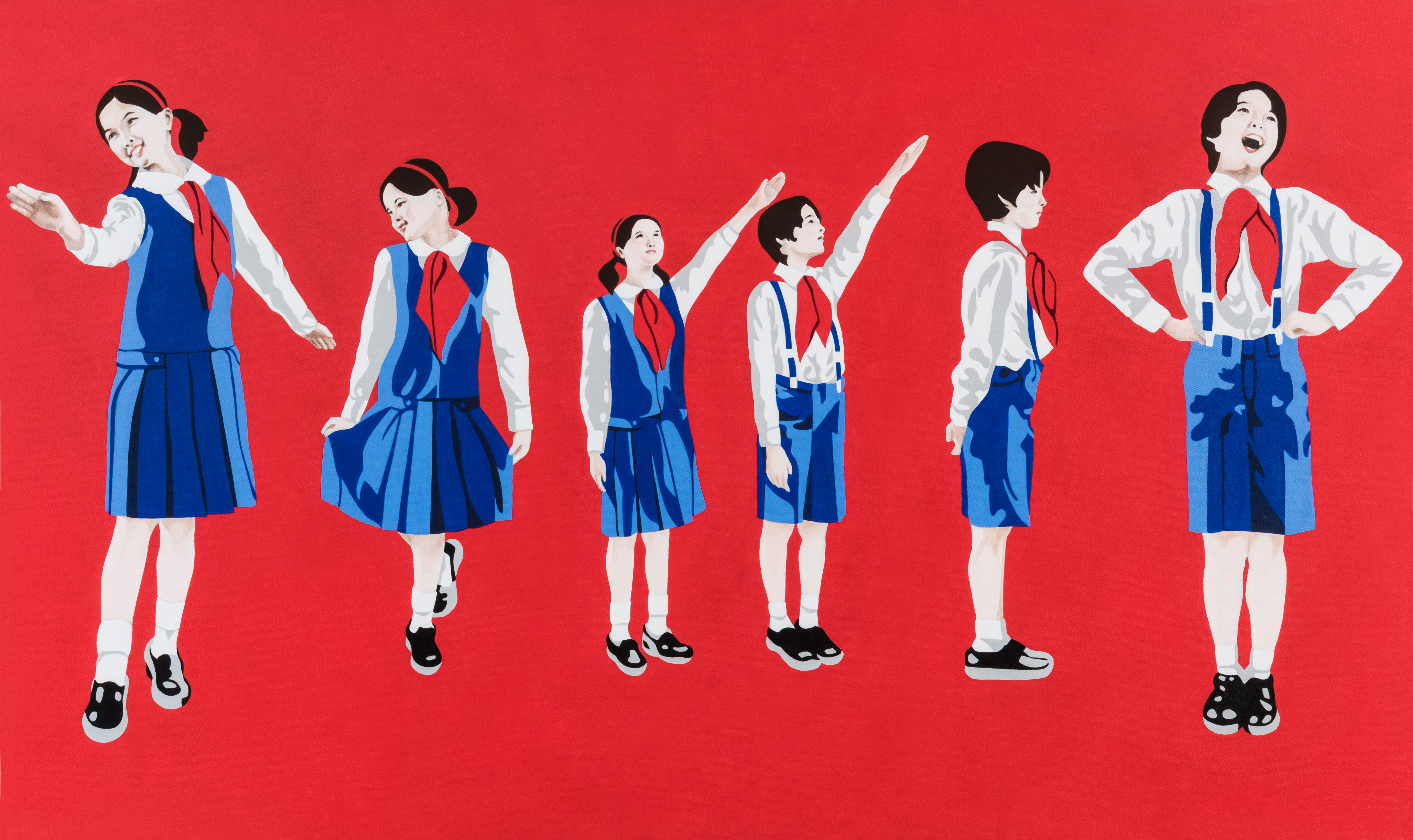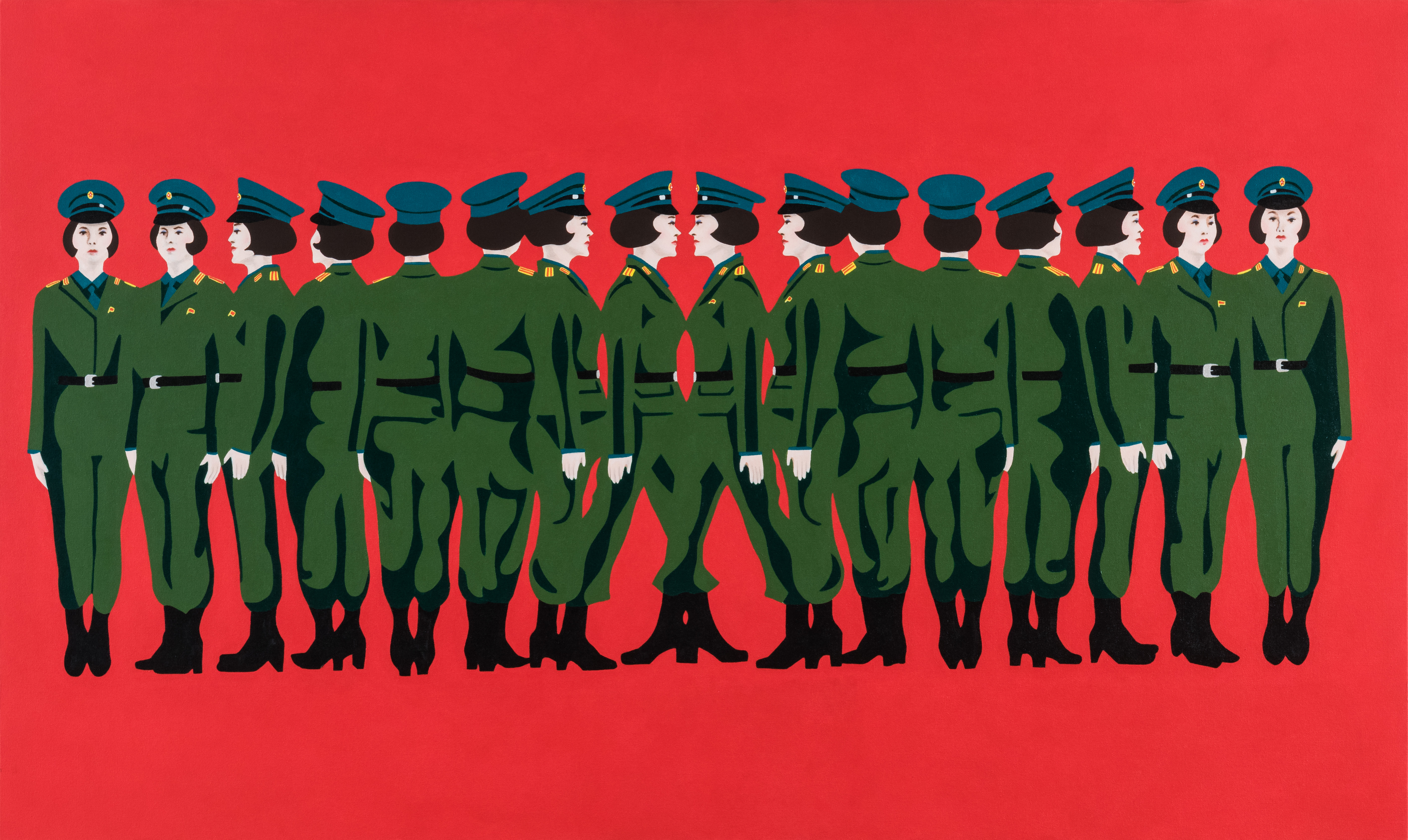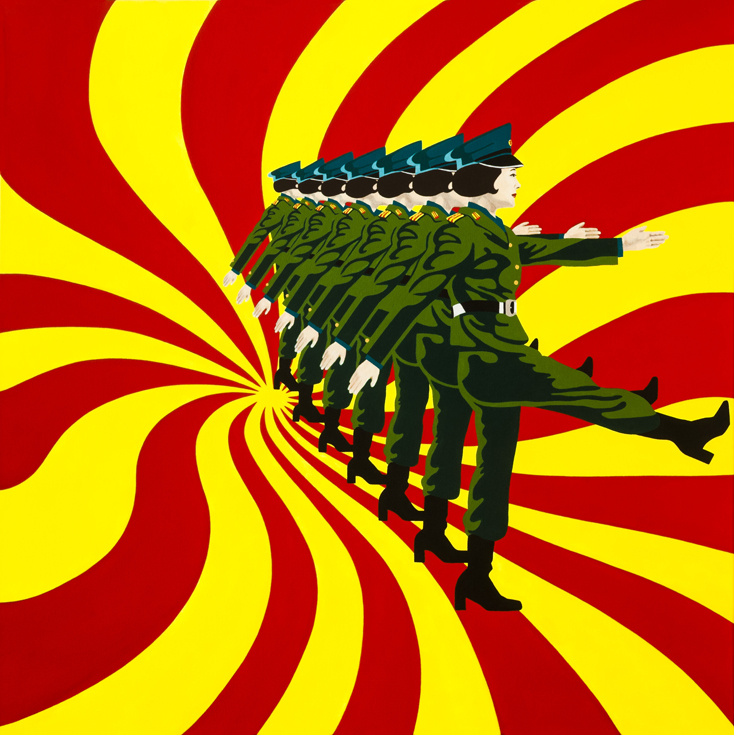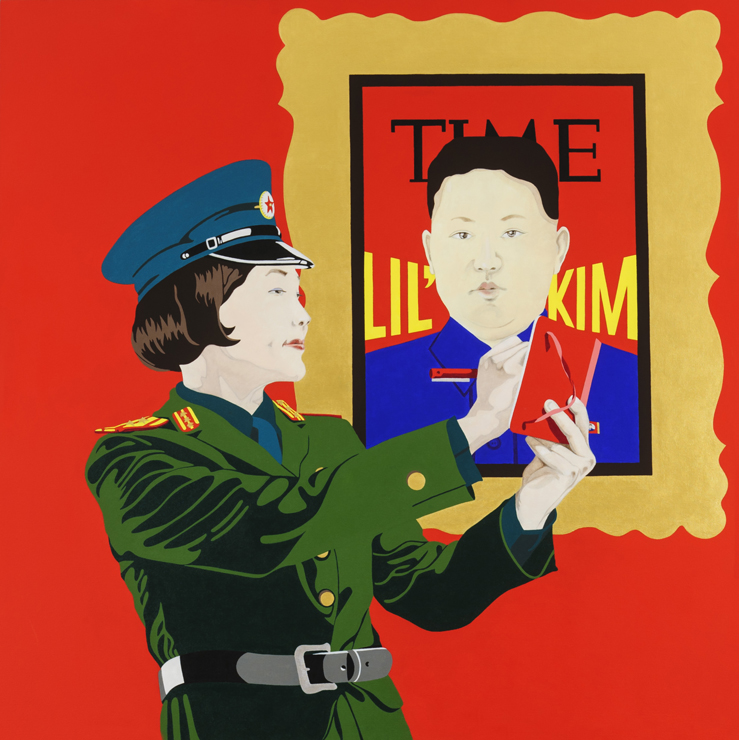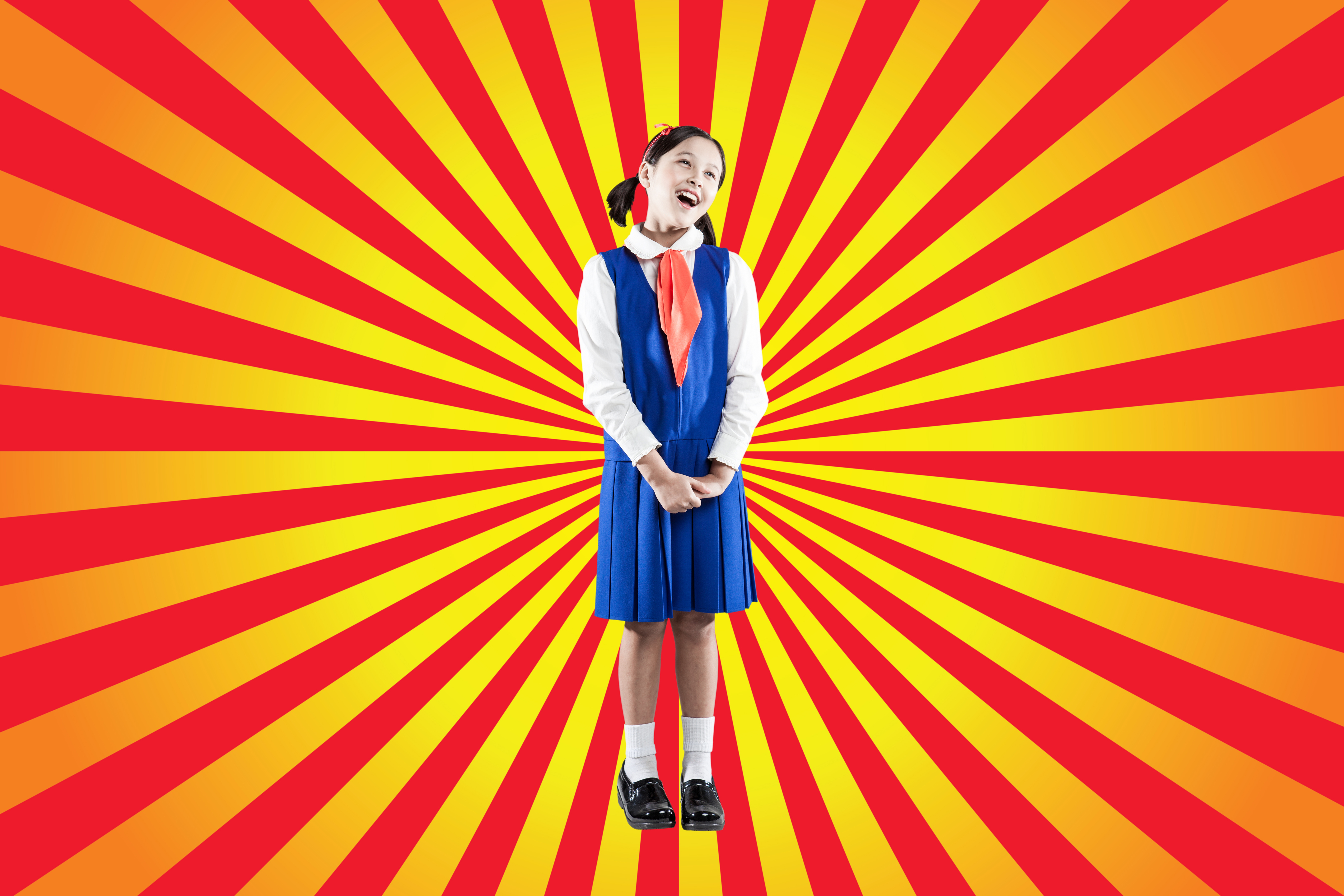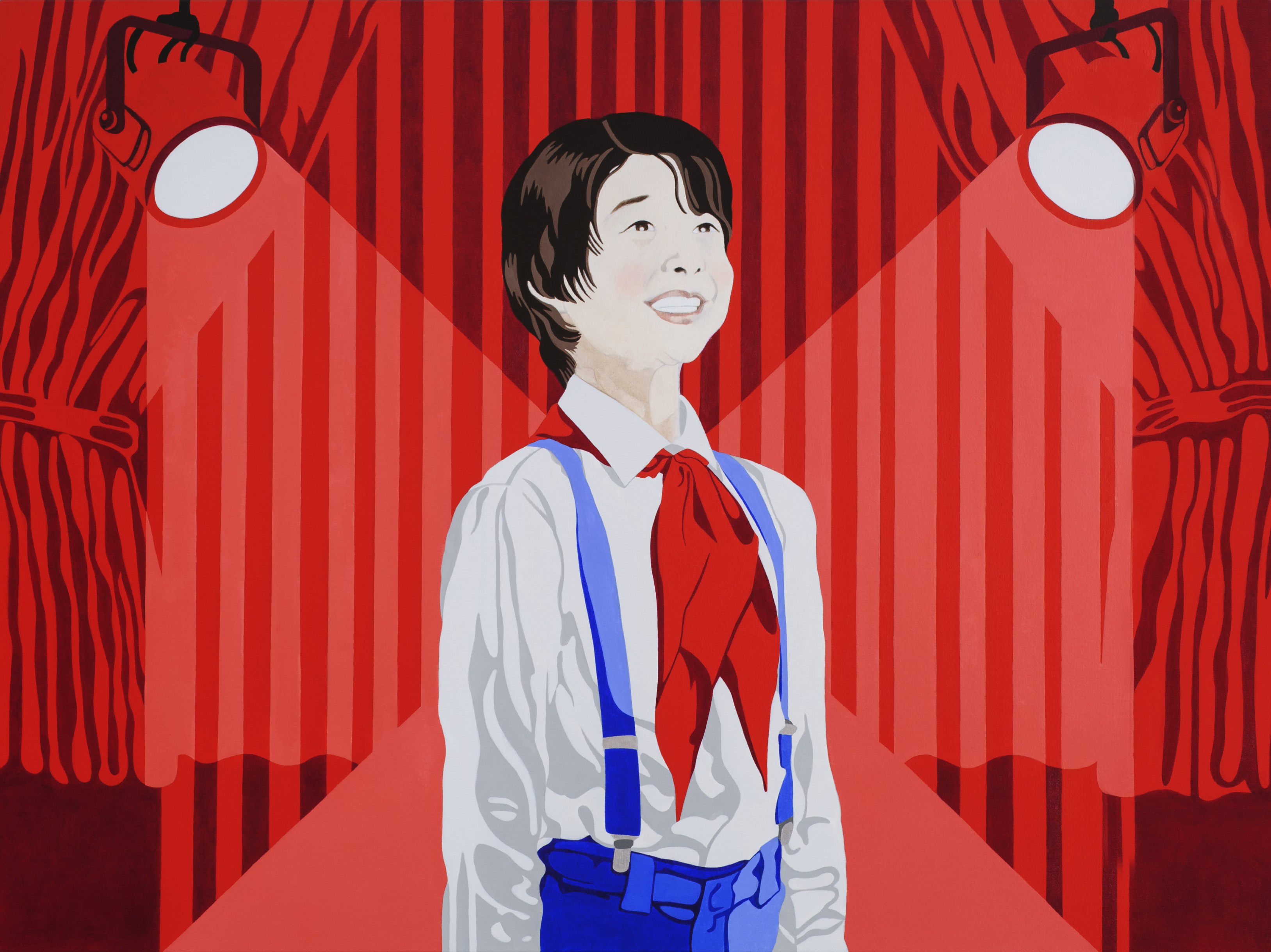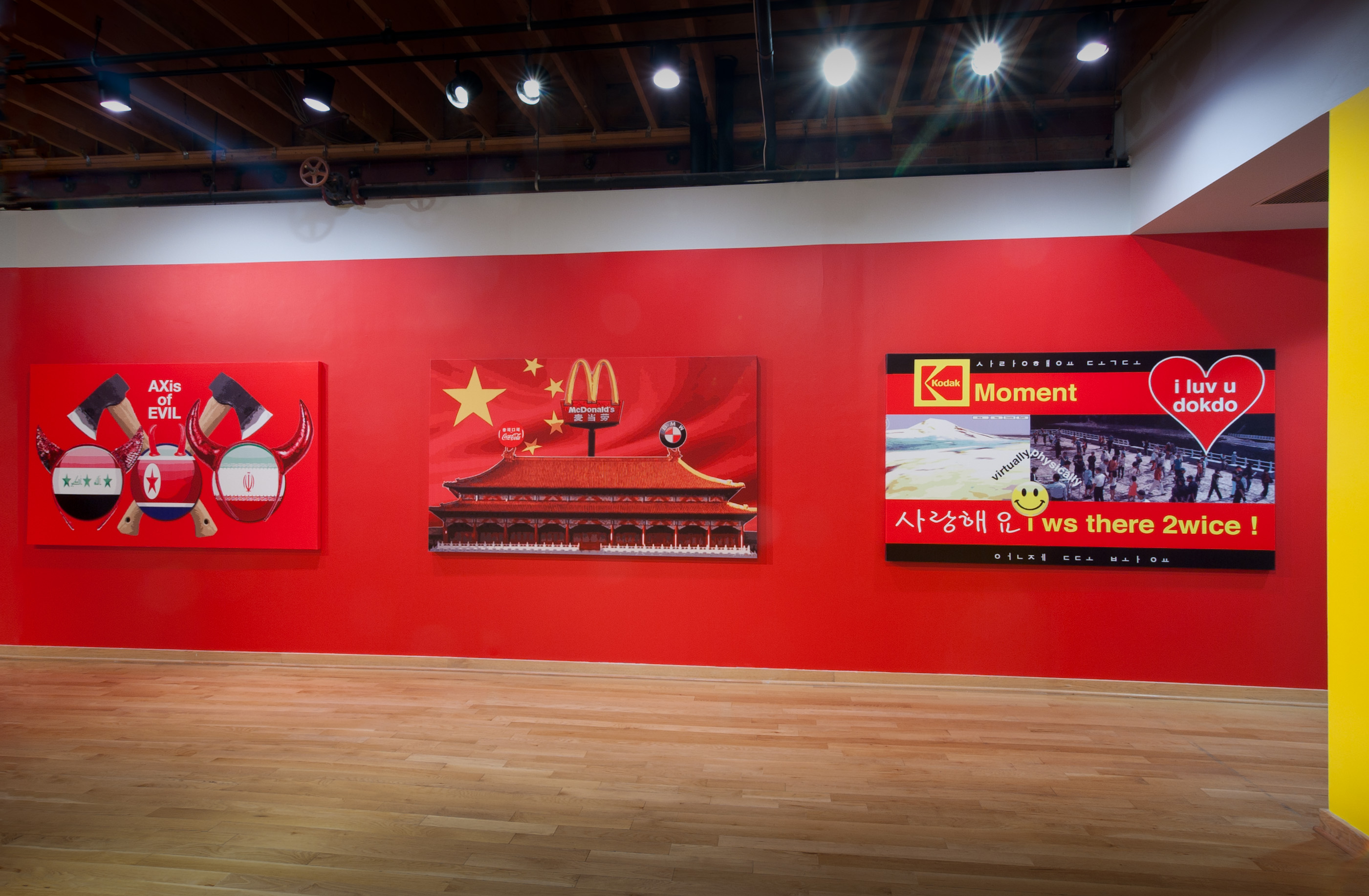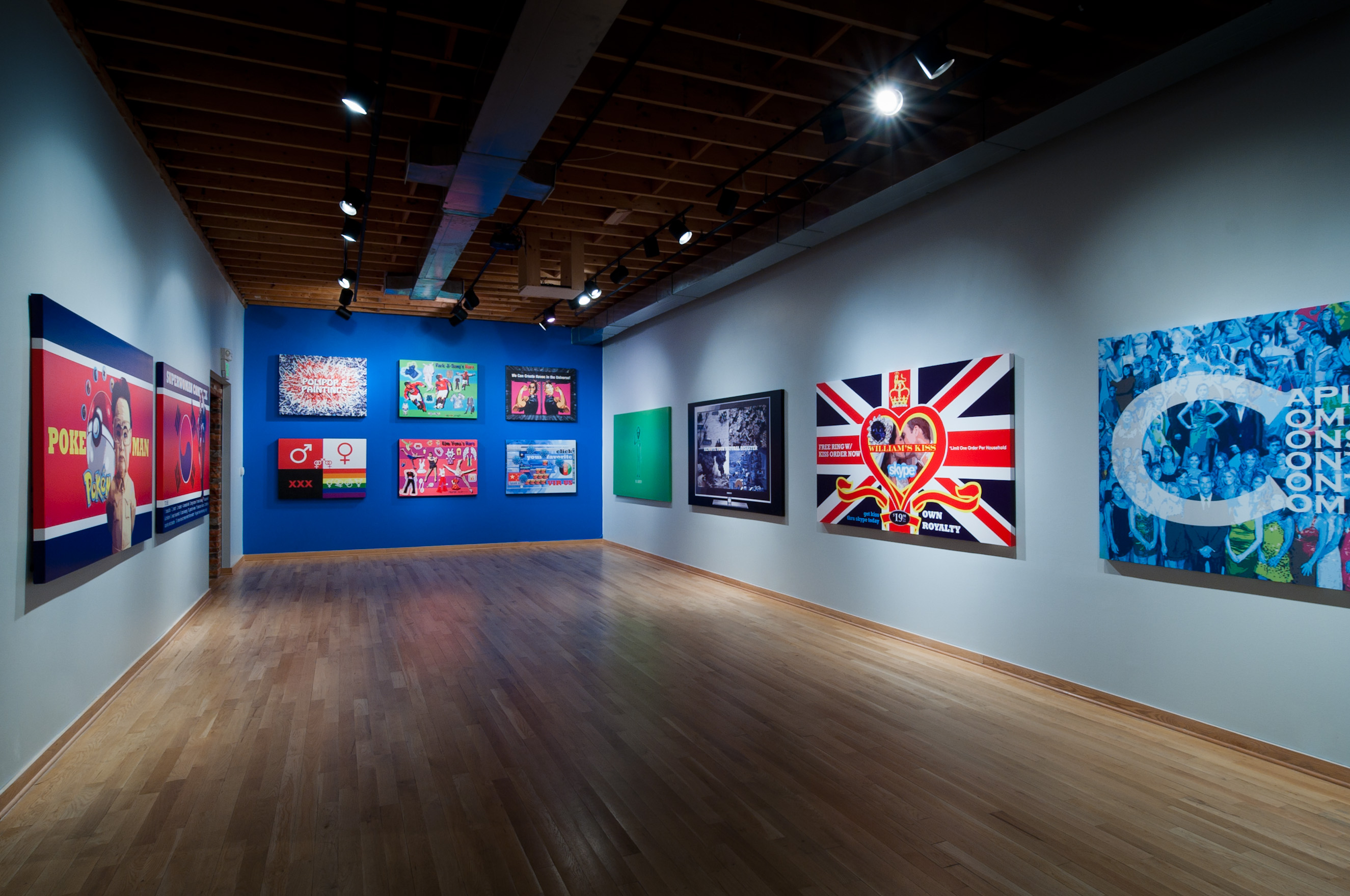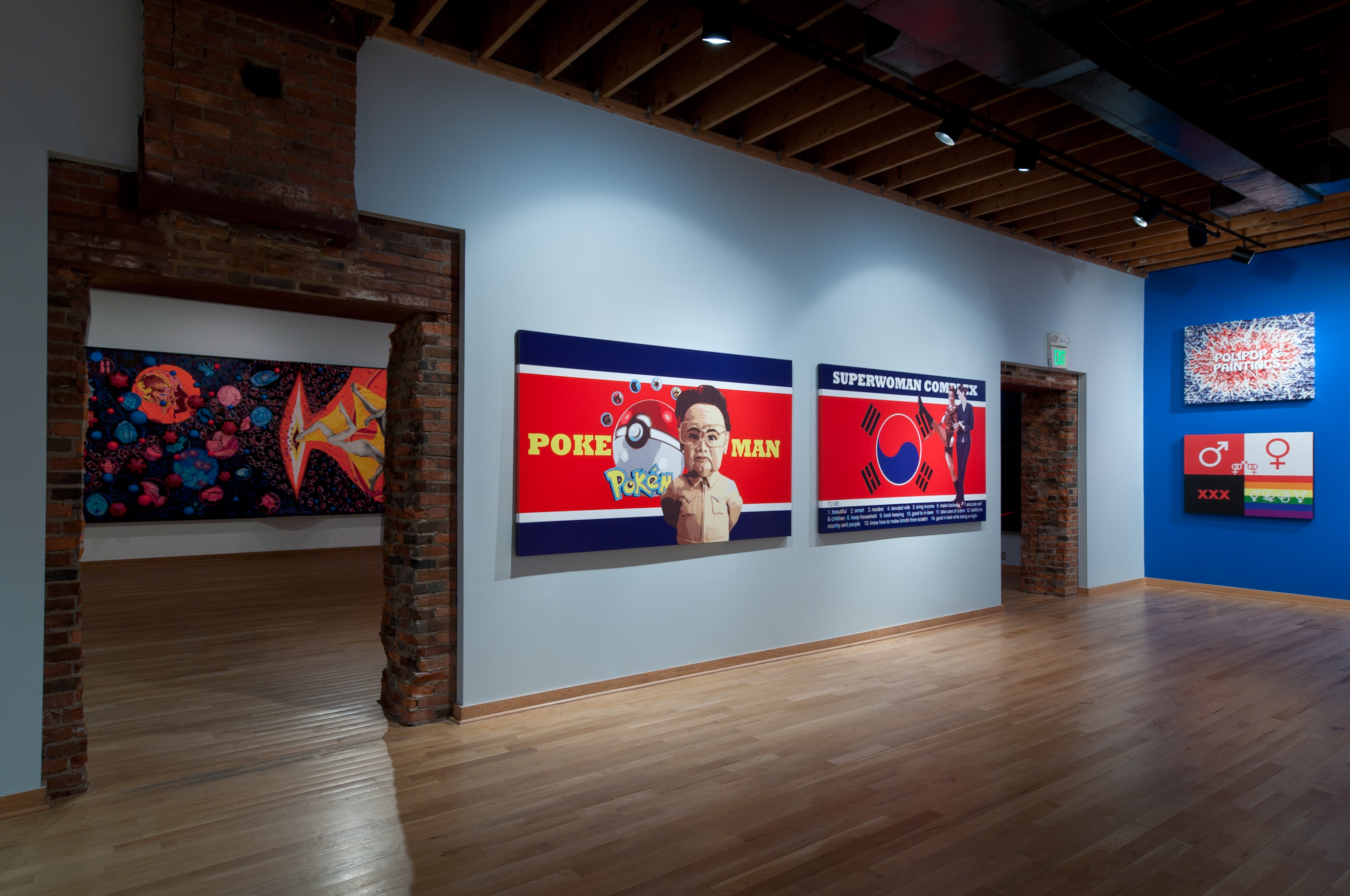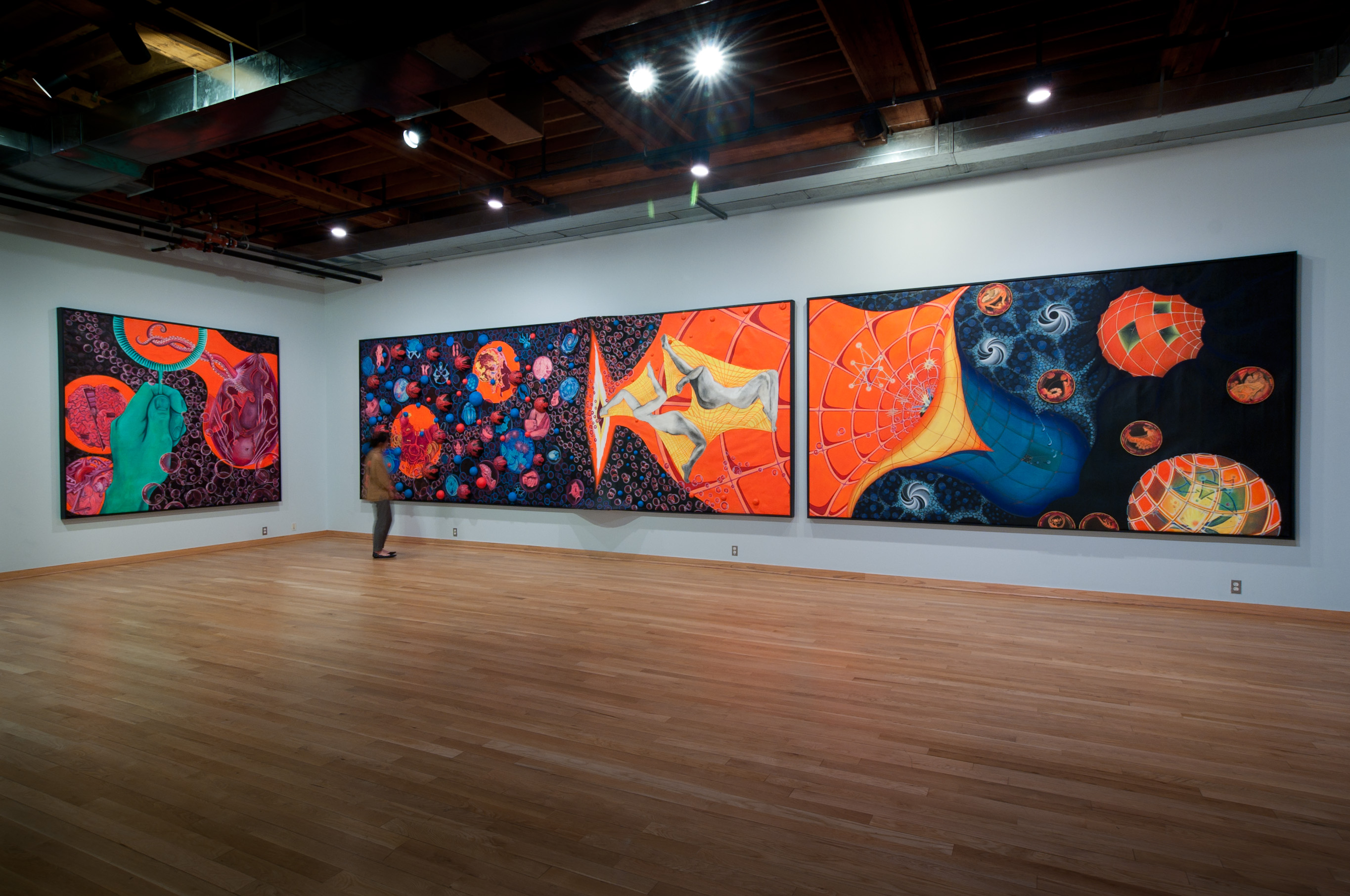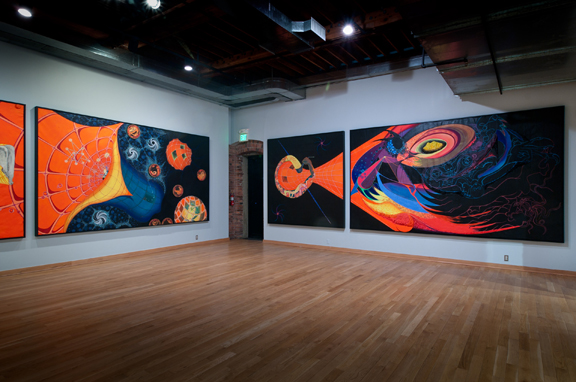About Mina

Mina Cheon (천민정) PhD, MFA -- "HAUNTED KOREAS"
b. 1973 in Seoul, South Korea, lives in New York,… more
HAUNTED KOREAS: Dreaming Unification Protest Peace
The traveling exhibition "Haunted Koreas: Dreaming Unification Protest Peace" showcases Mina Cheon's development of her most recent POLIPOP Art. Between 2019-2025, Cheon's series of new works have been exhibited at the Ethan Cohen Gallery, the Inaugural Asia Society Triennale, The Korea Society in New York, American University Museum, and Asian Arts & Cultural Center at Towson University. Each exhibition is newly curated and includes different and new works, it is an accumulative ongoing exhibition project.
ASIAN ARTS & CULTURAL CENTER TOWSON UNIVERSITY MARYLAND
HAUNTED KOREAS
Dreaming Unification Protest Peace
Mina Cheon with Kim Il Soon
February 12 – May 17 (closed March 17 – 22)
Monday – Saturday, 11 a.m. – 4 p.m.
Asian Arts Gallery, TU Center for the Arts
1 Fine Arts Drive, Towson, MD 21204
Opening Reception: Saturday, February 22, 5:30 – 6:30 p.m.
View the most extensive collection of global activist artist Mina Cheon’s series of “Unification Dream” paintings, a new perspective on the flags of a unified Korea. Each of these paintings, born from the artist’s stream of unconsciousness, is a powerful peace protest, shedding light on the intricacies of communication, love, and a shared vision of a harmonious future for North and South Korea. The call for unification within the Koreas is a concerted effort to desire peace on earth, because to dream for global peace is about healing and reconciliation of tempered worlds divided.
In her dream state, Cheon, along with her North Korean counterpart and art persona, Kim Il Soon, transcends physical borders and cultural boundaries. They enter a realm of imagination where dreaming is a powerful catalyst for envisioning a peaceful world. Her aspiration for peace in the Korean peninsula amidst escalated global warfare is to examine the complexities of ideological, political, economic, and religious divisions witnessed in everyday lives and to offer this call for global harmony that inspires us all as a form of cultural protest.
Artists Mina Cheon and/with Kim Il Soon are the creators of the provocative political pop art known as POLIPOP. This art form is not just visually accessible, but also inclusive by its invitation of the subject matter leaning towards peace for all. With its eye-catching, colorful “pop art” work, the art is layered by cultural comparative studies and inquiries into current global geopolitics. Wars are lucrative, and peace is an expensive endeavor. Using the rhetoric of pop art, the political statement is about unity and peace on earth, inviting everyone to be part of the conversation.
This exhibition is in part an extended version of Mina Cheon’s “Haunted Koreas,” which was her 2022 solo show at the American University Museum in Washington DC, with select pieces coming from the Inaugural 2020-2021 Asia Society Triennale and Cheon’s 2021 solo exhibition at the Korea Society, New York respectively.
OPENING RECEPTION + ARTIST TALK
Mina Cheon "HAUNTED KOREAS"
Saturday, February 22, 5:30 – 6:30 p.m.
Asian Arts Gallery & Atrium, TU Center for the Arts
1 Fine Arts Drive, Towson, MD 21204
Join Mina Cheon to explore the HAUNTED KOREAS: Dreaming Unification Protest Peace exhibition together and gain insights into how she creates art to advocate for positive change. Mina Cheon (PhD, MFA) is a global Korean new media artist, scholar, and educator who divides her time between Baltimore, New York, and Seoul, Korea. Born in Seoul to parents who were originally from the North, Cheon has never known a unified Korea. She has worked on North Korean awareness and global peace projects since 2004 and her specific focus on East Asia reflects the transgenerational trauma of Korea’s history, particularly division, war, and Japanese colonization. Co-sponsored by the Korean American Foundation – Greater Washington and the Baltimore Changwon Sister City Committee.
PERFORMANCE
Intersegmental 38 with the Baltimore Composers Forum
Saturday, February 22, 6:30 p.m.
Recital Hall, TU Center for the Arts
1 Fine Arts Drive, Towson, MD 21204
How do we cross over the border with music? How do we prompt unity? How do we compose global peace? This concert of works by diverse members of the Baltimore Composers Forum draws inspiration from Mina Cheon’s series of “Unification Dream” paintings. Pieces explore the idea of crossing over the 38th parallel which runs through and connects both Maryland and Korea (DMZ). Featured composers include Jin-Hwa Choi, Se-Yeon Oh, Anna Rubin, Ha-Eun Lee, Young-Wook Lee, Keith Kramer, Garth Baxter, Janice Macaulay, Gavin Brown, Ljiljana Becker, Ian Rashkin, and Ariyo Shahry. Featured performers include Ji Eun Kim (soprano), Soyeun Jung (gayageum), Youngik Jang (guitar), and Bonghee Lee (piano).
AMERICAN UNIVERSITY MUSEUM
Haunted Koreas Mina Cheon with Kim Il Soon
Presented by the Alper Initiative for Washington Art
September 10–December 11, 2022
South Korean new media artist Mina Cheon works for Korean unification with her North Korean alter ego counterpart, Kim Il Soon, through “asynchronous communication.” Crossing borders by sending and receiving art between North and South Korea, the artist brings the remnants of her global activism by sharing the recent works from the Inaugural Asia Society Triennial and The Korea Society in New York, respectively, between 2020 and 2021, as a comprehensive solo show for the Alper Initiative for Washington Art at the American University Museum in Washington, DC. The guiding exhibition text, “The History of a Paradoxical Incorporation,” by critical theorist Avital Ronell contextualizes the haunted Koreas and the artists' protest for peace.
“Cheon breaks into forbidden territory, a no man’s land—certainly a no-woman’s land—of contested sovereignty. She slips into No. Korean territory, and recedes back to So. Korean haunts in camouflage, be it as a secretive convoy of art historical teaching or in roguish disguise, as one of “them.” Thus her deliberate misappropriations of propagandistic iconography sometimes simulate adherence to an opponent’s claims, switching up cues of politically coded assumptions and the righteous bullet points of human rights advocacy. The work attracts a riot of controversy that secretly targets the heart of a dilemma, an ambivalence shared by many who cannot choose sides, yet must choose sides, living in the tensional structure of division, asymmetrically apportioned.”
— Avital Ronell
The exhibition was made possible with the 2021 AHL – Andrew & Barbara Choi Family Foundation Grant Award. With great thanks to the Ethan Cohen Gallery, Waterfall Mansion and Gallery, The Korea Society, and Asia Society Museum of New York for supporting the artist in the works displayed in the exhibition. And a special thank you to the courageous North Korean defectors around the world and in South Korea.
Artist & Philosopher Bios
Mina Cheon (천민정) (b. 1973, Seoul, South Korea; lives and works in Baltimore, New York, and Seoul)
Mina Cheon is a new media artist, scholar, educator, and activist best known for her “Polipop” paintings inspired by pop art and social realism. Cheon’s practice draws inspiration from the partition of the Korean Peninsula, exemplified by her parallel body of work created under her North Korean alter ego, Kim Il Soon, in which she enlists a range of mediums, including painting, sculpture, video, installation, and performance to deconstruct and reconcile the precarious history — and ongoing coexistence — between North and South Korea. She has exhibited internationally, including at the Inaugural Asia Society Triennial (2020-2021); Busan Biennale (2018); Baltimore Museum of Art (2018); American University Museum at the Katzen Arts Center, Washington, DC (2014); Sungkok Art Museum, Seoul (2012); and Insa Art Space, Seoul (2005). Her work is in the collections of the Baltimore Museum of Art; Smith College Museum of Art, Northampton; and Seoul Museum of Art, Seoul. Mina Cheon’s solo exhibitions include those at the Ethan Cohen Gallery (2014, 2017-18, 2020-2021), the Lance Fung Gallery (2002), and The Korea Society (2021) in New York; the Noyes Museum of Art of Stockton University in New Jersey (2018); the Trunk Gallery (2014), Sungkok Art Museum (2012), and Insa Art Space (2004-5) in Seoul, Korea; and the Maryland Art Place (2012) and C. Grimaldis Gallery (2008) in Baltimore. Currently an Associate Dean, Undergraduate Studies at the Maryland Institute College of Art (MICA), Cheon has been a full-time professor at MICA since 2004. Under the guidance of dissertation advisor Avital Ronell, she received her PhD in Philosophy of Media and Communications from the European Graduate School, European University for Interdisciplinary Studies, Switzerland, and adapted her dissertation into a book, Shamanism + Cyberspace (Dresden and New York: Atropos Press, 2009). She also received her MFA in Imaging Digital Arts from UMBC: An Honors University in Maryland; an MFA from the Hoffberger School of Painting, MICA; and a BFA in painting from Ewha Womans University, Seoul, Korea.
A recipient of numerous prizes, Avital Ronell is University Professor of the Humanities at New York University, and teaches philosophy and media at the European Graduate School in Switzerland. She has delivered lecture performances at the Centre Pompidou and the Théâtre de l'Odéon in Paris, and at Hau3 in Berlin. Recent works include Complaint: Grievance among Friends (University of Illinois Press, 2018) and Burnout der Autorität (Frankfurt: Vittorio Klostermann, translator Peter Trawny, 2020), "An Addictionary of Violence" (Counterpunch), “The Gestell from Hell” (The Oxford Literary Review), “The Next Level: Erasures and Rollbacks” (Modern Language Notes), and the "Survival Kit for the Anguished" podcast series from Philomonaco’s “Rencontres philosophiques.”
MINA CHEON @ THE ASIA SOCIETY IN NEW YORK, THE INAUGURAL ASIA SOCIETY TRIENNALE
Underlying the Triennial is our belief in the power of art: its innate ability to embrace the paradoxes and contradictions of our increasingly complex global society while retaining the capacity to illuminate the thread of our shared humanity.
The presence of art shows that we are never alone in life and our dreams. We invite you to dream with us.
Boon Hui Tan
Founding Artistic Director and Cocurator, Asia Society Triennial
THE KOREA SOCIETY IN NEW YORK
Mina Cheon: Dreaming Unification/Protest Peace
The global art activist Mina Cheon draws inspiration from the partition of the Korean peninsula, exemplified by her parallel body of work created under her North Korean alter ego, Kim Il Soon, in which she enlists a range of mediums including painting, sculpture, video, installation, and performance to deconstruct and reconcile the fraught history and ongoing coexistence between North and South Korea. Her solo exhibition at The Korea Society, presented during the height of #stopasianhate movement and continuing tensions on Korean peninsula, showcases her most recent painting series of Unification Flags.
Tapping into her stream of unconsciousness to promote a future of unity and peace, Mina Cheon's paintings of the Korean peninsula recalls past interKorean efforts including the Olympics, athletic teamwork, Arirang Mass Games, and other public events that celebrated “One Korea.” Submerged in the custom-made IKB (Yves Klein blue) paint and incorporating the cosmopolitan expression of protest art style using stencil and spray, each Unification Flag painting is a symbolic new figuration, a body that parades in a procession for peace.
Ethan Cohen Gallery
251 West 19th Street, New York, NY
Exhibition Dates: December 10, 2020 – January 30, 2021
“Dreaming unification is protesting peace as the new global condition.”
Ethan Cohen Gallery is honored to present Mina Cheon aka Kim Il Soon’s solo exhibition “Dreaming Unification : Protest Peace.” As we face our challenging times with the coronavirus pandemic and a stressful post-election, our countries remain divided. Today’s resounding words from the US President-elect Joe Biden are “not to divide, but to unify.” And, we do this with our social consciousness intact, with social justice and anti-racism efforts in the forefront, while dreaming unification and protesting for peace.
Art for Life, Masks On!
From the divided Koreas to the divided United States of America, desiring peace “over-there” echoes desiring peace “over-here.” Living in pandemic times, art must continue as a banner of hope and as an essential in life.
In her dream world, artist Mina Cheon's North Korean art persona, aka "Kim Il Soon," paints the Korean national third flag, the Unification Flag, in a new body of work of flag figurations, Dreaming Unification : Protest Peace painting series. Tapping into her stream of unconsciousness to promote a future of unity and peace, flags are raised in this exhibition to recall past interKorean efforts including the Olympics, athletic teamwork, Arirang Mass Games, and other public events that celebrated “One Korea.” This is done as a protest for peace in contrast to the discouraging chaos and canceled peace talks in the Peninsula. New spectacles arise with ongoing threats from North Korea with the blowing up of InterKorean Liaison Office building at Kaesong on June 16th and the 75th Anniversary Worker’s Party military celebration on October 10th parading new ICBMs just this year 2020.
From a series of 20 pieces completed in 2019, shared in 2020, submerged in the custom-made New IKB (Yves Klein Blue) paint, using stencil, spray, sumi ink on canvas, each flag painting is a symbolic new figuration, a body that parades in a procession for peace. At the gallery, these Unification Flags pose as figures floating in space and centering the 10 x 5 feet symphonic triptych, where East meets West in the stormy “Dreaming Unification: Protest Peace (Triptych Flag Figuration East Meets West, Joseonhwa Protest Art).”
For the past decade, Kim Il Soon has been painting in the socialist realism propaganda style, hot pink drip abstract expressionism, and in New IKB dip conceptual paintings (with custom-paint inspired by Yves Klein’s International Klein Blue). As she masters Western art styles and dreams for liberation within the canvas as well as from the North Korean regime, the new series as “protesting peace” is done with stencils and spray paint and sumi ink, hitting the cord of North Korean most revered painting style, Joseonhwa (sumi ink, rice paper hanji, traditional oriental painting technique applied to North Korean propaganda contents) and the cosmopolitan expression of protest art style using stencil, spray, tagging.
Another exclusive viewing in the exhibition is from Cheon’s personal art collection, a 2019 painting by an anonymous North Korean painter. In the hands of the artist, Cheon took the liberty to extend the subtitle, “North-South Declaration of Partnership: Standing before the Unification Flag” based on the visuals and literature that writes, “We, people(s) must stand in our confirmed stance with respect and sincerity towards declaring partnership.” This painting represents the ongoing asynchronic communication between the artist and the North Koreans and that dreaming unification is from both sides of the Koreas.
Since 2017, with the support of North Korean defector communities in South Korea, Cheon’s “Video Art History Lessons by Professor Kim” have gone into North Korea in media drives, possibly being the very first contemporary video art screened in North Korean homes. The videos in notel players will be showcased in Cheon’s participation at the inaugural Asia Society Triennial “We Do Not Dream Alone” October 27, 2020 – June 27, 2021, with her art installation in the part two opening March 16, 2021. The videos were first exhibited at the Ethan Cohen Gallery in 2017-2018 and after at the Busan Bienniale 2018 in South Korea, along with Cheon’s most culturally recognized “peace offering,” Eat Chocopie Together, a 100,000 Chocopies installation for the audience to eat for the sake of art and healing. Cheon aka Kim has dedicated her art to North Korean defectors around the world.
While the North Korean hermit kingdom announces its presence by blowing up the Liaison Office at Kaesong and continues to strong-arm nuclear arsenals, we know this much, there are citizens who desire communication with the outside world and risk their lives for basic human rights such as access to information and foreign media. Artist Mina Cheon’s exhibition responds to all Koreans, and highlights the demand for peace in a form of a “protest” in oppositional language to a “rally.” Please join in the efforts and view her new body of work that is about global dreaming for unification and protesting peace for surviving the chaos and strain of our daily lives.
-
 Haunted Koreas Mina Cheon with Kim Il Soon - American University Museum, Washington DC (2022)
Haunted Koreas Mina Cheon with Kim Il Soon - American University Museum, Washington DC (2022)Haunted Koreas Mina Cheon with Kim Il Soon - American University Museum, Washington DC (2022)
-
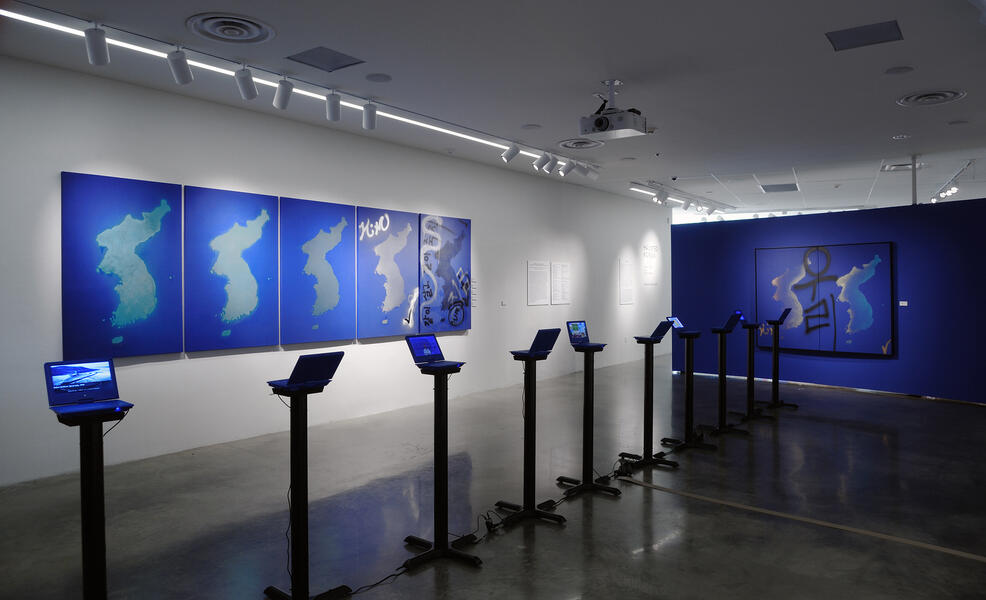 Haunted Koreas Mina Cheon with Kim Il Soon - American University Museum, Washington DC (2022)
Haunted Koreas Mina Cheon with Kim Il Soon - American University Museum, Washington DC (2022)Haunted Koreas Mina Cheon with Kim Il Soon - American University Museum, Washington DC (2022)
-
 Haunted Koreas Mina Cheon with Kim Il Soon - American University Museum, Washington DC (2022)
Haunted Koreas Mina Cheon with Kim Il Soon - American University Museum, Washington DC (2022)Haunted Koreas Mina Cheon with Kim Il Soon - American University Museum, Washington DC (2022)
-
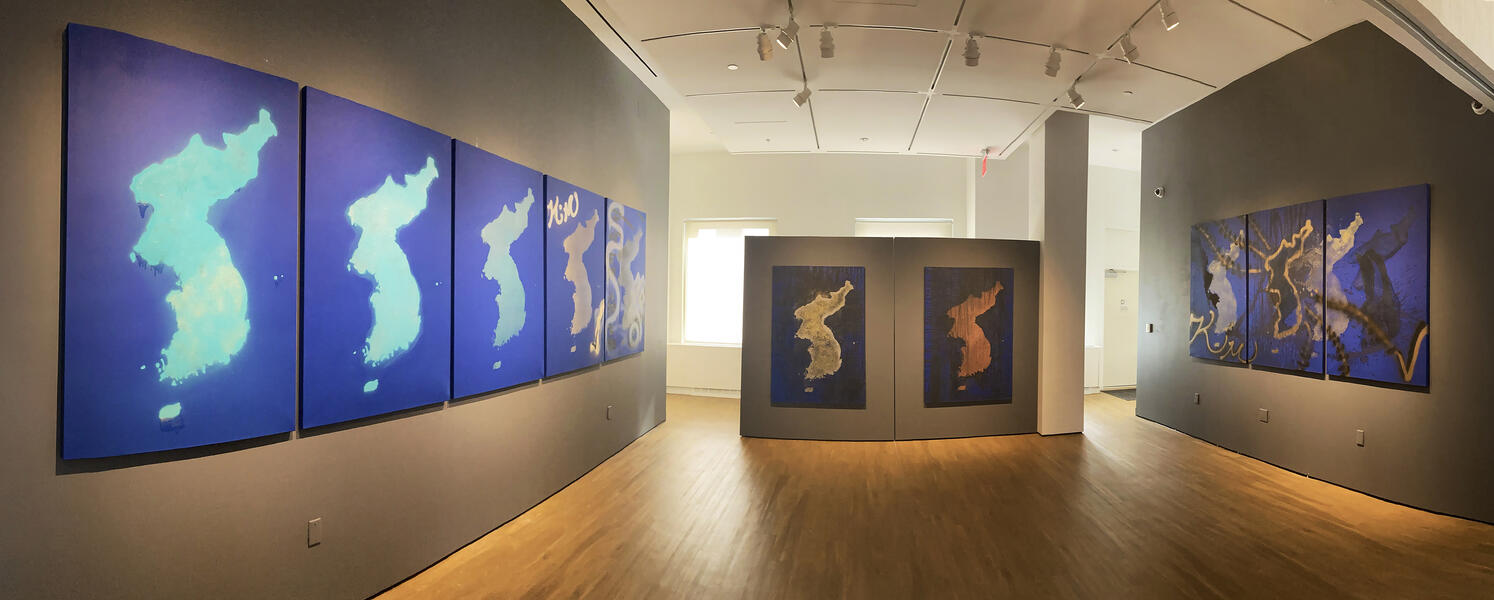 Mina Cheon @ The Korea Society, New York (2020-2021)
Mina Cheon @ The Korea Society, New York (2020-2021)Mina Cheon @ The Korea Society, New York (2020-2021)
-
 Mina Cheon @ The Inaugural Asia Society Triennale, The Asia Society New York (2020-2021)
Mina Cheon @ The Inaugural Asia Society Triennale, The Asia Society New York (2020-2021)Mina Cheon @ The Inaugural Asia Society Triennale, The Asia Society New York (2020-2021)
-
 Gallery view of the show "Dreaming Unification : Protest Peace" Ethan Cohen Gallery in New York
Gallery view of the show "Dreaming Unification : Protest Peace" Ethan Cohen Gallery in New York -
 Image of a series of Korean Unification flags.jpgIn this show "Dreaming Unification : Protest Peace" at the Ethan Cohen Gallery in New York, the Korean unification flags cascade like figures in a parade and they were painted to promote One Korea during a time when the USA also seems most divided. The show, Dreaming Unification Protest Peace, is a reflection on the Koreas and the political climate and culture wars of America, with protesting for peace as a path forward and cultural healing. Mina Cheon aka Kim Il Soon, painting series hung from left to right. Each created with New IKB (custom-made Yves Klein's International Klein Blue) paint, stencil, spray paint on canvas, 40 x 60 x 1.5 inches. 2019-2020. Dreaming Unification #4: Protest Peace aka Flag Figuration #4 (United Copper Eros) Dreaming Unification #2: Protest Peace aka Flag Figuration #2 (One Land, Flat Plane) Dreaming Unification #3: Protest Peace aka Flag Figuration #3 (One Korea, Land and Water) Dreaming Unification #8: Protest Peace aka Flag Figuration #8 (Kim ✓) Dreaming Unification #9: Protest Peace aka Flag Figuration #9 (Let’s Live and Die Together Now“같이 살고 죽자 지금”)
Image of a series of Korean Unification flags.jpgIn this show "Dreaming Unification : Protest Peace" at the Ethan Cohen Gallery in New York, the Korean unification flags cascade like figures in a parade and they were painted to promote One Korea during a time when the USA also seems most divided. The show, Dreaming Unification Protest Peace, is a reflection on the Koreas and the political climate and culture wars of America, with protesting for peace as a path forward and cultural healing. Mina Cheon aka Kim Il Soon, painting series hung from left to right. Each created with New IKB (custom-made Yves Klein's International Klein Blue) paint, stencil, spray paint on canvas, 40 x 60 x 1.5 inches. 2019-2020. Dreaming Unification #4: Protest Peace aka Flag Figuration #4 (United Copper Eros) Dreaming Unification #2: Protest Peace aka Flag Figuration #2 (One Land, Flat Plane) Dreaming Unification #3: Protest Peace aka Flag Figuration #3 (One Korea, Land and Water) Dreaming Unification #8: Protest Peace aka Flag Figuration #8 (Kim ✓) Dreaming Unification #9: Protest Peace aka Flag Figuration #9 (Let’s Live and Die Together Now“같이 살고 죽자 지금”) -
 Triptych Flag Figuration East Meets West, Joseonhwa Protest ArtMina Cheon aka Kim Il Soon, Dreaming Unification: Protest Peace (Triptych Flag Figuration East Meets West, Joseonhwa Protest Art), 2019-2020, created with New IKB (Yves Klein Blue) paint, stencil, spray paint, sumi ink on canvas. 10 x 5 feet triptych, 40 x 60 x 1.5 inches each. In her dream world, artist Mina Cheon's North Korean art persona, aka "Kim Il Soon," paints the Korean national third flag, the Unification Flag, in a new body of work of flag figurations, Dreaming Unification : Protest Peace painting series. Tapping into her stream of unconsciousness to promote a future of unity and peace, flags are raised in this exhibition to recall past interKorean efforts including the Olympics, athletic teamwork, Arirang Mass Games, and other public events that celebrated “One Korea.” This is done as a protest for peace in contrast to the discouraging chaos and canceled peace talks in the Peninsula. From a series of 20 pieces completed in 2019, shared in 2020, submerged in the custom-made New IKB (Yves Klein Blue) paint, using stencil, spray, sumi ink on canvas, each flag painting is a symbolic new figuration, a body that parades in a procession for peace. At the gallery, these Unification Flags pose as figures floating in space and centering the 10 x 5 feet symphonic triptych, where East meets West in the stormy “Dreaming Unification: Protest Peace (Triptych Flag Figuration East Meets West, Joseonhwa Protest Art).” While the North Korean hermit kingdom announces its presence by blowing up the Liaison Office at Kaesong and continues to strong-arm nuclear arsenals, we know this much, there are citizens who desire communication with the outside world and risk their lives for basic human rights such as access to information and foreign media. Artist Mina Cheon’s exhibition responds to all Koreans, and highlights the demand for peace in a form of a “protest” in oppositional language to a “rally.” Please join in the efforts and view her new body of work that is about global dreaming for unification and protesting peace for surviving the chaos and strain of our daily lives.
Triptych Flag Figuration East Meets West, Joseonhwa Protest ArtMina Cheon aka Kim Il Soon, Dreaming Unification: Protest Peace (Triptych Flag Figuration East Meets West, Joseonhwa Protest Art), 2019-2020, created with New IKB (Yves Klein Blue) paint, stencil, spray paint, sumi ink on canvas. 10 x 5 feet triptych, 40 x 60 x 1.5 inches each. In her dream world, artist Mina Cheon's North Korean art persona, aka "Kim Il Soon," paints the Korean national third flag, the Unification Flag, in a new body of work of flag figurations, Dreaming Unification : Protest Peace painting series. Tapping into her stream of unconsciousness to promote a future of unity and peace, flags are raised in this exhibition to recall past interKorean efforts including the Olympics, athletic teamwork, Arirang Mass Games, and other public events that celebrated “One Korea.” This is done as a protest for peace in contrast to the discouraging chaos and canceled peace talks in the Peninsula. From a series of 20 pieces completed in 2019, shared in 2020, submerged in the custom-made New IKB (Yves Klein Blue) paint, using stencil, spray, sumi ink on canvas, each flag painting is a symbolic new figuration, a body that parades in a procession for peace. At the gallery, these Unification Flags pose as figures floating in space and centering the 10 x 5 feet symphonic triptych, where East meets West in the stormy “Dreaming Unification: Protest Peace (Triptych Flag Figuration East Meets West, Joseonhwa Protest Art).” While the North Korean hermit kingdom announces its presence by blowing up the Liaison Office at Kaesong and continues to strong-arm nuclear arsenals, we know this much, there are citizens who desire communication with the outside world and risk their lives for basic human rights such as access to information and foreign media. Artist Mina Cheon’s exhibition responds to all Koreans, and highlights the demand for peace in a form of a “protest” in oppositional language to a “rally.” Please join in the efforts and view her new body of work that is about global dreaming for unification and protesting peace for surviving the chaos and strain of our daily lives. -
 Global Peace Shoes. "Can't Move Forward Without the Other"In Pyongyang this September, the South Korean President Moon Jae-in spoke to the North Koreans about reunification and how “We had lived together for 5,000 years, but apart for just 70 years…” – It’s time to walk the extra mile for unity and peace. He also walked the Mt. Paekdu with Kim Jong-un. As a global Korean political pop artist, who makes art known as "Polipop," Mina Cheon (aka North Korean Kim Il Soon) presents this pair of "Global Peace Shoes” to promote Korean unification and global peace. Also known as "Reconciliation Shoes" or "Unification Shoes," the shoe project is a part of her ongoing global art activism work that advocates for positive change, especially supporting loving exchanges between North and South Korea to impact peace on earth. Join the artist today by Sharing, Following, Favoriting, Liking, or Walking the Peace Shoes. #minacheonstudio The Global Peace Shoes project brings awareness about the Koreas and its relationship with the world, and how steps towards end of war, cooperation, and unification can help shape the future of global peace. Artist Mina Cheon believes that the day of crossing the DMZ in these shoes is not far away, and by walking in them today means participating in the global performance of – stepping forward together, united, one foot at a time – towards peace. And, that we can’t walk or move forward together without the other.
Global Peace Shoes. "Can't Move Forward Without the Other"In Pyongyang this September, the South Korean President Moon Jae-in spoke to the North Koreans about reunification and how “We had lived together for 5,000 years, but apart for just 70 years…” – It’s time to walk the extra mile for unity and peace. He also walked the Mt. Paekdu with Kim Jong-un. As a global Korean political pop artist, who makes art known as "Polipop," Mina Cheon (aka North Korean Kim Il Soon) presents this pair of "Global Peace Shoes” to promote Korean unification and global peace. Also known as "Reconciliation Shoes" or "Unification Shoes," the shoe project is a part of her ongoing global art activism work that advocates for positive change, especially supporting loving exchanges between North and South Korea to impact peace on earth. Join the artist today by Sharing, Following, Favoriting, Liking, or Walking the Peace Shoes. #minacheonstudio The Global Peace Shoes project brings awareness about the Koreas and its relationship with the world, and how steps towards end of war, cooperation, and unification can help shape the future of global peace. Artist Mina Cheon believes that the day of crossing the DMZ in these shoes is not far away, and by walking in them today means participating in the global performance of – stepping forward together, united, one foot at a time – towards peace. And, that we can’t walk or move forward together without the other. -
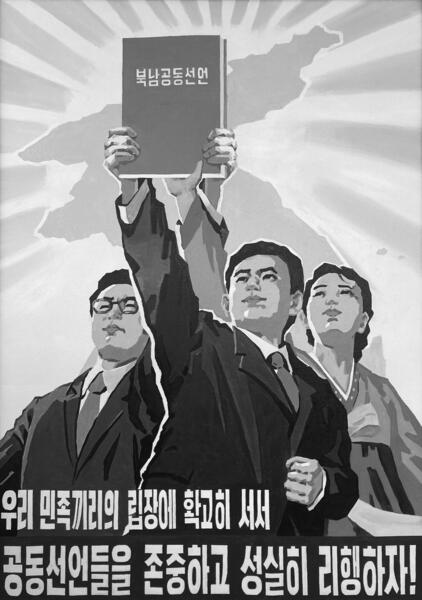 Unification Flag by anonymous North Korean painter 2019North-South Declaration of Partnership: Standing before the Unification Flag Translation: “We, people(s) must stand in our confirmed stance with respect and sincerity towards declaring partnership.” Anonymous North Korean painter, 2009 Oil on canvas Another exclusive viewing in the exhibition is from artist Mina Cheon’s personal art collection, a 2019 painting by an anonymous North Korean painter. In the hands of the artist, Cheon took the liberty to extend the subtitle, “North-South Declaration of Partnership: Standing before the Unification Flag” based on the visuals and literature that writes, “We, people(s) must stand in our confirmed stance with respect and sincerity towards declaring partnership.” This painting represents the ongoing asynchronic communication between the artist and the North Koreans and that dreaming unification is from both sides of the Koreas. “North-South Declaration of Partnership: Standing before the Unification Flag,” oil on canvas by an anonymous North Korean painter, 23” x 33”, 2019, titled by artist Mina Cheon, owner of the painting. North Korean text translation: “We, people(s) must stand in our confirmed stance with respect and sincerity towards declaring partnership.” Artist Mina Cheon releases only black and white photos of her North Korean art collection so that visitors can see it in color in person.
Unification Flag by anonymous North Korean painter 2019North-South Declaration of Partnership: Standing before the Unification Flag Translation: “We, people(s) must stand in our confirmed stance with respect and sincerity towards declaring partnership.” Anonymous North Korean painter, 2009 Oil on canvas Another exclusive viewing in the exhibition is from artist Mina Cheon’s personal art collection, a 2019 painting by an anonymous North Korean painter. In the hands of the artist, Cheon took the liberty to extend the subtitle, “North-South Declaration of Partnership: Standing before the Unification Flag” based on the visuals and literature that writes, “We, people(s) must stand in our confirmed stance with respect and sincerity towards declaring partnership.” This painting represents the ongoing asynchronic communication between the artist and the North Koreans and that dreaming unification is from both sides of the Koreas. “North-South Declaration of Partnership: Standing before the Unification Flag,” oil on canvas by an anonymous North Korean painter, 23” x 33”, 2019, titled by artist Mina Cheon, owner of the painting. North Korean text translation: “We, people(s) must stand in our confirmed stance with respect and sincerity towards declaring partnership.” Artist Mina Cheon releases only black and white photos of her North Korean art collection so that visitors can see it in color in person.
Eat Chocopie Together (.com)
HISTORY OF CHOCOPIES
Chocopies, a South Korean confectionary, became one of the most desirable consumer products in North Korea, ever since they were gifted by South Korean workers to their peers from the North at the jointly managed Kaesong Industrial Complex. South Korean activists even used helium balloons to launch thousands of Chocopies over the DMZ border into North Korea, some with messages of love and care. It has thus become a cultural symbol of Korean compassion and cooperation.
EATING CHOCOPIE TOGETHER, VIRTUALLY
For Korean artist Mina Cheon, the symbolic gesture of eating Chocopie represents “taking a bite for peace.” In addition to the physical “Eat Chocopie Together” art installation in 2021 for the inaugural Asia Society Triennial (October 27, 2020 - June 27, 2021), this website presents a special virtual version as a part of the Triennial. While in the past, Cheon's "Eat Chocopie Together" was about physically eating it onsite at the exhibition, the virtual chocopie strengthens the focus of sharing it together virtually for the sake of love, peace, and unity... leading up to the actual installation before the end of the Triennial where everyone is welcomed. The virtual Chocopie sharing also helps raise automatic funds to help those in need during our time of the pandemic crisis.
Responding to the socially distant conditions of our time and the global devastation of the COVID-19 pandemic at a time where compassion and humanity is much needed for healing, this initiative hopes to allow anyone, from anywhere, to extend love and peace in the time of the Coronavirus by virtually sharing and enjoying Chocopies with friends, families, and loved ones. There are five different Chocopie designs specially created by the artist to represent important aspects of this virtual exchange: LOVE, PEACE, SHARE, EAT, UNITE. For the artist, the message of inter-Korean peace extends to America.
GIVING BACK TO THE COMMUNITY
UPDATE: October 2020 - We have achieved our campaign goal! Thank you to all who participated. This "Eat Chocopie Together" website will remain active, so please continue to share Chocopies.
"KACF was delighted to support and partner with the Asia Society Triennial and its digital initiative: Eat Chocopie Together by the Korean artist Mina Cheon. Ms. Cheon's intent to build a sense of community through this exhibition and deliver a message of love and kindness resonated deeply with us and the Korean American community, particularly during these uncertain times. We are also grateful to the Asia Society and Ms. Cheon for selecting KACF as a recipient of its EastChocopieTogether charitable campaign. The $5000 donation to our COVID-19 Community Action Fund will help low-income families in their long journey toward recovery. These are challenging times but Ms. Cheon's digital exhibit helped to show that people's hearts are still full kindness and generosity."
- Brennan Gang
Deputy Director & Director of Programs
Korean American Community Foundation
“Eat Chocopie Together” is also a crowdsourcing charity campaign where the participation from the public alone generates an automatic donation: for each Chocopie shared between two friends, $2 will be donated in their names to the non-profit charity, the Korean American Community Foundation COVID-19 Community Action Fund, up to a total of $5,000. An anonymous donor has already made a generous pledge to support.
In March, the Korean American Community Foundation launched their COVID-19 Community Action Fund to provide immediate and long-term support to their nonprofit partners, organizations that are working in the frontline of this pandemic to provide essential services to the most vulnerable Korean Americans. The funds will be used to spearhead urgent relief efforts for individuals and families affected by COVID-19, including Korean language assistance in completing unemployment and small business applications, increased domestic violence counseling, meal delivery, a Korean language COVID-19 health hotline, mental health support, emergency cash assistance for those excluded from federal emergency payments, and shelter for homeless Korean Americans. With the funds, KACF will also support the important work to address growing anti-Asian racism in our community. Learn more about the charity fund here.
"Eat Chocopie Together" is made possible by the generosity of the Korea Foundation, and an anonymous donor to the Korean American Community Foundation.
ABOUT THE ARTIST
Mina Cheon (천민정 PhD, MFA) is a global Korean new media artist, scholar, and educator who divides her time between Korea and the United States. Cheon has exhibited her political pop art known as “Polipop” internationally and draws inspiration from global media and popular culture to produce work that intersects politics and pop art in evocative ways. While she creates work that ranges in medium from new media, video, installation, performance, and public projects to traditional media of painting and sculptures, the content of the work is in historic alignment to appropriation art and global activism art. Cheon is currently a Full-time Professor at the Maryland Institute College of Art (MICA) in Baltimore, Maryland.
Cheon’s thematic focus includes geopolitical and contested spaces, race culture and postcolonialism, and Asia’s relationship to the Western world in global media culture and reflects the transgenerational trauma of Korea’s history, of its division and war and of Japanese colonization. Having parents originate from the North and herself part of the Korean global diaspora, Cheon’s art results from a life-time of working with a cultural comparative lens and understanding Asia through its power relations with the world. In particular, she has worked on North Korean awareness, Korean unification and reconciliation efforts, and global peace projects since 2004.
As an artist, while assuming different artistic pseudonyms for the past twenty years such as Minaliza1000, M-1000, Jae Son, Cheon’s latest avatar and alter ego is a North Korean artist named KIM IL SOON who made her first international public appearance at the Pulse Art Fair NY in 2013.
Cheon's states, "As a Korean, the idea of having two artistic identities, South Korean Mina Cheon and North Korean Kim Il Soon, is an obvious reflection on the country’s state of being divided. It makes all the sense in the world that if a country is split so should the artist in practice."
While Cheon’s “Video Art History Lessons by Professor Kim” has been sent into North Korea since 2017 by USB drives and SD cards, the chocopie installation promotes her global artistic activism to bring awareness about the state of Koreas that has been working towards peace. “Eat Chocopie Together” became a national sensation when it was featured at the 2018 Busan Biennale in Korea; even the South Korean President Moon Jae-in and First Lady Kim Jung-sook visited to eat Chocopie together amidst Korea’s media buzz and slogan for “A New Future” of Korea. Learn more about Mina Cheon at her website.
Korean-American new media artist Mina Cheon’s signature art piece for “Korean unification” Eat Choco·Pie Together is featured at the 2018 Busan Biennale that focuses on the theme of divided territories “Divided We Stand” curated by a dynamic international curator and critic team Cristina Ricupero and Jorg Heiser. Kindly donated by the Orion Co., 100,000 Choco·Pies will be installed on the floor of Museum of Contemporary Art (MoCA) Busan for the audience to eat during the entire exhibition duration. The piece calls all North Korean defectors in South Korea to come "Eat Choco·Pie Together."
"EAT CHOCOPIE TOGETHER" TAKE A BITE FOR PEACE, ART FOR HEALING, KOREAS UNITE!On September 14, the Korean President Moon Jae-in and the First Lady Kim Jung-sook came to Eat Choco·Pie Together, participating in the art by "taking a bite for peace."
The artist Mina Cheon (천민정) explained to the President, that "the art is meant for the audience to eat for the sake of healing divided Korea" and requested if he would do the honor to Eat Choco·pie Together for Korean unification and global peace. The First Lady was the first to pick one up and they both participated in the interactive art, demonstrating their loving support for "a new beginning (새로운 시작) and love (Jung 情) between the two Koreas" as those words are written in Chinese and Korean on each individual wrappers. Moon and Kim's meeting today is highlighted with a ringing media slogan of "A New Future" for our Koreas, with hope for building peace and prosperity in our peninsula.
Background Why ChocoPies Matters
Currently the most desired snack in North Korea, the Choco·Pie was first introduced during the joint labor force at the Kaesung Industrial Complex when South Koreans gave Choco·Pie as a token of appreciation. The snack became an overnight number one smuggled good and South Koreans fervently sent Choco·Pies to North Korea by helium balloons over the DMZ for years proceeding its popularity. In December 2017, when the 24-year old North Korean solider “Oh” ran across the DMZ and was shot at, he woke up from his surgery in South Korea and said he wanted to eat Choco·Pie. This reflects how the Choco·Pie has become a unique cultural symbol of liberation and freedom to North Koreans, while being an actual cultural object of loving exchange between the two Koreas. As seen in the famous 2000 film JSA (Joint Security Area), the snack instills the Korean cultural psyche for dreaming and desiring Korean unification, friendship and love.
-
 https://eatchocopietogether.com/Part of the Asia Society Triennial: We Do Not Dream Alone As an Asia Society Triennial artist, Mina Cheon created an online EatChocopieTogether.com website that raised funds for Korean American Community Foundation Covid-19 Action Fund just by having people sharing virtual Choco Pies around the world. This project was written to have been the opening gambit of the Asia Society Triennial by ArtReview Asia and was also featured in VICE Garage Magazine.The physical Chocopies installation will be shown this spring with Mina Cheon's artworks at the Asia Society Museum in New York exhibited beginning March that deals with asynchronous communication with North Koreans. https://eatchocopietogether.com/ EATING CHOCOPIE TOGETHER, VIRTUALLY For Korean artist Mina Cheon, the symbolic gesture of eating Chocopie represents “taking a bite for peace.” In addition to the physical “Eat Chocopie Together” art installation in 2021 for the inaugural Asia Society Triennial (October 27, 2020 - June 27, 2021), this website presents a special virtual version as a part of the Triennial. While in the past, Cheon's "Eat Chocopie Together" was about physically eating it onsite at the exhibition, the virtual chocopie strengthens the focus of sharing it together virtually for the sake of love, peace, and unity... leading up to the actual installation before the end of the Triennial where everyone is welcomed. The virtual Chocopie sharing also helps raise automatic funds to help those in need during our time of the pandemic crisis. HISTORY OF CHOCOPIES Chocopies, a South Korean confectionary, became one of the most desirable consumer products in North Korea, ever since they were gifted by South Korean workers to their peers from the North at the jointly managed Kaesong Industrial Complex. South Korean activists even used helium balloons to launch thousands of Chocopies over the DMZ border into North Korea, some with messages of love and care. It has thus become a cultural symbol of Korean compassion and cooperation.
https://eatchocopietogether.com/Part of the Asia Society Triennial: We Do Not Dream Alone As an Asia Society Triennial artist, Mina Cheon created an online EatChocopieTogether.com website that raised funds for Korean American Community Foundation Covid-19 Action Fund just by having people sharing virtual Choco Pies around the world. This project was written to have been the opening gambit of the Asia Society Triennial by ArtReview Asia and was also featured in VICE Garage Magazine.The physical Chocopies installation will be shown this spring with Mina Cheon's artworks at the Asia Society Museum in New York exhibited beginning March that deals with asynchronous communication with North Koreans. https://eatchocopietogether.com/ EATING CHOCOPIE TOGETHER, VIRTUALLY For Korean artist Mina Cheon, the symbolic gesture of eating Chocopie represents “taking a bite for peace.” In addition to the physical “Eat Chocopie Together” art installation in 2021 for the inaugural Asia Society Triennial (October 27, 2020 - June 27, 2021), this website presents a special virtual version as a part of the Triennial. While in the past, Cheon's "Eat Chocopie Together" was about physically eating it onsite at the exhibition, the virtual chocopie strengthens the focus of sharing it together virtually for the sake of love, peace, and unity... leading up to the actual installation before the end of the Triennial where everyone is welcomed. The virtual Chocopie sharing also helps raise automatic funds to help those in need during our time of the pandemic crisis. HISTORY OF CHOCOPIES Chocopies, a South Korean confectionary, became one of the most desirable consumer products in North Korea, ever since they were gifted by South Korean workers to their peers from the North at the jointly managed Kaesong Industrial Complex. South Korean activists even used helium balloons to launch thousands of Chocopies over the DMZ border into North Korea, some with messages of love and care. It has thus become a cultural symbol of Korean compassion and cooperation. -
 Chocopie Package Design by the artist LOVE, PEACE, SHARE, EAT, UNITEResponding to the socially distant conditions of our time and the global devastation of the COVID-19 pandemic at a time where compassion and humanity is much needed for healing, this initiative hopes to allow anyone, from anywhere, to extend love and peace in the time of the Coronavirus by virtually sharing and enjoying Chocopies with friends, families, and loved ones. There are five different Chocopie designs specially created by the artist to represent important aspects of this virtual exchange: LOVE, PEACE, SHARE, EAT, UNITE. For the artist, the message of inter-Korean peace extends to America.
Chocopie Package Design by the artist LOVE, PEACE, SHARE, EAT, UNITEResponding to the socially distant conditions of our time and the global devastation of the COVID-19 pandemic at a time where compassion and humanity is much needed for healing, this initiative hopes to allow anyone, from anywhere, to extend love and peace in the time of the Coronavirus by virtually sharing and enjoying Chocopies with friends, families, and loved ones. There are five different Chocopie designs specially created by the artist to represent important aspects of this virtual exchange: LOVE, PEACE, SHARE, EAT, UNITE. For the artist, the message of inter-Korean peace extends to America. -
 HOW IT WORKSAs part of the Asia Society Triennial, the virtual “Eat Chocopie Together” art initiative seeks to further extend love, compassion, and humanity to promote peace on earth. Conceived in response to the COVID-19 pandemic, the project offers virtual Chocopies to be shared digitally by anyone, to send to a friend as a warm greeting in this time of social distancing, symbolizing a gesture towards friendship. Furthermore, each virtual share automatically raises funds for The Korean American Community Foundation’s COVID-19 Community Action Fund, a charity set up to aid the Korean American community affected by the pandemic and to support the important work to address growing anti-Asian racism in our community. CHARITY TO KOREAN AMERICANS COMMUNITY FOUNDATION COVID-19 COMMUNITY ACTION FUND By participating in “Eat Chocopie Together,” you are helping to raise funds towards the Korean American Community Foundation’s COVID-19 Community Action Fund supports non-profit partner organizations working at the front line of the pandemic providing essential services to the most vulnerable Korean Americans. With the funds, KACF will also support the important work to address growing anti-Asian racism in our community.
HOW IT WORKSAs part of the Asia Society Triennial, the virtual “Eat Chocopie Together” art initiative seeks to further extend love, compassion, and humanity to promote peace on earth. Conceived in response to the COVID-19 pandemic, the project offers virtual Chocopies to be shared digitally by anyone, to send to a friend as a warm greeting in this time of social distancing, symbolizing a gesture towards friendship. Furthermore, each virtual share automatically raises funds for The Korean American Community Foundation’s COVID-19 Community Action Fund, a charity set up to aid the Korean American community affected by the pandemic and to support the important work to address growing anti-Asian racism in our community. CHARITY TO KOREAN AMERICANS COMMUNITY FOUNDATION COVID-19 COMMUNITY ACTION FUND By participating in “Eat Chocopie Together,” you are helping to raise funds towards the Korean American Community Foundation’s COVID-19 Community Action Fund supports non-profit partner organizations working at the front line of the pandemic providing essential services to the most vulnerable Korean Americans. With the funds, KACF will also support the important work to address growing anti-Asian racism in our community. -
 Eat Choco·Pie Together is featured at the 2018 Busan Biennale, Museum of Contemporary Art (MoCA) Busan, KoreaKorean-American new media artist Mina Cheon’s signature art piece for “Korean unification” Eat Choco·Pie Together is featured at the 2018 Busan Biennale that focuses on the theme of divided territories “Divided We Stand” curated by a dynamic international curator and critic team Cristina Ricupero and Jorg Heiser. Kindly donated by the Orion Co., 100,000 Choco·Pies will be installed on the floor of Museum of Contemporary Art (MoCA) Busan for the audience to eat during the entire exhibition duration. The piece calls all North Korean defectors in South Korea to come "Eat Choco·Pie Together." "Eat Choco·Pie Together" Korean-American new media artist Mina Cheon’s signature art piece for “Korean unification” Eat Choco·Pie Together is featured at the 2018 Busan Biennale that focuses on the theme of divided territories “Divided We Stand” curated by a dynamic international curator and critic team Cristina Ricupero and Jorg Heiser. Kindly donated by the Orion Co., 100,000 Choco·Pies will be installed on the floor of Museum of Contemporary Art (MoCA) Busan for the audience to eat during the entire exhibition duration. The piece calls all North Korean defectors in South Korea to come "Eat Choco·Pie Together." (Photo Credit Lee Sang Uk, Courtesy of the Artist and 2018 Busan Biennale) Opening Saturday, September 8, 4 PM Museum of Contemporary Art (MoCA) Busan The 2018 Busan Biennale (September 8 - November 11), held at the new MoCA Busan and the former Bank of Korea, is expected to be one of the most prominent Asian biennale presentations so far due to the thematic timeliness and conceptual exploration of divided territories that echoes geopolitical and ideological conflicts around the world, and especially hones in on the trauma of North and South Korean division. Known for her North Korean awareness, Korean unification, and global peace projects, Mina Cheon showcases Eat Choco·Pie Together for the first time in Korea, and surrounds it with her other artworks related to the subject of North and South Korean relations – in forms of social realist and abstract dream paintings, as well as video art history lessons that were sent into North Korea by USB drives all throughout 2017-2018. In December 2017, when the 24-year old North Korean solider “Oh” ran across the DMZ and was shot at, he woke up from his surgery in South Korea and said he wanted to eat Choco·Pie. This reflects how the Choco·Pie has become a unique cultural symbol of liberation and freedom to North Koreans, while being an actual cultural object of loving exchange between the two Koreas. As seen in the famous 2000 film JSA (Joint Security Area), the snack instills the Korean cultural psyche for dreaming and desiring Korean unification, friendship and love. Continued as one of the number one smuggled snacks today, one Choco·Pie is known to be worth three bowls of rice in North Korea. Over many years, Choco·Pies have been sent over the DMZ in helium balloons by the thousands from South to North Korea while the snack is distributed all around the world, demanded by the international market. Each Choco·Pie individual wrapper comes with the Chinese character “Jung 情” (love) and a Korean motto “A New Beginning 새로운 시작.” The artist selected it to symbolize the love and friendship between the Koreas and for the peninsula’s new era of peace and cooperation. As an installation, the piece is dedicated to the North Korean defectors in South Korea. This highly interactive audience participation artwork promises to be a big hit and sensation since Choco·Pie is a very much-loved snack, and the sweet taste and chocolate aroma will accentuate the healing aspect of art, very much needed for our divided Korea. The shape of the installation as a large circle references the idea of unity and mimics the shape of the pie itself. Meant for the visitors to freely take and eat on site, the daily consumption of the piece will also organically change the shape of the installation over time. The Choco·Pie sponsorship by Orion Co. highlights the company’s advocacy of global peace, especially for Korea during this remarkable breakthrough period of cultural diplomacy and communication between the North and South Koreas. It is also an exemplary corporate patronage for the arts and culture as the leading catalyst for social change. At the Biennale, Cheon’s art comes from her latest 2017-2018 solo exhibition “UMMA : MASS GAMES – Motherly Love North Korea” at the Ethan Cohen Gallery in New York. Alongside Eat Choco·Pie Together, the exhibition includes paintings of dreaming unification and North Korean imagery of propaganda and mass games, and work inspired by Choco·Pie Happy Land Games, toys that come inside the Choco·Pie boxes. The art supports the fervent effort of foreign goods and media smuggled into North Korea that is predicted to influence an uprise of Pyongyang Spring. The video art pieces, (Umma) Professor Kim Art History Lessons, installed on five monitors near the Choco·Pie installation are those that were exhibited in New York while they were simultaneously sent into North Korea by USB drives along with food and medical aids. Working with the global activism effort of media and information penetration into the hermit kingdom, sending Cheon’s video art was possible with the anonymous support of North Korean defectors who are still in contact with family and friends in North Korea.
Eat Choco·Pie Together is featured at the 2018 Busan Biennale, Museum of Contemporary Art (MoCA) Busan, KoreaKorean-American new media artist Mina Cheon’s signature art piece for “Korean unification” Eat Choco·Pie Together is featured at the 2018 Busan Biennale that focuses on the theme of divided territories “Divided We Stand” curated by a dynamic international curator and critic team Cristina Ricupero and Jorg Heiser. Kindly donated by the Orion Co., 100,000 Choco·Pies will be installed on the floor of Museum of Contemporary Art (MoCA) Busan for the audience to eat during the entire exhibition duration. The piece calls all North Korean defectors in South Korea to come "Eat Choco·Pie Together." "Eat Choco·Pie Together" Korean-American new media artist Mina Cheon’s signature art piece for “Korean unification” Eat Choco·Pie Together is featured at the 2018 Busan Biennale that focuses on the theme of divided territories “Divided We Stand” curated by a dynamic international curator and critic team Cristina Ricupero and Jorg Heiser. Kindly donated by the Orion Co., 100,000 Choco·Pies will be installed on the floor of Museum of Contemporary Art (MoCA) Busan for the audience to eat during the entire exhibition duration. The piece calls all North Korean defectors in South Korea to come "Eat Choco·Pie Together." (Photo Credit Lee Sang Uk, Courtesy of the Artist and 2018 Busan Biennale) Opening Saturday, September 8, 4 PM Museum of Contemporary Art (MoCA) Busan The 2018 Busan Biennale (September 8 - November 11), held at the new MoCA Busan and the former Bank of Korea, is expected to be one of the most prominent Asian biennale presentations so far due to the thematic timeliness and conceptual exploration of divided territories that echoes geopolitical and ideological conflicts around the world, and especially hones in on the trauma of North and South Korean division. Known for her North Korean awareness, Korean unification, and global peace projects, Mina Cheon showcases Eat Choco·Pie Together for the first time in Korea, and surrounds it with her other artworks related to the subject of North and South Korean relations – in forms of social realist and abstract dream paintings, as well as video art history lessons that were sent into North Korea by USB drives all throughout 2017-2018. In December 2017, when the 24-year old North Korean solider “Oh” ran across the DMZ and was shot at, he woke up from his surgery in South Korea and said he wanted to eat Choco·Pie. This reflects how the Choco·Pie has become a unique cultural symbol of liberation and freedom to North Koreans, while being an actual cultural object of loving exchange between the two Koreas. As seen in the famous 2000 film JSA (Joint Security Area), the snack instills the Korean cultural psyche for dreaming and desiring Korean unification, friendship and love. Continued as one of the number one smuggled snacks today, one Choco·Pie is known to be worth three bowls of rice in North Korea. Over many years, Choco·Pies have been sent over the DMZ in helium balloons by the thousands from South to North Korea while the snack is distributed all around the world, demanded by the international market. Each Choco·Pie individual wrapper comes with the Chinese character “Jung 情” (love) and a Korean motto “A New Beginning 새로운 시작.” The artist selected it to symbolize the love and friendship between the Koreas and for the peninsula’s new era of peace and cooperation. As an installation, the piece is dedicated to the North Korean defectors in South Korea. This highly interactive audience participation artwork promises to be a big hit and sensation since Choco·Pie is a very much-loved snack, and the sweet taste and chocolate aroma will accentuate the healing aspect of art, very much needed for our divided Korea. The shape of the installation as a large circle references the idea of unity and mimics the shape of the pie itself. Meant for the visitors to freely take and eat on site, the daily consumption of the piece will also organically change the shape of the installation over time. The Choco·Pie sponsorship by Orion Co. highlights the company’s advocacy of global peace, especially for Korea during this remarkable breakthrough period of cultural diplomacy and communication between the North and South Koreas. It is also an exemplary corporate patronage for the arts and culture as the leading catalyst for social change. At the Biennale, Cheon’s art comes from her latest 2017-2018 solo exhibition “UMMA : MASS GAMES – Motherly Love North Korea” at the Ethan Cohen Gallery in New York. Alongside Eat Choco·Pie Together, the exhibition includes paintings of dreaming unification and North Korean imagery of propaganda and mass games, and work inspired by Choco·Pie Happy Land Games, toys that come inside the Choco·Pie boxes. The art supports the fervent effort of foreign goods and media smuggled into North Korea that is predicted to influence an uprise of Pyongyang Spring. The video art pieces, (Umma) Professor Kim Art History Lessons, installed on five monitors near the Choco·Pie installation are those that were exhibited in New York while they were simultaneously sent into North Korea by USB drives along with food and medical aids. Working with the global activism effort of media and information penetration into the hermit kingdom, sending Cheon’s video art was possible with the anonymous support of North Korean defectors who are still in contact with family and friends in North Korea. -
Students take Lunchtime at the Busan BiennalePrior to the President’s surprise visit to the Busan Biennale, the art installation was mobbed by hundreds of local high school students who came during their lunch hour, consuming up to 12 Choco·Pies per student. It is due to the kindness of the donation for endless supply by the Orion Co., of South Korea, the original makers of this snack, that has helped meet the audience’s growing appetite as well as the success of the art.
-
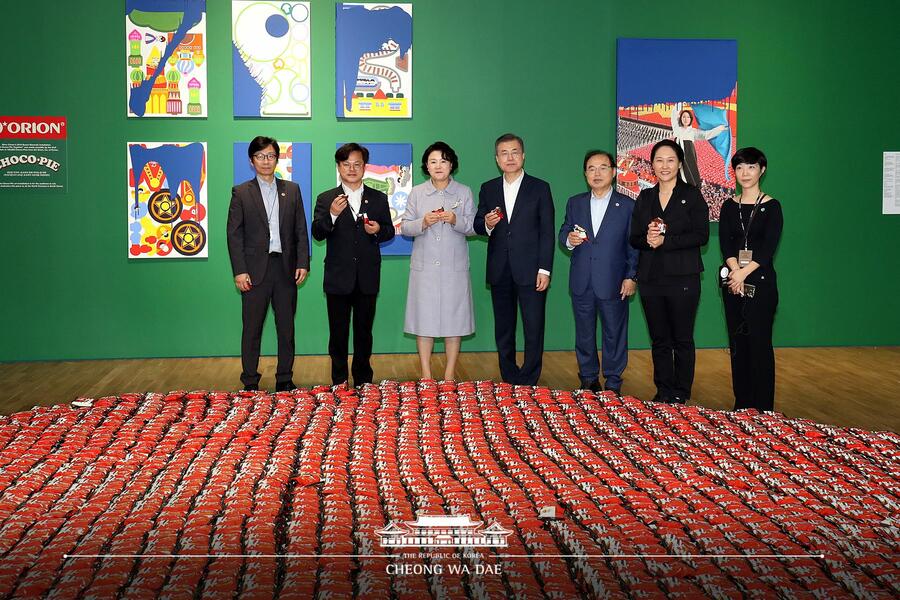 The Korean President Moon Jae-in and the First Lady Kim Jung-sook came to Eat Choco·Pie Together"Eat Choco·Pie Together" Take a Bite for Peace, Art for Healing, Koreas Unite! On September 14, 2018, the Korean President Moon Jae-in and the First Lady Kim Jung-sook came to Eat Choco·Pie Together, participating in the art by "taking a bite for peace." The artist Mina Cheon (천민정) explained to the President, that "the art is meant for the audience to eat for the sake of healing divided Korea" and requested if he would do the honor to Eat Choco·pie Together for Korean unification and global peace. The First Lady was the first to pick one up and they both participated in the interactive art, demonstrating their loving support for "a new beginning (새로운 시작) and love (Jung 情) between the two Koreas" as those words are written in Chinese and Korean on each individual wrappers. Moon and Kim's meeting today is highlighted with a ringing media slogan of "A New Future" for our Koreas, with hope for building peace and prosperity in our peninsula.
The Korean President Moon Jae-in and the First Lady Kim Jung-sook came to Eat Choco·Pie Together"Eat Choco·Pie Together" Take a Bite for Peace, Art for Healing, Koreas Unite! On September 14, 2018, the Korean President Moon Jae-in and the First Lady Kim Jung-sook came to Eat Choco·Pie Together, participating in the art by "taking a bite for peace." The artist Mina Cheon (천민정) explained to the President, that "the art is meant for the audience to eat for the sake of healing divided Korea" and requested if he would do the honor to Eat Choco·pie Together for Korean unification and global peace. The First Lady was the first to pick one up and they both participated in the interactive art, demonstrating their loving support for "a new beginning (새로운 시작) and love (Jung 情) between the two Koreas" as those words are written in Chinese and Korean on each individual wrappers. Moon and Kim's meeting today is highlighted with a ringing media slogan of "A New Future" for our Koreas, with hope for building peace and prosperity in our peninsula. -
Visitors with Chocopie installation at Busan Biennale 2018 MoCA Busan, Korea
-
Visitors with Chocopie installation at Busan Biennale 2018 MoCA Busan, Korea
-
Visitors with Chocopie installation at Busan Biennale 2018 MoCA Busan, Korea
-
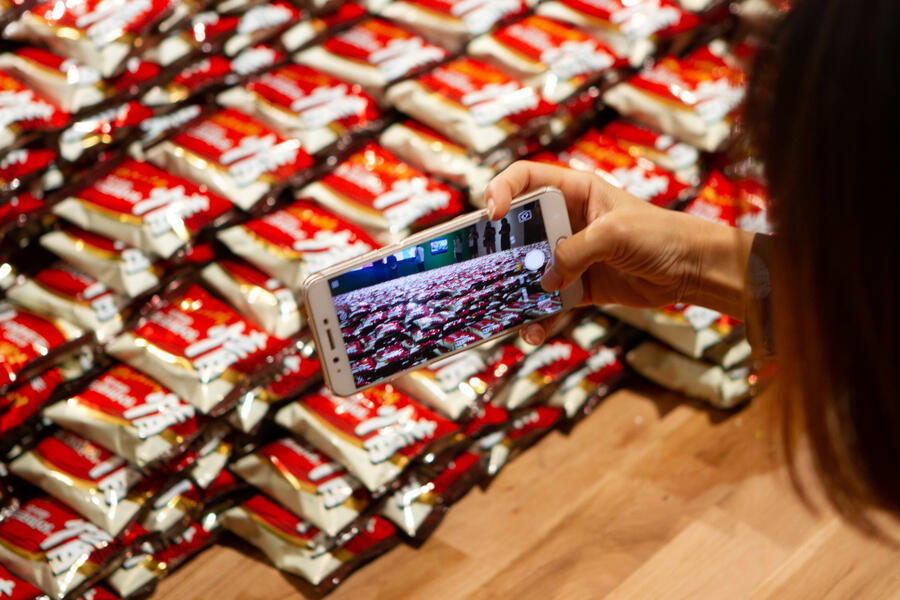 Visitors with Chocopie installation at Busan Biennale 2018 MoCA Busan, Korea
Visitors with Chocopie installation at Busan Biennale 2018 MoCA Busan, Korea
UMMA : MASS GAMES – Motherly Love North Korea
UMMA : MASS GAMES – Motherly Love North Korea
October 20 - December 10, 2017 (Extended till January 11, 2018)
Ethan Cohen Gallery in New York
251 W. 19th Street NY, NY 10011
Just as the Korean peninsula is split, so is its contemporary artistic consciousness. Mina Cheon is a South Korean artist who collaborates with her North Korean alter-ego KIM IL SOON (a Socialist Realist painter, naval commander, farmer, scholar, teacher, mother, and human being). In this, the latest of Cheon’s grapplings with the Korean schizo-imaginary, the topics of art, motherhood, games and hope come together in a reflection upon (cult)ure, love, and education.
Ethan Cohen Gallery presents Mina Cheon’s solo exhibition UMMA : MASS GAMES – Motherly Love North Korea, sending art to North Korea.
The recent war of words between North Korean and US leaders has only hardened the people’s attitudes to demagogue Father figures. With this exhibition, Cheon establishes the personality cult of UMMA (‘mommy’ in Korean), whose maternal love is deployed as the only acceptable solution for global peace and Korean unification. Whereas South Korea’s modernity was pushed forward by a chima baram (skirt wind), UMMA’s matriarchal strength is offered as a catalyst for developing North Korea. In this exhibition, Cheon (in the guise of her alter ego Kilm Il Soon, the ‘Umma of Unification’) sends motherly love and education to her children in the Hermit Kingdom and the USA. In addition, she debuts artworks resulting from a series of dissident dreams.
For UMMA : MASS GAMES, Cheon has worked with underground networks to send hundreds of USB drives containing performance lectures on contemporary art history into North Korea – arguably the first such artistic ‘re-programming’ engagement with the nation to date. All ten lessons will be on display at Ethan Cohen Gallery on Notel media players (devices commonly used in North Korea for watching foreign video content, such as K-pop, drama, and Korean Wave Cinema). The Art History Lessons by Professor Kim (2017) endeavor to be relatable for North Korean and American audiences – borrowing from children’s TV show formats while showcasing today’s contemporary artists and critical perspectives. Carrying the vital messages “The world loves you, North Korea” and “Both art and lives matter,” lesson topics include Art & Life; Art & Food; Art, Money & Power; Abstract Art & Dreams; Feminism, Are We Equal?; Art, Lives Matter & Social Justice; Remix & Appropriation Art; Art & Technology; Art & Silence; and Art & Environment.
The Mass Games (Arirang) are the paramount North Korean spectacle, deployed for nationalistic propaganda purposes and presented to the world. But are they any fun? In this exhibition, Umma supervises her own games, convened by love for her children: The show includes group-performance imagery in the form of Happy North Korean Children (2014) prints. Furthermore, an installation entitled Happy Land Games (2017), incorporating oversized wooden versions of the toys normally given away inside packets of South Korean Choco·Pie candy – depicting fairground rides from a mythical park called Happy Land. The Choco·Pie is the most desired smuggled confectionary in North Korea, a single pie trading (on the black market) for the equivalent of three bowls of rice. Visitors to Ethan Cohen Gallery are invited to assemble and play with Umma’s Happy Land. The themes of games, happiness, and imaginary society in these works are in dialogue with North Korea’s international self-presentation – invoking the DPRK’s 2011 Global Index of Happiness Research claim that it is ‘the second happiest nation in the world next to Big China.’
This exhibition also showcases an insight into Socialist Realist painter Kim Il Soon’s cosmopolitan subconscious. It is only in her dreams that she truly contemplates liberation. These dreams have resulted in two painting series (entitled, respectively, Hot Pink Drip and Yves Klein Blue Dip), which incorporate digital manipulation and abstract painterly gestures in conjunction with realist propaganda styles. Titles and topics include: Umma, Unicorn, and Unification, as well as a series of Professor Kim and Umma in her full virtuoso presentation rising above the clouds and fogs of the Baekdusan Mountain, in Umma Rises: Towards Global Peace. Other works include portraits of Umma in North Korea, Missiles Good Bye and Hello Brave New World.
In UMMA : MASS GAMES, the contradictions, fractures and paradoxes of the Korean imaginary are on full display. With the Kim Il Soon artist-complex (a locus of various attributes: scholar/educator, state-artist, dissident dreamer and mother/umma), Cheon explores overlapping political and personal dramas of identification and acceptance. Simultaneously, she exorcizes Fatherly sins through the cult of the great UMMA, her motherly love, and her serious play. No image of this love is too grand. Nothing too small: Leading up to the opening of her exhibition during NYC Asia Contemporary Art Week, Umma (dressed in traditional Korean garb and on her knees) performs the cleaning of gallery floors and offering kimchi. On Friday, October 13th , she cleaned the floors of Ethan Cohen Gallery as a prequel performance to the UMMA exhibit.
The exhibition catalog will include a curatorial essay by Nadim Samman, who contributed ideological engineering and ‘right-thinking,’ staging the provocation of the exhibition from the heavens to the undergrounds of North Korea, where Umma rises and descends. Other writers include fellow-traveler philosopher Laurence A. Rickels who has taken down the Official Psychoanalytic History of Umma and Korea, by interpreting Kim Il Soon’s dreams, unlocking her “andere Schauplatz” where she unleashes a desire for Unification.
"From Kim Il Soon to Professor Kim (whose scholastic pursuits are wide and unbound), our UMMA demonstrates militant efficiency; outstanding and seasoned ability of leadership; a thoroughgoing and indomitable spirit; the power of keen observation; clear analysis and extraordinary perspicacity with regard to all things and phenomena. UMMA’s love for the people is allied with a serious faculty for creative thinking, regarding every problem with an innovative eye. She shows courage and ambition while advancing vigorously along the road. She holds fast to the banner with a firm grasp; with strength, daring, energy and originality. Of course, it is my distinct honor to join with her program - and to offer my dedicated enthusiasm for proper implementation." (Curator Nadim Samman)
-
 Mass Games: Flagging UnificationYves Klein Blue Dip painting, on archival digital print on canvas, 40 x 30 inches, 2017.
Mass Games: Flagging UnificationYves Klein Blue Dip painting, on archival digital print on canvas, 40 x 30 inches, 2017. -
 Hello Brave New WorldYves Klein Blue Dip painting, on archival digital print on canvas, 40 x 30 inches, 2017.
Hello Brave New WorldYves Klein Blue Dip painting, on archival digital print on canvas, 40 x 30 inches, 2017. -
 Missiles Good ByeYves Klein Blue Dip painting, on archival digital print on canvas, 40 x 30 inches, 2017.
Missiles Good ByeYves Klein Blue Dip painting, on archival digital print on canvas, 40 x 30 inches, 2017. -
 04.jpg
04.jpg -
 ArirangInstallation of the wall size image of mass games stadium that cuts through the gallery space in serious contrast and architecturally perpendicular to the central Umma floating above the North Korean Baekdusan Mountain and in front of the Keumkangsan waterfall.
ArirangInstallation of the wall size image of mass games stadium that cuts through the gallery space in serious contrast and architecturally perpendicular to the central Umma floating above the North Korean Baekdusan Mountain and in front of the Keumkangsan waterfall. -
 Umma Rises: Towards Global PeaceMain exhibition view of Mina Cheon's UMMA : MASS GAMES - Motherly Love North Korea at Ethan Cohen Gallery The presentation and the curatorial vision of the entire show sections the gallery into heavens, earth, and the underground of North Korea. The heavens include this decent or rise of the Umma figure above the legendary North Korean Baekdusan Mountain, posed in a kind of crucifix as a superhero shaman. Behind her is the waterfall of the other most mystical Keumkangsan Mountain. And the image of mass games stadium cuts through the gallery space in serious contrast and architecturally perpendicular to the Umma. From the assumed wondrous nature of North Korea to the most mechanical man’s presentation of Arirang, the ground level includes the Happy Land Games, leading into stairs of the underground world where the game playing at a different level, displaying the 10 notel players that loop the videos of contemporary art history lessons being sent into North Korea. Also displayed throughout the show are Umma’s dream paintings since she can only think about unification, revolution, and abstraction in her dreams. But the paintings are also piled up like game boards rather than strictly hanging on walls.
Umma Rises: Towards Global PeaceMain exhibition view of Mina Cheon's UMMA : MASS GAMES - Motherly Love North Korea at Ethan Cohen Gallery The presentation and the curatorial vision of the entire show sections the gallery into heavens, earth, and the underground of North Korea. The heavens include this decent or rise of the Umma figure above the legendary North Korean Baekdusan Mountain, posed in a kind of crucifix as a superhero shaman. Behind her is the waterfall of the other most mystical Keumkangsan Mountain. And the image of mass games stadium cuts through the gallery space in serious contrast and architecturally perpendicular to the Umma. From the assumed wondrous nature of North Korea to the most mechanical man’s presentation of Arirang, the ground level includes the Happy Land Games, leading into stairs of the underground world where the game playing at a different level, displaying the 10 notel players that loop the videos of contemporary art history lessons being sent into North Korea. Also displayed throughout the show are Umma’s dream paintings since she can only think about unification, revolution, and abstraction in her dreams. But the paintings are also piled up like game boards rather than strictly hanging on walls. -
 Happy Land GamesFrom the assumed wondrous nature of North Korea to the most mechanical man’s presentation of Arirang, the ground level includes the Happy Land Games, an installation of blown up to life size punched out toys that North Koreans would find in Choco-Pie boxes smuggled into North Korea, a highly sought after confectionary. Made by MDF board with C+C Router cuts, the installation includes the image of the toys in Benday dots, introducting both new D-Fab and old print technologies. In 2014 at the Ethan Cohen Gallery, with the exhibition “Choco·Pie Propaganda: From North Korea with Love,” Mina Cheon installed 10,000 Choco·Pies on the ground for the American audience to taste, so that the awareness was about learning the desire of North Koreans. This time, with the current show, the toys from the box are life size so people can play with them at the gallery. These are alternative games, like arcades, or watching illegal video.
Happy Land GamesFrom the assumed wondrous nature of North Korea to the most mechanical man’s presentation of Arirang, the ground level includes the Happy Land Games, an installation of blown up to life size punched out toys that North Koreans would find in Choco-Pie boxes smuggled into North Korea, a highly sought after confectionary. Made by MDF board with C+C Router cuts, the installation includes the image of the toys in Benday dots, introducting both new D-Fab and old print technologies. In 2014 at the Ethan Cohen Gallery, with the exhibition “Choco·Pie Propaganda: From North Korea with Love,” Mina Cheon installed 10,000 Choco·Pies on the ground for the American audience to taste, so that the awareness was about learning the desire of North Koreans. This time, with the current show, the toys from the box are life size so people can play with them at the gallery. These are alternative games, like arcades, or watching illegal video. -
 Unification Flag InstallationDisplayed throughout the show are Umma’s dream paintings since she can only think about unification, revolution, and abstraction in her dreams. But the paintings are also piled up like game boards rather than strictly hanging on walls. Here is an installation of many paintings stacked together highlighting the Unification Flag, Korea's third flag after ROK and DPRK flags.
Unification Flag InstallationDisplayed throughout the show are Umma’s dream paintings since she can only think about unification, revolution, and abstraction in her dreams. But the paintings are also piled up like game boards rather than strictly hanging on walls. Here is an installation of many paintings stacked together highlighting the Unification Flag, Korea's third flag after ROK and DPRK flags. -
 Professor Kim Art History Lessons 1- 10The gallery space leads to the downstairs of the underground world where the game playing at a different level, displaying the 10 notel players that loop the videos of contemporary art history lessons being sent into North Korea. Screened on notel players at the gallery (notels being the commonly smuggled electronic device in North Korea for viewing foreign media akin to older DVD players with USB and SD ports), the art history lessons in video art form are the same ones being transmitted into North Korea, supported by anonymous North Korean defectors led NGOs in South Korea and by these people who believe it their life’s mission to help North Koreans liberate. These defectors, the collaborators of this aspect of the work, believe that this kind of information has the power to educate North Koreans about media.
Professor Kim Art History Lessons 1- 10The gallery space leads to the downstairs of the underground world where the game playing at a different level, displaying the 10 notel players that loop the videos of contemporary art history lessons being sent into North Korea. Screened on notel players at the gallery (notels being the commonly smuggled electronic device in North Korea for viewing foreign media akin to older DVD players with USB and SD ports), the art history lessons in video art form are the same ones being transmitted into North Korea, supported by anonymous North Korean defectors led NGOs in South Korea and by these people who believe it their life’s mission to help North Koreans liberate. These defectors, the collaborators of this aspect of the work, believe that this kind of information has the power to educate North Koreans about media. -
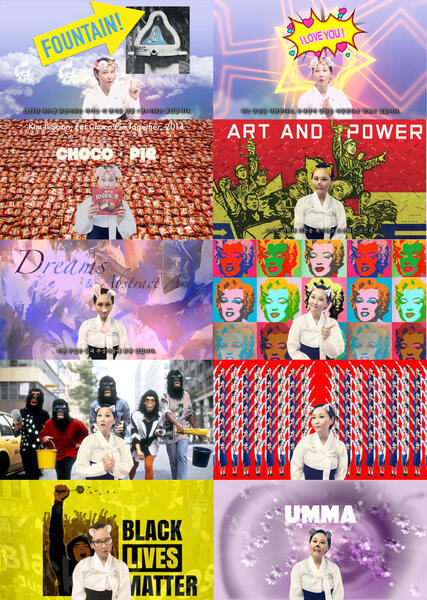 Video Art Sent to North KoreaVideo stills from various video art sent to North Korea, Professor Kim's Contemporary Art History Lessons (each video roughly 10 minutes), edited like children's educational TV show. Themes of Art History Lessons by Professor Kim include: 1. Art and Life 2. Art and Food 3. Art, Money, Power 4. Abstract Art and Dreams 5. Feminism, Are We Equal? 6. Art, Lives Matter, and Social Justice 7. Remix and Appropriation Art 8. Art and Technology 9. Art and Silence 10. Art and Environment There are a number of organizations in the United States that promote efforts to send information to North Korea. These include Flashdrives for Freedom, in California, who work with New York’s Human Rights Foundation. These US organizations are linked with larger organizations in Seoul, such as the North Korea Strategy Center. The Strategy Center liaises directly with activists and North Korean dissidents who send content into the North. The content generally includes world news, Wikipedia downloads, K-pop videos, K-drama, K-film, religious content, and more. The artist Mina Cheon has been working with ground level individuals and organizations based in South Korea who feel it is their life mission to free North Koreans from dictatorship; to help the opening up of North Korea, by supplying its people with information from and about the outside world. Looking at how media has played a role in opening closed societies, from faxes to art magazines – and, specifically, how information flows helped transform the Soviet Union and China – Cheon has been producing Professor Kim Art History Lessons with the North Koreans in mind. The videos are produced in K-Town of Baltimore, Maryland, uploaded onto USB drives in South Korea then passed on to these people, who directly take them into North Korea. The USBs have entered the country via several routes – through the land border with China, by balloons from South Korea, and another route that cannot be shared. Several hundred USBs have been sent to date and on going. List of Contents Art History Lesson 1 What is Art, What is Life? Part 1 (To be an Artist) (Professor Kim Snapchat Filter: Flower) Marcel Duchamp, Fountain, 1917 Assignment 1: Select an object from everyday life and call it art. Art History Lesson 2 What is Art, What is Life? Part 2 (Art and Food) (Professor Kim Snapchat Filter: Flower) Kim Il Soon, Eat Choco·Pie Together, 2014 Damien Hirst, The Physical Impossibility of Death in the Mind of Someone Living, 1991 Andy Warhol, Campbell’s Soup Cans, 1962 Felix Gonzalez-Torres, Untitled (Ross), 1991 Ai Weiwei, Sunflower Seeds, 2010 Cody Choi, The Thinker, 1996-7 Assignment 2: Select a food you like and call it art. Art History Lesson 3 Art, Money, Power (Professor Kim Snapchat Filter: Leopard) Andy Warhol, Mao, 1972 (Series #90-99) Ai Weiwei, Mao, 1986 Ai Weiwei, Study of Perspective: Tiananmen, White House, Eiffel Tower, 1995 Joonho Jeon, The White House, 2005 Wang Guangyi, Great Criticism, 1990-2007 Alexander Kosolapov, Coca-Cola, 1983; Malevich, 1990; This is My Blood, 2001 Lee Mingwei, Money for Art, 1994 Assignment 3: Share your money not as money but as art. Art History Lesson 4 Abstract Art and Dreams (Professor Kim Snapchat Filter: Bunny) Grace Hartigan, Untitled, 1952 Wassily Kandinsky, Black Strokes, 1913 Kazimir Malevich, White on White, 1918 Mark Rothko, Untitled, 1955 Jackson Pollock, Autumn Rhythm (Number 30), 1950 Rene Magritte, Golconde, 1953 Salvador Dali, The Persistence of Memory, 1931. Yves Klein, International Klein Blue (IKB), 1959 Kim Il Soon, North Korean Dream Paintings Assignment 4: What do you dream about? Write down your dreams and make them come true in abstraction, so you won’t get into trouble! Art History Lesson 5 Feminism, Are We Equal? (Professor Kim Snapchat Filter: Cat) Young-Hae Chang Heavy Industries Yoko Ono, Cut Piece, 1964 Barbara Kruger, Not Stupid Enough, 1997 Guerrilla Girls, Do Women have to be Naked to get into the Met. Museum? 1989 Shirin Neshat, Rebellious Silence, 1994 Kim Il Soon, Happy North Korean Children, 2014 Assignment 5: Reverse the gaze, and find a gorilla (Guerrilla Girls) mask and wear it to a party. Art History Lesson 6 Art, Lives Matter, and Social Justice (Professor Kim Snapchat Filter: Mouse with Glasses) South Korean Minjung Misool, 80s pro-democracy art Dread Scott, I am Not a Man, 2009; A Man Was Lynched by Police Yesterday, 2016 Mark Bradford, US Pavilion Venice Biennale 2017 and his social justice work Free Ai Weiwei Bansky Assignment 6: Make a Sign that says My Life Matters and wear it to a special event or make art in the streets in secret. Art History Lesson 7 Remix and Appropriation Art (Professor Kim Snapchat Filter: Zebra) Cindy Sherman Mariko Mori Yasumasa Morimura Gerhard Richter Komar + Melamid Ilya Kabakov Mina Cheon aka Kim Il Soon Assignment 7: Create remix collage, to make something original, and think about who do you want to be today, a copy of another personality. Art History Lesson 8 Art and Technology (Professor Kim Snapchat Filter: Mouse with Glasses) Nam June Paik, Zen for TV, 1963; Zen for Film, 1965 Satellite Art net.art Douglas Davis, The World’s First Collaborative Sentence, 1994 Char Davies, Osmose VR, 1995 Pierre Huyghe, Analee Christian Marclay, The Clock, 2010 Lee Wan, Proper Time, 2017 Cao Fei, RMB City: Second Life Project, 2008 Assignment 8: Turn on all your devices (media players) at once! Art History Lesson 9 Art and Silence (Professor Kim Snapchat Filter: Bunny) John Cage, 4’33”, 1952 BBC Televised Full Orchestra 4’33” Allan Kaprow, On/Off, 1994 Yoko Ono, Bed In, Peace, 1969 Kim Soo-ja, A Needle Woman Assignment 9: Get together with friends and watch John Cage’s 4’ 33” broadcasted live by BBC in full orchestral setting. Art History Lesson 10 Art and Environment (Professor Kim Snapchat Filter: Flower) Chris Jordan, Cell phones #2, 2005 Robert Smithson, Spiral Jetty, 1970 Olafur Eliasson, Your Waste of Time, 2013 The 1st Antarctic Biennale 2017 Gabriel Orozco, Found Objects, 2012 Christo and Jeanne-Claude, Surrounded Islands, 1980-83 rAndom International, Rain Room, 2013 Assignment 10: Collect your trash and recycle it into art!
Video Art Sent to North KoreaVideo stills from various video art sent to North Korea, Professor Kim's Contemporary Art History Lessons (each video roughly 10 minutes), edited like children's educational TV show. Themes of Art History Lessons by Professor Kim include: 1. Art and Life 2. Art and Food 3. Art, Money, Power 4. Abstract Art and Dreams 5. Feminism, Are We Equal? 6. Art, Lives Matter, and Social Justice 7. Remix and Appropriation Art 8. Art and Technology 9. Art and Silence 10. Art and Environment There are a number of organizations in the United States that promote efforts to send information to North Korea. These include Flashdrives for Freedom, in California, who work with New York’s Human Rights Foundation. These US organizations are linked with larger organizations in Seoul, such as the North Korea Strategy Center. The Strategy Center liaises directly with activists and North Korean dissidents who send content into the North. The content generally includes world news, Wikipedia downloads, K-pop videos, K-drama, K-film, religious content, and more. The artist Mina Cheon has been working with ground level individuals and organizations based in South Korea who feel it is their life mission to free North Koreans from dictatorship; to help the opening up of North Korea, by supplying its people with information from and about the outside world. Looking at how media has played a role in opening closed societies, from faxes to art magazines – and, specifically, how information flows helped transform the Soviet Union and China – Cheon has been producing Professor Kim Art History Lessons with the North Koreans in mind. The videos are produced in K-Town of Baltimore, Maryland, uploaded onto USB drives in South Korea then passed on to these people, who directly take them into North Korea. The USBs have entered the country via several routes – through the land border with China, by balloons from South Korea, and another route that cannot be shared. Several hundred USBs have been sent to date and on going. List of Contents Art History Lesson 1 What is Art, What is Life? Part 1 (To be an Artist) (Professor Kim Snapchat Filter: Flower) Marcel Duchamp, Fountain, 1917 Assignment 1: Select an object from everyday life and call it art. Art History Lesson 2 What is Art, What is Life? Part 2 (Art and Food) (Professor Kim Snapchat Filter: Flower) Kim Il Soon, Eat Choco·Pie Together, 2014 Damien Hirst, The Physical Impossibility of Death in the Mind of Someone Living, 1991 Andy Warhol, Campbell’s Soup Cans, 1962 Felix Gonzalez-Torres, Untitled (Ross), 1991 Ai Weiwei, Sunflower Seeds, 2010 Cody Choi, The Thinker, 1996-7 Assignment 2: Select a food you like and call it art. Art History Lesson 3 Art, Money, Power (Professor Kim Snapchat Filter: Leopard) Andy Warhol, Mao, 1972 (Series #90-99) Ai Weiwei, Mao, 1986 Ai Weiwei, Study of Perspective: Tiananmen, White House, Eiffel Tower, 1995 Joonho Jeon, The White House, 2005 Wang Guangyi, Great Criticism, 1990-2007 Alexander Kosolapov, Coca-Cola, 1983; Malevich, 1990; This is My Blood, 2001 Lee Mingwei, Money for Art, 1994 Assignment 3: Share your money not as money but as art. Art History Lesson 4 Abstract Art and Dreams (Professor Kim Snapchat Filter: Bunny) Grace Hartigan, Untitled, 1952 Wassily Kandinsky, Black Strokes, 1913 Kazimir Malevich, White on White, 1918 Mark Rothko, Untitled, 1955 Jackson Pollock, Autumn Rhythm (Number 30), 1950 Rene Magritte, Golconde, 1953 Salvador Dali, The Persistence of Memory, 1931. Yves Klein, International Klein Blue (IKB), 1959 Kim Il Soon, North Korean Dream Paintings Assignment 4: What do you dream about? Write down your dreams and make them come true in abstraction, so you won’t get into trouble! Art History Lesson 5 Feminism, Are We Equal? (Professor Kim Snapchat Filter: Cat) Young-Hae Chang Heavy Industries Yoko Ono, Cut Piece, 1964 Barbara Kruger, Not Stupid Enough, 1997 Guerrilla Girls, Do Women have to be Naked to get into the Met. Museum? 1989 Shirin Neshat, Rebellious Silence, 1994 Kim Il Soon, Happy North Korean Children, 2014 Assignment 5: Reverse the gaze, and find a gorilla (Guerrilla Girls) mask and wear it to a party. Art History Lesson 6 Art, Lives Matter, and Social Justice (Professor Kim Snapchat Filter: Mouse with Glasses) South Korean Minjung Misool, 80s pro-democracy art Dread Scott, I am Not a Man, 2009; A Man Was Lynched by Police Yesterday, 2016 Mark Bradford, US Pavilion Venice Biennale 2017 and his social justice work Free Ai Weiwei Bansky Assignment 6: Make a Sign that says My Life Matters and wear it to a special event or make art in the streets in secret. Art History Lesson 7 Remix and Appropriation Art (Professor Kim Snapchat Filter: Zebra) Cindy Sherman Mariko Mori Yasumasa Morimura Gerhard Richter Komar + Melamid Ilya Kabakov Mina Cheon aka Kim Il Soon Assignment 7: Create remix collage, to make something original, and think about who do you want to be today, a copy of another personality. Art History Lesson 8 Art and Technology (Professor Kim Snapchat Filter: Mouse with Glasses) Nam June Paik, Zen for TV, 1963; Zen for Film, 1965 Satellite Art net.art Douglas Davis, The World’s First Collaborative Sentence, 1994 Char Davies, Osmose VR, 1995 Pierre Huyghe, Analee Christian Marclay, The Clock, 2010 Lee Wan, Proper Time, 2017 Cao Fei, RMB City: Second Life Project, 2008 Assignment 8: Turn on all your devices (media players) at once! Art History Lesson 9 Art and Silence (Professor Kim Snapchat Filter: Bunny) John Cage, 4’33”, 1952 BBC Televised Full Orchestra 4’33” Allan Kaprow, On/Off, 1994 Yoko Ono, Bed In, Peace, 1969 Kim Soo-ja, A Needle Woman Assignment 9: Get together with friends and watch John Cage’s 4’ 33” broadcasted live by BBC in full orchestral setting. Art History Lesson 10 Art and Environment (Professor Kim Snapchat Filter: Flower) Chris Jordan, Cell phones #2, 2005 Robert Smithson, Spiral Jetty, 1970 Olafur Eliasson, Your Waste of Time, 2013 The 1st Antarctic Biennale 2017 Gabriel Orozco, Found Objects, 2012 Christo and Jeanne-Claude, Surrounded Islands, 1980-83 rAndom International, Rain Room, 2013 Assignment 10: Collect your trash and recycle it into art!
North Korean Dream Sequence Project 2, Dip and Drip International Klein Blue
North Korean Dream Sequence Project 2
Dip and Drip Painting Series in International Klein Blue 01-18, 2017
Acrylic on canvas, 36 x 24 x 1 inches each
As one of the last remaining hermit kingdoms of communism, North Korea has relentlessly remained socialist amidst a global overturn towards late-capitalism, and stands out with its greatest cultural paradox of vulnerability and threat. Mina Cheon, who is a South Korean artist working with a North Korean art persona named “Kim Il Soon,” campaigns for global awareness, North Korean lives matter, with her political pop and protest art she calls “polipop,” short for political pop art. Her new North Korean Dream Sequence Project showcases the unimaginable possibilities intersecting art, society, and politics, by painting things only possible in dreams to achieve North Korean liberation, freedom, and Korean unification.
While Kim Il Soon’s past paintings were done in North Korean social realist style, the new paintings are brazen in hot pink and in this particular series, in Klein International Blue. With swath of abstract expressionism overlaying realism, only in her dreams can Kim Il Soon truly paint freely and in abstraction, since the dictatorship and communist North Korea mandates art to be restrictive and done in a singular propaganda style. The Yves Klein International Blue as the pinnacle color of modern art, finds a new stage in the dream works of this North Korean artist, making transnational connections for dialog, global peace, and unity, through truthful arts related to life.
As a symbolic activity of Korean unification, the Klein blue is splashed, dipped, dripped on top of colorfully painted images of “Happy Land” themed Styrofoam punch-out paper toys found in Choco·Pie boxes, which are smuggled into North Korea from the South. As an extended theme by the artist, this “Choco-Pie Propaganda” takes the South Korean manufactured Choco-Pie confectionary that is vastly loved in North Korea, for its communication and exchange possibilities, hoping to heal the rift between the countries. These 18 vibrant paintings to be seen on both the front and back sides of the canvas, deliberately intermix Western abstraction with social realism, pop art and politics. Happy Land therefore, signifies the complexities of North Korea and its global presentation, our cultural bias and capitalist notion of happiness found in consumerism culture, and the question of global welfare tied to Korean unification.
-
 Dip and Drip Painting Series in International Klein Blue #02North Korean Dream Sequence Project 2 Dip and Drip Painting Series in International Klein Blue #02, 2017 Acrylic on canvas, 36 x 24 x 1 inches
Dip and Drip Painting Series in International Klein Blue #02North Korean Dream Sequence Project 2 Dip and Drip Painting Series in International Klein Blue #02, 2017 Acrylic on canvas, 36 x 24 x 1 inches -
 Dip and Drip Painting Series in International Klein Blue #01North Korean Dream Sequence Project 2 Dip and Drip Painting Series in International Klein Blue #01, 2017 Acrylic on canvas, 36 x 24 x 1 inches
Dip and Drip Painting Series in International Klein Blue #01North Korean Dream Sequence Project 2 Dip and Drip Painting Series in International Klein Blue #01, 2017 Acrylic on canvas, 36 x 24 x 1 inches -
 Dip and Drip Painting Series in International Klein Blue #04North Korean Dream Sequence Project 2 Dip and Drip Painting Series in International Klein Blue #04, 2017 Acrylic on canvas, 36 x 24 x 1 inches
Dip and Drip Painting Series in International Klein Blue #04North Korean Dream Sequence Project 2 Dip and Drip Painting Series in International Klein Blue #04, 2017 Acrylic on canvas, 36 x 24 x 1 inches -
 Dip and Drip Painting Series in International Klein Blue #05North Korean Dream Sequence Project 2 Dip and Drip Painting Series in International Klein Blue #05, 2017 Acrylic on canvas, 36 x 24 x 1 inches
Dip and Drip Painting Series in International Klein Blue #05North Korean Dream Sequence Project 2 Dip and Drip Painting Series in International Klein Blue #05, 2017 Acrylic on canvas, 36 x 24 x 1 inches -
 Dip and Drip Painting Series in International Klein Blue #08North Korean Dream Sequence Project 2 Dip and Drip Painting Series in International Klein Blue #08, 2017 Acrylic on canvas, 36 x 24 x 1 inches
Dip and Drip Painting Series in International Klein Blue #08North Korean Dream Sequence Project 2 Dip and Drip Painting Series in International Klein Blue #08, 2017 Acrylic on canvas, 36 x 24 x 1 inches -
 Dip and Drip Painting Series in International Klein Blue #10North Korean Dream Sequence Project 2 Dip and Drip Painting Series in International Klein Blue #10, 2017 Acrylic on canvas, 36 x 24 x 1 inches
Dip and Drip Painting Series in International Klein Blue #10North Korean Dream Sequence Project 2 Dip and Drip Painting Series in International Klein Blue #10, 2017 Acrylic on canvas, 36 x 24 x 1 inches -
 Dip and Drip Painting Series in International Klein Blue #12North Korean Dream Sequence Project 2 Dip and Drip Painting Series in International Klein Blue #12, 2017 Acrylic on canvas, 36 x 24 x 1 inches
Dip and Drip Painting Series in International Klein Blue #12North Korean Dream Sequence Project 2 Dip and Drip Painting Series in International Klein Blue #12, 2017 Acrylic on canvas, 36 x 24 x 1 inches -
 Dip and Drip Painting Series in International Klein Blue #16North Korean Dream Sequence Project 2 Dip and Drip Painting Series in International Klein Blue #16, 2017 Acrylic on canvas, 36 x 24 x 1 inches
Dip and Drip Painting Series in International Klein Blue #16North Korean Dream Sequence Project 2 Dip and Drip Painting Series in International Klein Blue #16, 2017 Acrylic on canvas, 36 x 24 x 1 inches -
 Dip and Drip Painting Series in International Klein Blue 01-18 FrontNorth Korean Dream Sequence Project 2 Dip and Drip Painting Series in International Klein Blue 01-18, 2017 Acrylic on canvas, 36 x 24 x 1 inches each All 18 pieces front
Dip and Drip Painting Series in International Klein Blue 01-18 FrontNorth Korean Dream Sequence Project 2 Dip and Drip Painting Series in International Klein Blue 01-18, 2017 Acrylic on canvas, 36 x 24 x 1 inches each All 18 pieces front -
 Dip and Drip Painting Series in International Klein Blue 01-18 BackNorth Korean Dream Sequence Project 2 Dip and Drip Painting Series in International Klein Blue 01-18, 2017 Acrylic on canvas, 36 x 24 x 1 inches each All 18 pieces back
Dip and Drip Painting Series in International Klein Blue 01-18 BackNorth Korean Dream Sequence Project 2 Dip and Drip Painting Series in International Klein Blue 01-18, 2017 Acrylic on canvas, 36 x 24 x 1 inches each All 18 pieces back
Dream Sequence and DPRK Polipop
Assuming different artistic pseudonyms and pen names during the past twenty years such as Minaliza1000 and M-1000 was nothing new, but Cheon’s latest artistic persona named Kim Il Soon, who is a North Korean social realist painter is an important political statement. Since Korea has been divided into North and South Korea since the Korean War, and as a relic of the Cold War, Cheon advocates that the practicing Korean artist should also be split and therefore, Cheon has been working simultaneously as both a “South Korean Mina Cheon” and “North Korean Kim Il Soon.” Her North Korean artwork is called DPRK Polipop, short for Democratic People’s Republic of Korea Political Pop Art, or Kim Il Soon’s “Sweet Revolution.” The goal and political campaign of this branch of work is for the sake of global peace and Korean unification. Assuming different artistic personae in photography, new media, and performance such as works of Coco Fusco, Cindy Sherman, Yasumasa Morimura, and Nikki Lee, to name a few, contributed to the themes of postmodern identity. Cheon’s North Korean artistic persona Kim Il Soon is a deliberate political move, social activism and performance, and will be ongoing until Korean unification.
2015 includes the works of an art book cataloging the DPRK Polipop art series as well as finishing up three more social realist paintings and the new hot pink drip paintings.
The DPRK Polipop: Sweet Revolution art book was published in May 2015 through the Mina Cheon Studio and available at http://www.blurb.com/b/6219321-dprk-polipop
DPRK POLIPOP : SWEET REVOLUTION is an art book by political pop and new media artist MINA CHEON who has taken on the artistic persona of a North Korean social realist painter "Kim Il Soon" for the sake of promoting Korean unification and global peace. The book highlights the collection of Cheon’s artwork, which she calls “DPRK Polipop,” a new branch of her Polipop: Political Pop Art series. The book also showcases 2014 exhibitions at the Ethan Cohen New York gallery and Trunk Gallery Seoul, Korea, as well as including texts by Cheon, art critic Jonathan Goodman, curator Jin Kwon, and reporter Iris Jang of Voice of America. The book is published by Mina Cheon Studio at K-Town Studios in Baltimore, Maryland, 2015. Mina Cheon Studio is dedicated to scholarly work and art production of contemporary and global, new media political pop art projects.
DPRK POLIPOP : SWEET REVOLUTION BY MINA CHEON
ISBN: 9781320695909 PAGES: 66
© Copyright 2015 Mina Cheon, all rights reserved
Published by MINA CHEON STUDIO
MINA CHEON STUDIO @ K-TOWN STUDIOS
100 West 22nd Street, Baltimore MD 21218
Book design by Travis Levasseur and Leslie E. Chung of MINA CHEON STUDIO
-
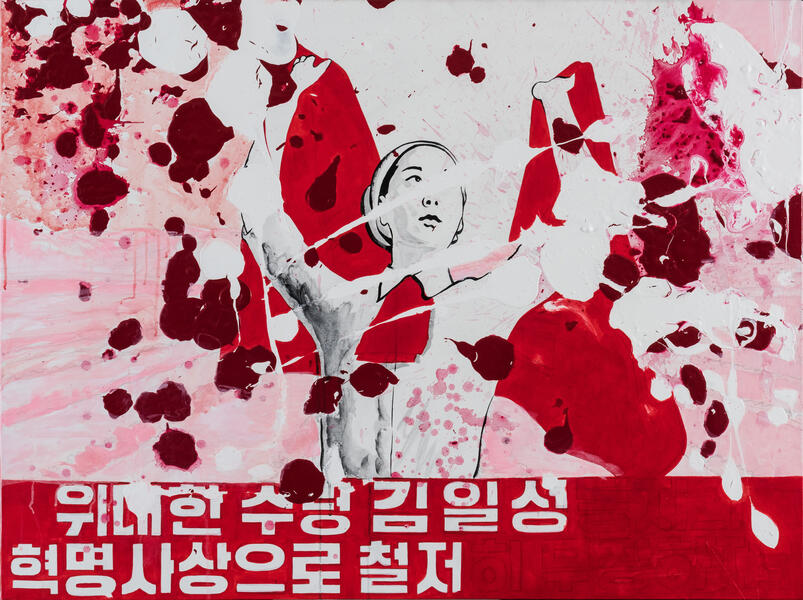 Dream Sequence: Hot Pink Drip Painting 03Date Work Completed: 2015-6 Medium: acrylic on canvas Size: 36 x 48 x 1.5 inches Description: The latest body of Mina Cheon aka Kim Il Soon paintings are her Dream Sequence painting series where she is painting hot pink drip, Western style abstract expressionist paintings in her dreams. Due to the regimented military life under governmental control in North Korea, only in her dreams is this character Kim Il Soon allowed to paint this type of work and is unconsciously liberating herself artistically as well as from the regime. Here Kim Il Soon is raising the red flags in honor of the communist state of North Korea.
Dream Sequence: Hot Pink Drip Painting 03Date Work Completed: 2015-6 Medium: acrylic on canvas Size: 36 x 48 x 1.5 inches Description: The latest body of Mina Cheon aka Kim Il Soon paintings are her Dream Sequence painting series where she is painting hot pink drip, Western style abstract expressionist paintings in her dreams. Due to the regimented military life under governmental control in North Korea, only in her dreams is this character Kim Il Soon allowed to paint this type of work and is unconsciously liberating herself artistically as well as from the regime. Here Kim Il Soon is raising the red flags in honor of the communist state of North Korea. -
 Dream Sequence: Hot Pink Drip Painting 01Date Work Completed: 2015-6 Medium: acrylic on canvas Size: 48 x 36 x 1.5 inches Description: Here Kim Il Soon appears from a flog like cloudy mists, in a very dream like landscape and under the banner of North Korean flags.
Dream Sequence: Hot Pink Drip Painting 01Date Work Completed: 2015-6 Medium: acrylic on canvas Size: 48 x 36 x 1.5 inches Description: Here Kim Il Soon appears from a flog like cloudy mists, in a very dream like landscape and under the banner of North Korean flags. -
 Dream Sequence: Hot Pink Drip Painting 04Date Work Completed: 2015-6 Medium: acrylic on canvas Size: 36 x 48 x 1.5 inches Description: The latest body of Mina Cheon aka Kim Il Soon paintings are her Dream Sequence painting series, where she is painting hot pink drip Western style abstract expressionist paintings. Due to the regimented military life under the North Korean governmental control, social realist painter Kim Il Soon is artistically liberating herself as well as from the regime in her dreams. The tribal unconsciousness for desiring abstract expression as a way of freedom of expression came to her as dreams. Here Kim Il Soon is holding up the communist Red Book while farming and working hard out in the fields.
Dream Sequence: Hot Pink Drip Painting 04Date Work Completed: 2015-6 Medium: acrylic on canvas Size: 36 x 48 x 1.5 inches Description: The latest body of Mina Cheon aka Kim Il Soon paintings are her Dream Sequence painting series, where she is painting hot pink drip Western style abstract expressionist paintings. Due to the regimented military life under the North Korean governmental control, social realist painter Kim Il Soon is artistically liberating herself as well as from the regime in her dreams. The tribal unconsciousness for desiring abstract expression as a way of freedom of expression came to her as dreams. Here Kim Il Soon is holding up the communist Red Book while farming and working hard out in the fields. -
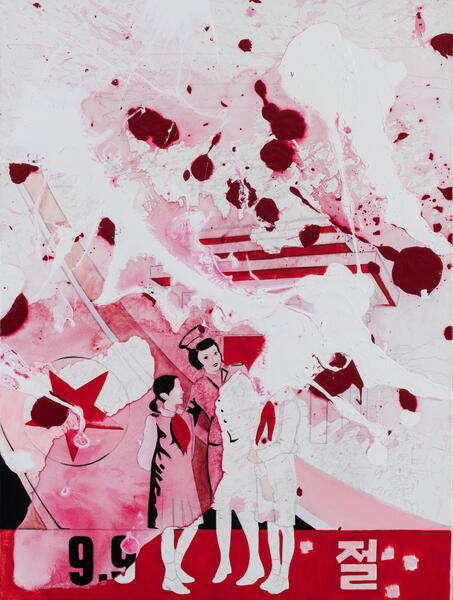 Dream Sequence: Hot Pink Drip Painting 05Date Work Completed: 2015-6 Medium: acrylic on canvas Size: 36 x 24 x 1.5 inches Description: Here Kim Il Soon is dreaming of peaceful gathering of herself and her children as she is married to the state and the dear leader.
Dream Sequence: Hot Pink Drip Painting 05Date Work Completed: 2015-6 Medium: acrylic on canvas Size: 36 x 24 x 1.5 inches Description: Here Kim Il Soon is dreaming of peaceful gathering of herself and her children as she is married to the state and the dear leader. -
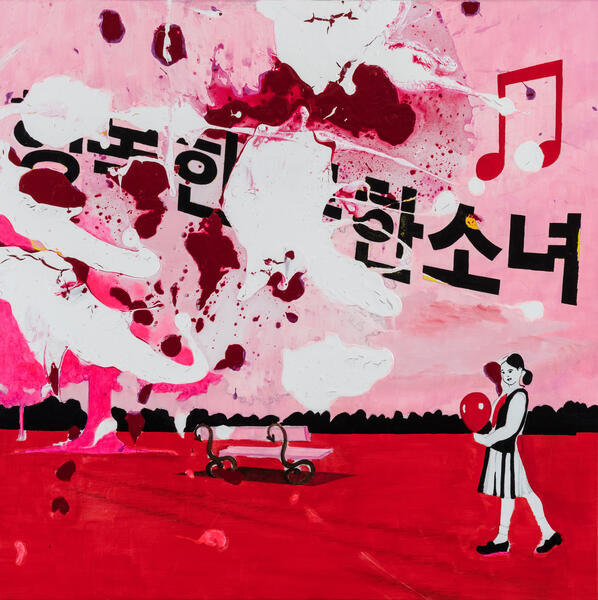 Dream Sequence: Hot Pink Drip Painting 02Date Work Completed: 2015-6 Medium: acrylic on canvas Size: 36 x 36 x 1.5 inches Description: In Kim Il Soon's dream, her daughter Kim Sia appears as the happiest North Korean girl, playing in the park with a balloon and singing songs of joy.
Dream Sequence: Hot Pink Drip Painting 02Date Work Completed: 2015-6 Medium: acrylic on canvas Size: 36 x 36 x 1.5 inches Description: In Kim Il Soon's dream, her daughter Kim Sia appears as the happiest North Korean girl, playing in the park with a balloon and singing songs of joy. -
 Happy North Korean Children IDate Work Completed: 2015 Medium: acrylic on canvas Size: 48 x 60 x 1.5 inches Description: The painting shows an abstract and imaginary field of happy North Korean children, posed by the artist’s own children Gerson and Sasha as “Kim Siun” and “Kim Sia,” characters who multiply, assuming the identities of many happy children similarly portrayed in North Korean propaganda imagery.
Happy North Korean Children IDate Work Completed: 2015 Medium: acrylic on canvas Size: 48 x 60 x 1.5 inches Description: The painting shows an abstract and imaginary field of happy North Korean children, posed by the artist’s own children Gerson and Sasha as “Kim Siun” and “Kim Sia,” characters who multiply, assuming the identities of many happy children similarly portrayed in North Korean propaganda imagery. -
 Happy North Korean Children IIDate Work Completed: 2015 Medium: acrylic on canvas Size: 60 x 36 x 1.5 inches Description: North Korean Children are happy because the North Korean government presents their “Juche” ideology, blissfulness that comes from social collectiveness. As a part of her social activism, the artist created North Korean political pop art, promoting Korean unification and global peace.
Happy North Korean Children IIDate Work Completed: 2015 Medium: acrylic on canvas Size: 60 x 36 x 1.5 inches Description: North Korean Children are happy because the North Korean government presents their “Juche” ideology, blissfulness that comes from social collectiveness. As a part of her social activism, the artist created North Korean political pop art, promoting Korean unification and global peace. -
 Line up Kim Il Soon IIDate Work Completed: 2015 Medium: acrylic on canvas Size: 36 x 60 x 1.5 inches Description: “Kim Il Soon” is the North Korean art persona created by the artist Cheon, and she is currently lined up and appears in multiple and throughout many of this North Korean painting series. The national identity and propaganda of North Korea is portrayed through the military unity.
Line up Kim Il Soon IIDate Work Completed: 2015 Medium: acrylic on canvas Size: 36 x 60 x 1.5 inches Description: “Kim Il Soon” is the North Korean art persona created by the artist Cheon, and she is currently lined up and appears in multiple and throughout many of this North Korean painting series. The national identity and propaganda of North Korea is portrayed through the military unity. -
 Line up Kim Il SoonDate Work Completed: 2013-2014 Medium: acrylic on canvas Size: 36 x 60 x 1.5 inches Description: Kim Il Soon is lined up and appears in multiple. In North Korean military, all that matters is collectivity over individuality, unity over plurality. The piece is a series with Position I and Position II or it can be a single piece. The national identity of a North Korean is similar in this way in that there is no real individual identity rather collective, one is the same as all and all is the same as one, found in the “Juche” ideology.
Line up Kim Il SoonDate Work Completed: 2013-2014 Medium: acrylic on canvas Size: 36 x 60 x 1.5 inches Description: Kim Il Soon is lined up and appears in multiple. In North Korean military, all that matters is collectivity over individuality, unity over plurality. The piece is a series with Position I and Position II or it can be a single piece. The national identity of a North Korean is similar in this way in that there is no real individual identity rather collective, one is the same as all and all is the same as one, found in the “Juche” ideology. -
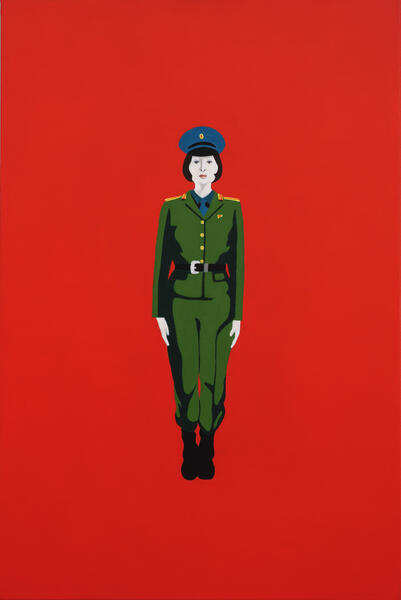 Position IDate Work Completed: 2013-2014 Medium: acrylic on canvas Size: 36 x 24 x 1.5 inches Description: The piece is a series with Line Up and Position II but can also be considered a single piece or diptych with Position II. The national identity of a North Korean is similar to this in that there is no real individual identity rather collective, one is the same as all and all is the same as one, found in the “Juche” ideology.
Position IDate Work Completed: 2013-2014 Medium: acrylic on canvas Size: 36 x 24 x 1.5 inches Description: The piece is a series with Line Up and Position II but can also be considered a single piece or diptych with Position II. The national identity of a North Korean is similar to this in that there is no real individual identity rather collective, one is the same as all and all is the same as one, found in the “Juche” ideology.
DPRK POLIPOP
by Mina Cheon
In 2012, new media artist Mina Cheon launched a new artistic persona and alter ego / avatar named Kim Il Soon, who is a North Korean social realist painter. This is a deliberate political move by the artist to bring awareness about North Korea. She will resume painting until Korean reunification. Her name Kim Il Soon was bequest to her by the supposed Dear Leader. She is a nationally recognized painter of the Democratic People’s Republic of Korea, as well as a Lieutenant Colonel Navel Commander, scholar, devout citizen, hardworking farmer, a mother of two, and most importantly, a human being.
Kim Il Soon appeared publicly for the first time during the Pulse Art Fair in New York in 2013 and this painting “Sons of Joseon: Squirt Water Not Bullets” was exhibited alongside her performance, as she passed out political and peace buttons “Make Art Not Missiles.” The painting is one out of a larger series of work, which are elaborations of Kim Il Soon’s performance and political pop art campaign for global peace and Korean reunification. North Koreans call their nation “Joseon” but they do not directly relate themselves or acknowledge the history of Joseon Dynasty. The two boys in the painting is of her son Kim Si-un, the doubling of his appearance signifies the twin effect, a country split into two. “Sons of Joseon” was acquired by the Smith College Museum of Art, and housed in the contemporary art section.
SWEET REVOLUTION (Artist Statement)
Mina Cheon Dictation Kim Il Soon
January 17, 2014
On my mother’s birthday.
As a Korean, the idea of having two artistic identities, South Korean Mina Cheon and North Korean Kim Il Soon, is an obvious reflection on the country’s state of being divided. It makes all the sense in the world that if a country is split so should the artist in practice. As a political pop artist, I’ve created artworks that responded to the global political climate, using pop imagery that circulates on the Internet, news, and entertainment as the source of my work. As a South Korean new media artist Mina Cheon, the political pop art (Polipop) includes the perspective of a South Korean-American who travels between the East and West, bringing out things that usually go unnoticed or said in media culture. As a North Korean social realist painter, Kim Il Soon lacks access to technology and adheres strictly to the propaganda painting style of North Korea.
While the Korean peninsula may be demarcated by a 38th Parallel, the Demilitarized Zone (DMZ), the history and culture is nevertheless shared, the country is united by one country’s people and language. Moreover, Korea is ubiquitously tied by the never-ending heated debate on reunification and national identity, whether we are at war, armistice, trade, or peace. This is our business.
The world may find our country (countries) amusing, the radically divided, globally useful as separated communism and capitalism states, fanatically obsessing over sports or military or pop culture. Our history is made by other countries and cultures, the Western influence has been severe, whether through China, Japan or America, it makes sense that other worlds and countries deem to hold stake at what should remain – a country divided – and what shouldn’t happen – reunification. Who are those who dictate what should happen? Who are fit to lead the way towards unification, when cultural divides remain not only from South and North but also between East and West, and even between the left and right politics.
What does economy have to do with it? Probably everything. It benefits some for Korea to be separated; it benefits others for us to unite. Mostly, humanitarians would like to see Korean reunification for the purpose of global peace. We are those people, Kim Il Soon and Mina Cheon, and everyone else who support the cause of this political pop art campaign which include the slogans and ideas, “Eat Choco·Pie Together,” “Squirt Water Not Bullets,” and “Make Art Not Missiles.”
In 2004, I traveled to North Korea from South Korea, busing passed the DMZ with very large windows without curtains so that North Korean military soldiers can see us through the glass. The tour was to the glorious and mystical Mountain Kum Kang San, a place that is now forbidden ever since 2008, when a South Korean female tourist was shot twice by a North Korean officer for straying her path. With the same name as the number one Korean restaurant in New York City, the Kum Kang San Restaurant in K-town where you dine Korean BBQ over a massive faux mountain made out of Styrofoam and a mechanically pumped waterfall, the passing into North Korea was its own simulacra, a copy without an original since the sky seemed bluer, the mountains looking just like the images we are so familiar with through posters and calendars of hallmarking beauty of North Korea. Being at the actual site only reinforced the image of the place, it was all a reproductive moment. And the woman who got shot, could have been me, as I am told repeatedly.
While the tour was restrictive and highly programmed, my direct interactions with North Koreans were nothing like the axis of evil, uncle killing, actress raping, fan of Dennis Rodman, rogue enemy. Instead, they were warm. I felt akin, like being with my own family, they were like sisters, and like my mother, who after all was from the North and came down to the South at the brink of war.
Many of the North Korean female workers around the Kum Kang San’s Hyundai Resort, or even the security were friendly. They called me “unni” meaning older sister and even showed signs of affection by slightly holding my arm when speaking to me. I did not feel foreign in this country.
Soon after my trip, I started creating my first series of political pop art on North Korea with a series of 99 Miss Kim(s) doll installation of North Korean military femme bots that superseded American Barbie dolls in beauty and appearance, as well as an interactive media installation piece, Half Moon Eyes that archived all the videos from that trip, including footages that I had to retrieve back after confiscation. The term “half moon eyes” references the shape of North Korean female eyes that make them remarkably beautiful. The work I did then was dedicated to my mother whose maiden name is Kim, as well as all of the Kim names of North Korea. Miss Kim was also myself, as a Korean embodying North Korean history.
By 2012, it was no accident that meeting Ethan Cohen who also has a history with North Korea, encouraged me to elaborate further with Miss Kim, Ms. Kim Il Soon. Her name Kim Il Soon bequeath to her by the supposed Dear Leader, means “eternal purity” and sounds similar to Kim Il Sung, founder of the Democratic People’s Republic of Korea whose name means “eternal sun.” Kim Il Soon is a nationally recognized painter, which means she has a bit more artistic freedom than some. She is also a two-starred Lieutenant Commander, scholar, devout citizen, hardworking farmer, a mother of two, and most importantly, a human being.
The artwork created in this persona is a deliberate political move, the art is activism that brings awareness about North Korea and it is Kim Il Soon’s intention to resume painting until Korean reunification. She is my artistic persona, alter ego, a new media avatar, and this is our performance. With the work ethics of a good North Korean, Kim Il Soon spends a hundred hours with each painting. Since she is recognized as a national painter, she has assistants, but nevertheless labors over the work.
Kim Il Soon appeared publicly in the United States for the first time during the Pulse Art Fair in New York 2013 with Ethan Cohen New York, and the painting Sons of Joseon: Squirt Water Not Bullets was exhibited alongside her performance, as she passed out political peace buttons. North Koreans call their nation “Joseon” but they do not directly relate themselves or acknowledge the history of the Korean Joseon Dynasty. The two boys in the painting is her son Kim Si-un, and the doubling of his appearance signifies the twin effect, a country split into two. This painting was soon thereafter acquired by the Smith College Museum of Art, and housed in the contemporary art section, a fitting place for housing their very first North Korean female artist’s work.
So, here we are. Kim Il Soon’s very first solo exhibition at Ethan Cohen New York gallery opens. In varying sizes, her paintings resemble North Korean propaganda posters. In Happy North Korean Girl, she proudly poses in front of the DPRK flag. She is happy because she can serve her nation with pride. In 2011, the North Korean Chosun Central Television announced the results of a new global happiness index reported by the national research team, and it states that North Korea is the second happiest nation aside big China which is supposedly the happiest due to the mere number of people; South Korea being in the 152nd place and “the American Empire” in place 203, which would not be a surprise if it was dead last place.
The paintings of Happy North Korean Little Boy and Happy North Korean Little Girl show Kim Il Soon’s children, Kim Si-un (son) and Kim Si-a (daughter) who sing their hearts out for their country on stage. While blessed with two children, Kim Il Soon is only married to the state, and by default married to the Dear Leader, in perpetuity.
Another painting In Honor of The Great Dear Leader Father includes Kim Il Soon raising the red flag under the blazing sun of Kim Il Sung, and other Dear Leaders appear in other paintings such as in Strength and Military, where Kim Il Soon holds a North Korean rifle while embracing a portrait of dictator Kim Jong-il in front of an industrial complex. In the painting Lil’ Kim, the February 2012 Times Magazine’s front cover of Kim Jong-un is framed while Kim Il Soon is taking notes and sketching in her little red book.
From other paintings such as the Three Graces that reference Western beauty amidst a North Korean flag to Kim Il Soon as a farmer in The Seven Years Plan, the doubling and tripling image of self signifies the multiplication process in reproductive culture, lacking individuality and promoting collectivity and succinctness in unity repeated in North Korean imagery. Whether lining up in painting Line Up or spiraling in 007, Kim Il Soon includes herself into North Korean military iconography that includes the “Juche” ideology that one is all and all is one.
And, whose Choco·Pie is it?
The installation of 10,000 Choco·Pie for the audience to eat was kindly donated by Orion Co. in support of the installation Eat Choco·Pie Together that promotes Korean reunification and global peace. Kim Il Soon unconsciously exposed to the outside world, had her Duchampian moment of making a good decision. Duchamp selects a toilet and she selects a relevant intercultural consumer object of our time, the Choco·Pie.
This South Korean moon pie-like confectionary has become an overnight sensation in North Korea as a smuggled favorite snack and is worth three bowls of rice, and favored especially by the elite class North Korean women. Comparable to the American Twinkie, Choco·Pie has been sought after in North Korea, ever since South Koreans gifted Choco·Pie to the North Korean laborers at the Kaesong Industrial Complex as a token of appreciation. Symbolically, the Choco·Pie has opened up North Korea and formed a loving exchange between the North and South, something that even the Korean governments have failed to do. Truly this is a postmodern co-national co-operation, one that is a viral and an addictive kind.
The Chinese character “Jung” on the packaging means love and friendship. Choco·Pie is ours to eat, for North and South Korea, and for America – Let’s Eat Choco·Pie Together – for “Han guk” means “one country,” not Republic of Korea, not Democratic People’s Republic of Korea. This is a “Sweet Revolution.”
The exhibition “CHOCO·PIE PROPAGANDA: From North Korea with Love” by Mina Cheon aka Kim Il Soon was shown at Ethan Cohen New York (ECNY), January 28 - March 1, 2014. ECNY is located on 251 W. 19th St, between 7 and 8th Ave, New York, NY 10011. http://www.ecfa.com/
-
 Sons of Joseon: Squirt Water Not BulletsDate Work Completed: 2013 Medium: acrylic on canvas Size: 48 x 60 x 1.5 inches Description: North Koreans call their nation “Joseon” but they do not directly relate themselves or acknowledge the history of Joseon Dynasty. The two boys in the painting is of Kim Il Soon’s character son Kim Siun, the doubling of his appearance signifies the twin effect, a country split into two. Kim Il Soon appeared publicly for the first time during the Pulse Art Fair in New York in 2013 and this painting “Sons of Joseon: Squirt Water Not Bullets” was exhibited alongside her performance, as she passed out political and peace buttons “Make Art Not Missiles.” The painting is one out of a larger series of work, which are elaborations of Kim Il Soon’s performance and political pop art campaign for global peace and Korean reunification. North Koreans call their nation “Joseon” but they do not directly relate themselves or acknowledge the history of Joseon Dynasty. The two boys in the painting is of her son Kim Si-un, the doubling of his appearance signifies the twin effect, a country split into two. “Sons of Joseon” was acquired by the Smith College Museum of Art, and housed in the contemporary art section. The North Korean Political Pop Art Campaign “SQUIRT WATER NOT BULLETS” “MAKE ART NOT MISSILES” accompanied the work during Pulse NY Contemporary Art Fair, May 9 – 12, 2013 in Booth C-2, The Metropolitan Pavilion. Honoring the 101st birthday of North Korean founder Kim Il Sung on April 15 and celebrating the upcoming 65th Anniversary of DPRK National Independence Day on September 9, Kim Il Soon makes her appearance during Pulse NY VIP Opening reception. Her presence makes diplomatic gestures of friendship, overcomes past misunderstandings between North Korea, South Korea, and the United States, and promotes “Art Not War.”
Sons of Joseon: Squirt Water Not BulletsDate Work Completed: 2013 Medium: acrylic on canvas Size: 48 x 60 x 1.5 inches Description: North Koreans call their nation “Joseon” but they do not directly relate themselves or acknowledge the history of Joseon Dynasty. The two boys in the painting is of Kim Il Soon’s character son Kim Siun, the doubling of his appearance signifies the twin effect, a country split into two. Kim Il Soon appeared publicly for the first time during the Pulse Art Fair in New York in 2013 and this painting “Sons of Joseon: Squirt Water Not Bullets” was exhibited alongside her performance, as she passed out political and peace buttons “Make Art Not Missiles.” The painting is one out of a larger series of work, which are elaborations of Kim Il Soon’s performance and political pop art campaign for global peace and Korean reunification. North Koreans call their nation “Joseon” but they do not directly relate themselves or acknowledge the history of Joseon Dynasty. The two boys in the painting is of her son Kim Si-un, the doubling of his appearance signifies the twin effect, a country split into two. “Sons of Joseon” was acquired by the Smith College Museum of Art, and housed in the contemporary art section. The North Korean Political Pop Art Campaign “SQUIRT WATER NOT BULLETS” “MAKE ART NOT MISSILES” accompanied the work during Pulse NY Contemporary Art Fair, May 9 – 12, 2013 in Booth C-2, The Metropolitan Pavilion. Honoring the 101st birthday of North Korean founder Kim Il Sung on April 15 and celebrating the upcoming 65th Anniversary of DPRK National Independence Day on September 9, Kim Il Soon makes her appearance during Pulse NY VIP Opening reception. Her presence makes diplomatic gestures of friendship, overcomes past misunderstandings between North Korea, South Korea, and the United States, and promotes “Art Not War.” -
 Space Composite #3Ink on Layered Durlar on Paper Summer/Fall 2010
Space Composite #3Ink on Layered Durlar on Paper Summer/Fall 2010 -
 In Honor of The Great Dear Leader FatherDate Work Completed: 2012 Medium: acrylic on canvas Size: 24 x 36 x 1.5 inches Description: This painting includes Kim Il Soon raising the red flag under the blazing sun of Kim Il Sung, the founder of Democratic People’s Republic of Korea. The name Kim Il Sung, means eternal sunshine, and Kim Il Soon, the name bequeathed by the Dear Leader means “eternal purity.” Other: This is one of the very first two Kim Il Soon paintings.
In Honor of The Great Dear Leader FatherDate Work Completed: 2012 Medium: acrylic on canvas Size: 24 x 36 x 1.5 inches Description: This painting includes Kim Il Soon raising the red flag under the blazing sun of Kim Il Sung, the founder of Democratic People’s Republic of Korea. The name Kim Il Sung, means eternal sunshine, and Kim Il Soon, the name bequeathed by the Dear Leader means “eternal purity.” Other: This is one of the very first two Kim Il Soon paintings. -
 007 Ms. Kim (Small)Date Work Completed: 2013 Medium: acrylic on canvas Size: 36 x 36 x 1.5 inches Description: Global pop culture and cinema is a huge hit in North Korean elite class. Kim Il Soon mimics the 007 style with North Korean military propaganda. Other: This painting was created for the promotional image of “Choco·Pie Propaganda” exhibition.
007 Ms. Kim (Small)Date Work Completed: 2013 Medium: acrylic on canvas Size: 36 x 36 x 1.5 inches Description: Global pop culture and cinema is a huge hit in North Korean elite class. Kim Il Soon mimics the 007 style with North Korean military propaganda. Other: This painting was created for the promotional image of “Choco·Pie Propaganda” exhibition. -
 007 Ms. Kim (Large)Date Work Completed: 2013 Medium: acrylic on canvas Size: 36 x 48 x 1.5 inches Description: Global pop culture and cinema is a huge hit in North Korean elite class. Kim Il Soon mimics the 007 style with North Korean military propaganda. Other: This painting is the larger of the two 007 paintings.
007 Ms. Kim (Large)Date Work Completed: 2013 Medium: acrylic on canvas Size: 36 x 48 x 1.5 inches Description: Global pop culture and cinema is a huge hit in North Korean elite class. Kim Il Soon mimics the 007 style with North Korean military propaganda. Other: This painting is the larger of the two 007 paintings. -
 The Seven Years PlanDate Work Completed: 2013-2014 Medium: acrylic on canvas Size: 40 x 30 x 1.5 inches Description: Kim Il Soon is also a farmer. She is holding the national manual for the seven years plan of good agriculture and appears in double to amplify the power of the twin effect that reoccurs in Kim Il Soon’s paintings, and connotes the splitting of a nation as North and South Korea. Other: Large Korean text: “The Seven Years Plan”
The Seven Years PlanDate Work Completed: 2013-2014 Medium: acrylic on canvas Size: 40 x 30 x 1.5 inches Description: Kim Il Soon is also a farmer. She is holding the national manual for the seven years plan of good agriculture and appears in double to amplify the power of the twin effect that reoccurs in Kim Il Soon’s paintings, and connotes the splitting of a nation as North and South Korea. Other: Large Korean text: “The Seven Years Plan” -
 Strength and MilitaryDate Work Completed: 2013-2014 Medium: acrylic on canvas Size: 48 x 48 x 1.5 inches Description: Kim Il Soon holds a North Korean rifle while embracing a portrait of dictator Kim Jong-il (son of Kim Il Sung and father of Kim Jong-un) in front of an industrial complex. The painting is both futuristic and apocalyptic with the Korean saying of “Let’s Strengthen our Military and Armed Forces.” Other: Korean text: “Let’s Strength our Military and Armed Forces.”
Strength and MilitaryDate Work Completed: 2013-2014 Medium: acrylic on canvas Size: 48 x 48 x 1.5 inches Description: Kim Il Soon holds a North Korean rifle while embracing a portrait of dictator Kim Jong-il (son of Kim Il Sung and father of Kim Jong-un) in front of an industrial complex. The painting is both futuristic and apocalyptic with the Korean saying of “Let’s Strengthen our Military and Armed Forces.” Other: Korean text: “Let’s Strength our Military and Armed Forces.” -
 Lil’ KimDate Work Completed: 2013-2014 Medium: acrylic on canvas Size: 48 x 48 x 1.5 inches Description: In February 2012, the Times Magazine’s front cover was of Kim Jong-un with the title Lil’ Kim as he recently assumed power and position as the new dictator of North Korea. Here Kim Il Soon poses in front of his portrait to take notes and sketch in her little red book.
Lil’ KimDate Work Completed: 2013-2014 Medium: acrylic on canvas Size: 48 x 48 x 1.5 inches Description: In February 2012, the Times Magazine’s front cover was of Kim Jong-un with the title Lil’ Kim as he recently assumed power and position as the new dictator of North Korea. Here Kim Il Soon poses in front of his portrait to take notes and sketch in her little red book. -
 Three GracesDate Work Completed: 2013-2014 Medium: acrylic on canvas Size: 48 x 60 x 1.5 inches Description: The famous Western art history poses of the three graces that signify beauty has found its way in Kim Il Soon’s painting with a North Korean flag as the backdrop.
Three GracesDate Work Completed: 2013-2014 Medium: acrylic on canvas Size: 48 x 60 x 1.5 inches Description: The famous Western art history poses of the three graces that signify beauty has found its way in Kim Il Soon’s painting with a North Korean flag as the backdrop. -
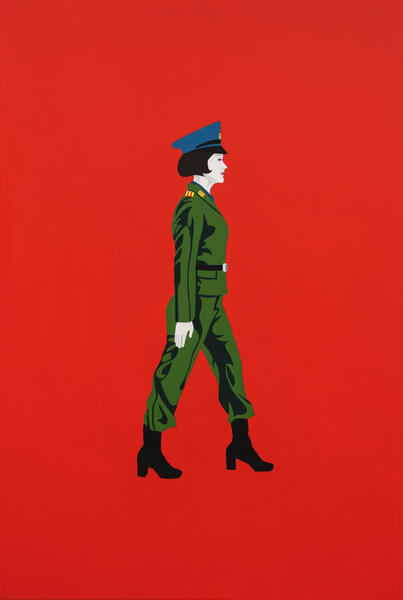 11
11
HAPPY NORTH KOREAN CHILDREN
Solo Exhibition by Mina Cheon
June 26 – July 29, 2014
Reception Thursday, July 3, 6-8 PM
The Trunk Gallery proudly presents Mina Cheon’s Polipop (Political Pop Art) exhibition “Happy North Korean Children” from June 26 to July 29.
This exhibition shows an abstract and imaginary field of happy North Korean children, posed by Cheon’s own children Gerson and Sasha as “Kim Siun” and “Kim Sia,” characters who multiply in the digital world, assuming the identities of many happy North Korean children similarly portrayed in North Korean propaganda imagery. They are happy because of the ways in which the North Korean government presents their “Juche” ideology, blissfulness that comes from favoring social collectiveness over individuality.
In 2011, the North Korean Chosun Central Television announced the results of a new Global Happiness Index compiled by the national research team. In the report, North Korea is announced as the second happiest nation aside from big China which is supposedly the happiest due to the mere number of people; South Korea being in the 152nd place and “the American Empire” in place 203, which would not be a surprise if it was in dead last place. This world news funneled by Chinese press and media influenced the new body of work of happy North Korean children to be exhibited at the Trunk Gallery.
The theme of happy North Korean children is an extension of Cheon’s artistic persona, “Kim Il Soon,” who is a North Korean social realist painter, naval commander, farmer, scholar, and mother of two. While the Kim Il Soon character came to full life in a series of paintings in her solo exhibition “Choco·Pie Propaganda” at the Ethan Cohen New York gallery early this year, by highlighting just her children at the Trunk Gallery, Cheon animates these characters into real life, staging them in digital prints, which is the medium of our computer age. The exhibition is intended to bring awareness of the beautiful Korean children, may they be from the North or South. It is a celebration of the future of Korea and for the artist Cheon, a part of her social activism and political campaign, expressed in pop art and Polipop exhibition, promoting Korean unification and global peace.
Mina Cheon’s “Polipop: Political Pop Art” was first showcased at the Sungkok Art Museum in 2012 and looked at geopolitical issues between countries through pop art. The inspiration of the work was to bring out things often unsaid about people, lives, and places in global media culture, giving voice to those things often skewed by media such as the way North Koreans are portrayed as evil and backwards in the West. Cheon has focused on looking at the relationship between the East and West, Korea and America, Korea and Japan and China, and North and South Korea, and has done projects that deals with North Korea, Dokdo, Olympics in Asia, political and sports figures and heroes, and global pop icons.
Assuming different artistic personae in photography and new media is nothing new, there has been a plethora of artists such as American Cindy Sherman, Japanese Yasumasa Morimura, and Korean Nikki Lee to name a few who are known as appropriation artists and who have created alter egos and multiple characters to portray the diversity in postmodern identity. Cheon however, creates her North Korean artistic persona Kim Il Soon as a deliberate political move, social activism and performance.
-
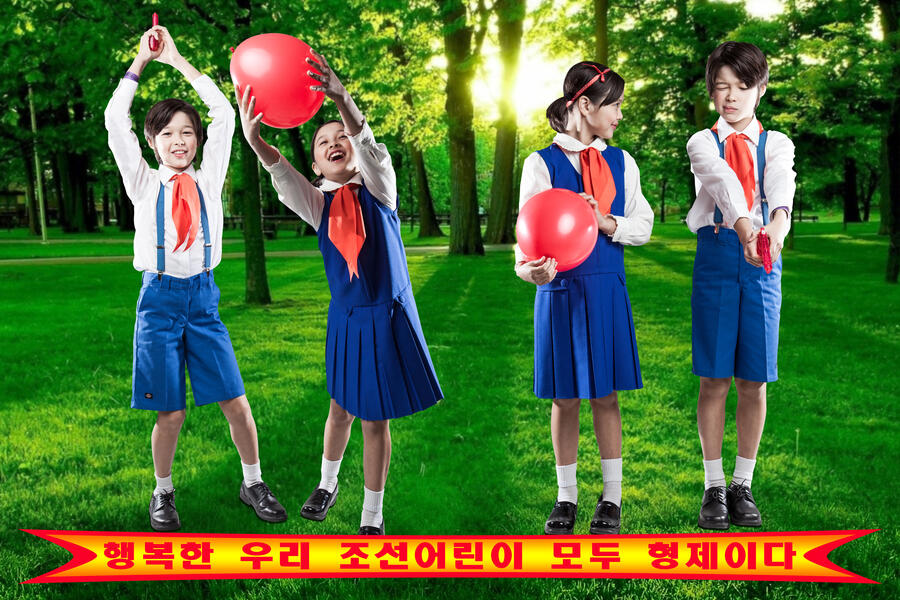 Happy Joseon SiblingsDate Work Completed: 2014 Medium: Archival digital print Size: 22 x 33 inches
Happy Joseon SiblingsDate Work Completed: 2014 Medium: Archival digital print Size: 22 x 33 inches -
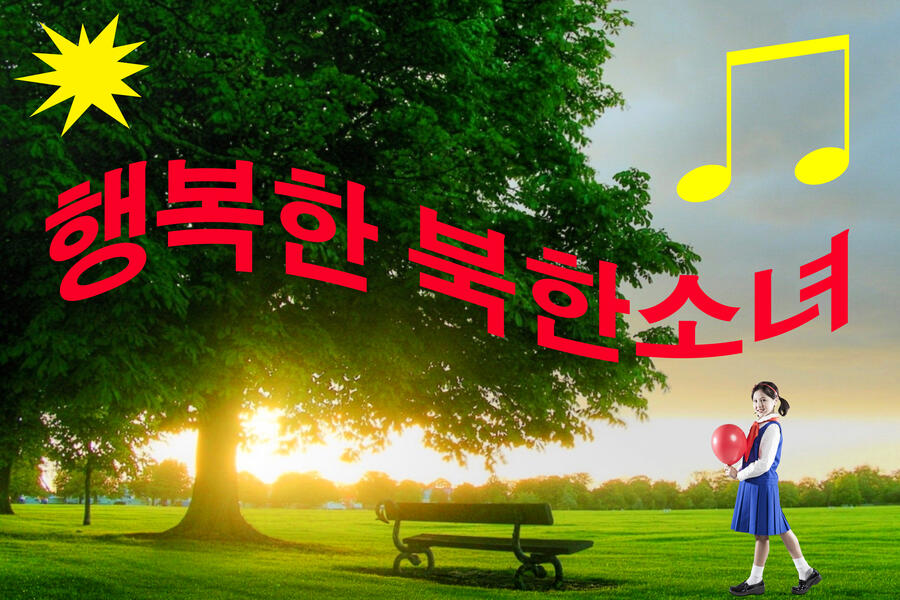 Happy North Korean Little GirlDate Work Completed: 2014 Medium: Archival digital print Size: 22 x 33 inches
Happy North Korean Little GirlDate Work Completed: 2014 Medium: Archival digital print Size: 22 x 33 inches -
 ArirangDate Work Completed: 2014 Medium: Archival digital print Size: 22 x 33 inches
ArirangDate Work Completed: 2014 Medium: Archival digital print Size: 22 x 33 inches -
 Radiant Kim SiunDate Work Completed: 2014 Medium: Archival digital print Size: 22 x 33 inches
Radiant Kim SiunDate Work Completed: 2014 Medium: Archival digital print Size: 22 x 33 inches -
 Radiant Kim SiaDate Work Completed: 2014 Medium: Archival digital print Size: 22 x 33 inches
Radiant Kim SiaDate Work Completed: 2014 Medium: Archival digital print Size: 22 x 33 inches -
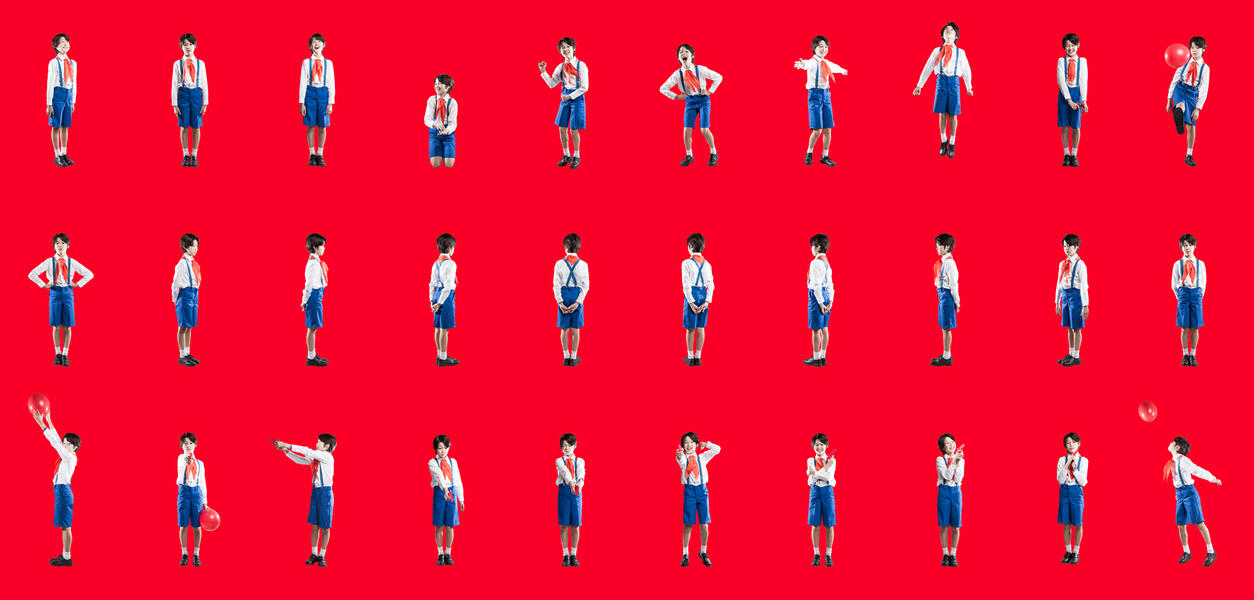 Happy North Korean Children 2-3Date Work Completed: 2014 Medium: Archival digital print Size: 44 x 91 inches
Happy North Korean Children 2-3Date Work Completed: 2014 Medium: Archival digital print Size: 44 x 91 inches -
 Happy North Korean Children 2-2Date Work Completed: 2014 Medium: Archival digital print Size: 44 x 91 inches
Happy North Korean Children 2-2Date Work Completed: 2014 Medium: Archival digital print Size: 44 x 91 inches -
 Happy North Korean Children 2-1Date Work Completed: 2014 Medium: Archival digital print Size: 44 x 91 inches
Happy North Korean Children 2-1Date Work Completed: 2014 Medium: Archival digital print Size: 44 x 91 inches -
 Happy North Korean Children (Diptych)Date Work Completed: 2014 Medium: Archival digital print Size: 44 x 64 inches each
Happy North Korean Children (Diptych)Date Work Completed: 2014 Medium: Archival digital print Size: 44 x 64 inches each -
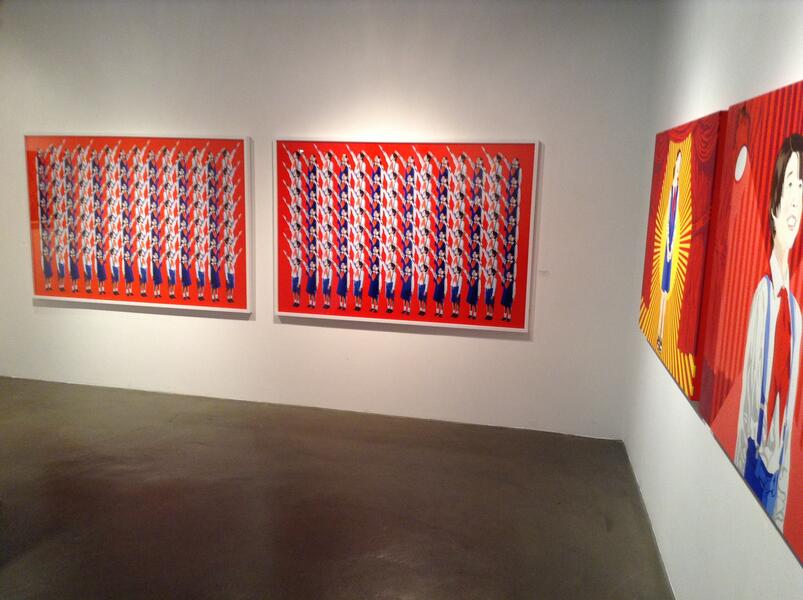 Happy North Korean ChildrenSolo Exhibition by Mina Cheon June 26 – July 29, 2014 Exhibition installation view at the Trunk Gallery, Seoul, Korea
Happy North Korean ChildrenSolo Exhibition by Mina Cheon June 26 – July 29, 2014 Exhibition installation view at the Trunk Gallery, Seoul, Korea
CHOCO·PIE PROPAGANDA
MINA CHEON AKA KIM IL SOON
From North Korea with Love
January 23 - March 1, 2014
Ethan Cohen New York
251 W. 19th St.
New York, NY 10011
Ethan Cohen New York proudly announces the solo exhibition by artist Mina Cheon aka "KIM IL SOON" in her North Korean artistic persona. Her paintings showcasing polipop (political pop art) and her installation "EAT CHOCO·PIE TOGETHER" open Thursday, January 23, 2014 at 6 pm at Ethan Cohen New York, 251 West 19th Street in New York City.
Kim Il Soon is a concept born of the necessity to promote global peace and Korean reunification. Her name purports to link her to the leadership of the Democratic People’s Republic of Korea. She claims to be a nationally recognized DPRK artist as well as a Lieutenant Commander, scholar, devout citizen, hardworking farmer, mother of two, and most importantly, a human being. She vows to continue her artistic propaganda campaign until Korean reunification, if not world peace.
The exhibition is comprised of Kim Il Soon’s North Korean social realist paintings and an installation that covers the entire lower level of the gallery with “Choco·Pie,” a South Korean moonpie-like confectionary manufactured by the company Orion. It has become an overnight sensation in North Korea as a smuggled snack. The Orion Corporation has sponsored this exhibition with 10,000 Choco·Pie in support of the idea that we must “Eat Choco·Pie Together” in order to take steps towards Korean reunification. Choco·Pie has become the most sought after consumer object in North Korea ever since South Koreans donated Choco·Pies to North Korean workers at the jointly managed Kaesong Industrial Complex. It has thus become a symbol of Korean cooperation.
The artist has selected Choco·Pie packaging which contains the traditional character “Jung”, a symbol of love and friendship. By eating Choco·Pie, the American audience can participate in building Korean friendship and awareness of North Korea.
The artist has produced a series of social realist paintings on canvas and watercolors on paper that promote the polipop campaign, which will be on view at the gallery. Additionally she has produced buttons with the slogans “Squirt Water, Not Bullets” and “Make Art, Not Missiles”.
Commentary on Artist Organized Art by Mina Cheon
Critical POLIPOP (Political Pop Art) of Our Mass Consumption Societies
IT IS A SWEET CHOCO·PIE REVOLUTION
Choco·Pie Propaganda: From North Korea with Love
At Ethan Cohen Fine Arts NYC
With the advent of recent UN documents exposures of North Korea’s human rights treatment, our attention to North Korea is more important now than ever. A controversial exhibition that has aroused a diverse range of patriotic sentiments from many Koreans & More, “Choco·Pie Propaganda: From North Korea with Love” is showing at Ethan Cohen Fine Arts, New York (251 W 19 St, NY 10011).
Come and participate in the North Korean political pop art campaign,“EAT CHOCO·PIE TOGETHER,” promoting Korean reunification and global peace.
Art in America: “If you liked Sots Art from Russia (with irony) and Political Pop from China, you’ll feel right at home with these paintings and watercolors, nearly all bright self-portrait parodies of the most propagandistic strain of Socialist Realism. The twist here is that Cheon, a Korean-American artist, has adopted the North Korean persona of Kim Il Soon-farmer, mother, scholar, soldier, artist and distant relative of the nation’s Beloved Leader. Downstairs is a spreading pile of Choco Pie treats, a highly prized form of contraband in the People’s Democratic Republic and a symbol, due to their South Korean origin, of potential reunification.” (Art in America, Lookout)
Post Minjoong Misool And Artist Mina Cheon
A new form of Post Minjoong feminist art has emerged by artist Mina Cheon, who’s practice, Polipop (political pop art) which is also art as activism, aligns with the strong lineage of Minjoong Misool, the politically charged art which emerged in the 1980's democratic movement of South Korea. Paying homage to famous South Korean Minjoong artists such as Lim Oksang and the plethora of primary feminist artists of this era, such as DjinSuk Kim, YunSuknam, Kim In Soon, and Park Youngsook, Mina Cheon (???) aka Kim Il Soon exposes her newest Polipop work, “Choco·Pie Propaganda” at Ethan Cohen New York (through February 28). Ms. Cheon’s Chelsea NYC gallery represents an international hot list of Asian contemporary political-pop artists. She is also exhibiting at South Korea’s Trunk Gallery in Seoul (June 26 – July 29), the leading photography and new media gallery directed by Park Youngsook.
In Cheon’s artist statement released on January 23rd, she writes, “As a Korean, the idea of having two artistic identities, South Korean Mina Cheon and North Korean Kim Il Soon, is an obvious reflection on the country’s state of being divided. It makes all the sense in the world that if a country is split so should be the artist in practice… …While the Korean peninsula may be demarcated by a 38th Parallel, the Demilitarized Zone (DMZ), the history and culture is nevertheless shared, the country is united by one country’s people and language. Moreover, Korea is ubiquitously tied by the never-ending heated debate on reunification and national identity, whether we are at war, armistice, trade, or peace. This is our business.”
The exhibition “Choco·Pie Propaganda” is comprised of Kim Il Soon’s North Korean social realist paintings and an installation that covers the entire lower level gallery with “Choco·Pie,” a South Korean moonpie-like confectionary manufactured by the company Orion. Choco·Pie is an overnight sensation in North Korea. It is smuggled in as a favorite snack. The Orion Corp. has kindly donated 10,000 individually wrapped Choco·Pie cakes in support of Cheon’s Choco·Pie installation, “Eat Choco·Pie Together,” and her call for Korean reunification. The January 23rd opening at Ethan Cohen New York included the artist’s recital of 55 special ways of saying Dear Leader in North Korea. In only three days a Choco·Pie sensation has gone viral, as reported in the Choco·Pie coverage of CNN.
Mina Cheon Studio would like to acknowledge the Orion Co. of South Korea with a special thank you for the kind donation of 10,000 Choco·Pies for the artist’s installation “Eat Choco·Pie Together” currently showing at the Ethan Cohen Gallery in New York.
-
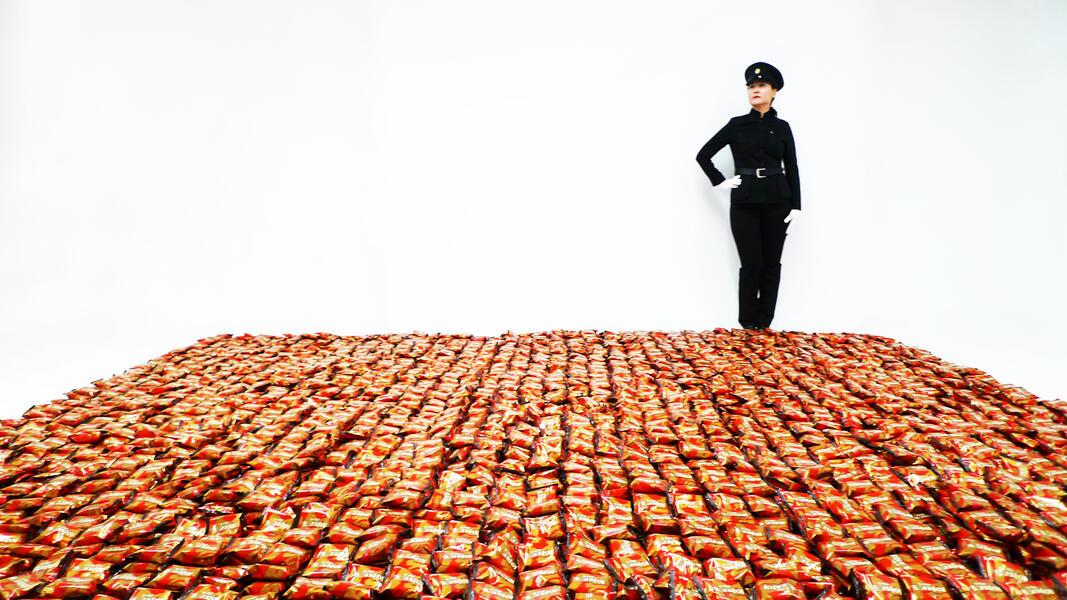 Eat Choco-Pie Together10,000 Choco-Pie Installation (with pose by Mina Cheon aka Kim Il Soon) 153 x 159 x 5 inches Site specific, interactive, audience participation installation Sponsored by Orion Co., Korea And, whose Choco·Pie is it? The installation of 10,000 Choco·Pie for the audience to eat was kindly donated by Orion Co. in support of the installation Eat Choco·Pie Together that promotes Korean reunification and global peace. Kim Il Soon unconsciously exposed to the outside world, had her Duchampian moment of making a good decision. Duchamp selects a toilet and she selects a relevant intercultural consumer object of our time, the Choco·Pie. This South Korean moon pie-like confectionary has become an overnight sensation in North Korea as a smuggled favorite snack and is worth three bowls of rice, and favored especially by the elite class North Korean women. Comparable to the American Twinkie, Choco·Pie has been sought after in North Korea, ever since South Koreans gifted Choco·Pie to the North Korean laborers at the Kaesong Industrial Complex as a token of appreciation. Symbolically, the Choco·Pie has opened up North Korea and formed a loving exchange between the North and South, something that even the Korean governments have failed to do. Truly this is a postmodern co-national co-operation, one that is a viral and an addictive kind. The Chinese character “Jung” on the packaging means love and friendship. Choco·Pie is ours to eat, for North and South Korea, and for America – Let’s Eat Choco·Pie Together – for “Han guk” means “one country,” not Republic of Korea, not Democratic People’s Republic of Korea. This is a “Sweet Revolution.” The exhibition “CHOCO·PIE PROPAGANDA: From North Korea with Love” by Mina Cheon aka Kim Il Soon was shown at Ethan Cohen New York (ECNY), January 28 - March 1, 2014. ECNY is located on 251 W. 19th St, between 7 and 8th Ave, New York, NY 10011. http://www.ecfa.com/
Eat Choco-Pie Together10,000 Choco-Pie Installation (with pose by Mina Cheon aka Kim Il Soon) 153 x 159 x 5 inches Site specific, interactive, audience participation installation Sponsored by Orion Co., Korea And, whose Choco·Pie is it? The installation of 10,000 Choco·Pie for the audience to eat was kindly donated by Orion Co. in support of the installation Eat Choco·Pie Together that promotes Korean reunification and global peace. Kim Il Soon unconsciously exposed to the outside world, had her Duchampian moment of making a good decision. Duchamp selects a toilet and she selects a relevant intercultural consumer object of our time, the Choco·Pie. This South Korean moon pie-like confectionary has become an overnight sensation in North Korea as a smuggled favorite snack and is worth three bowls of rice, and favored especially by the elite class North Korean women. Comparable to the American Twinkie, Choco·Pie has been sought after in North Korea, ever since South Koreans gifted Choco·Pie to the North Korean laborers at the Kaesong Industrial Complex as a token of appreciation. Symbolically, the Choco·Pie has opened up North Korea and formed a loving exchange between the North and South, something that even the Korean governments have failed to do. Truly this is a postmodern co-national co-operation, one that is a viral and an addictive kind. The Chinese character “Jung” on the packaging means love and friendship. Choco·Pie is ours to eat, for North and South Korea, and for America – Let’s Eat Choco·Pie Together – for “Han guk” means “one country,” not Republic of Korea, not Democratic People’s Republic of Korea. This is a “Sweet Revolution.” The exhibition “CHOCO·PIE PROPAGANDA: From North Korea with Love” by Mina Cheon aka Kim Il Soon was shown at Ethan Cohen New York (ECNY), January 28 - March 1, 2014. ECNY is located on 251 W. 19th St, between 7 and 8th Ave, New York, NY 10011. http://www.ecfa.com/ -
 1.5
1.5 -
 Happy North Korean Little BoyDate Work Completed: 2013-2014 Medium: acrylic on canvas Size: 36 x 48 x 1.5 inches Description: This is Kim Il Soon’s son Kim Siun, the first of the two siblings, singing on stage as a devoted happy North Korean little boy.
Happy North Korean Little BoyDate Work Completed: 2013-2014 Medium: acrylic on canvas Size: 36 x 48 x 1.5 inches Description: This is Kim Il Soon’s son Kim Siun, the first of the two siblings, singing on stage as a devoted happy North Korean little boy. -
 Happy North Korean Little GirlDate Work Completed: 2013-2014 Medium: acrylic on canvas Size: 36 x 48 x 1.5 inches Description: Kim Il Soon is blessed with two children, daughter Kim Sia and son Kim Siun. She does not have a husband since she is married to the nation, and by default married to the Dear Leader. This is her daughter Kim Si-a, singing on stage as a devoted happy North Korean little girl.
Happy North Korean Little GirlDate Work Completed: 2013-2014 Medium: acrylic on canvas Size: 36 x 48 x 1.5 inches Description: Kim Il Soon is blessed with two children, daughter Kim Sia and son Kim Siun. She does not have a husband since she is married to the nation, and by default married to the Dear Leader. This is her daughter Kim Si-a, singing on stage as a devoted happy North Korean little girl. -
 1784 Chateau Lafite Bordeaux detail
1784 Chateau Lafite Bordeaux detail -
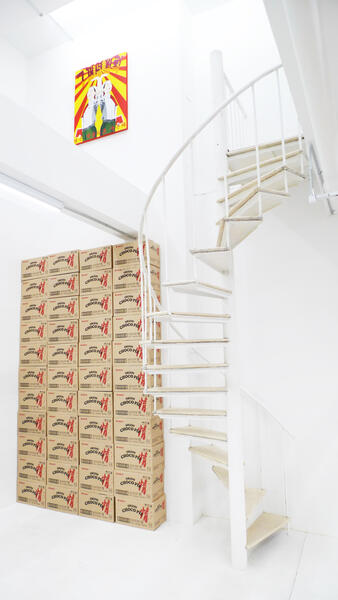 CHOCO·PIE PROPAGANDAExhibition images at Ethan Cohen New York Gallery, January 28 - March 1, 2014 Stacks of boxes that housed the 10,000 Choco-Pies that came from Orion Co. Korea. Reference: Andy Warhol Brillo Boxes
CHOCO·PIE PROPAGANDAExhibition images at Ethan Cohen New York Gallery, January 28 - March 1, 2014 Stacks of boxes that housed the 10,000 Choco-Pies that came from Orion Co. Korea. Reference: Andy Warhol Brillo Boxes -
 Eat Choco-Pie Together10,000 Choco-Pie Installation (gallery installation shot at Ethan Cohen New York Gallery) 153 x 159 x 5 inches Site specific, interactive, audience participation installation Sponsored by Orion Co., Korea
Eat Choco-Pie Together10,000 Choco-Pie Installation (gallery installation shot at Ethan Cohen New York Gallery) 153 x 159 x 5 inches Site specific, interactive, audience participation installation Sponsored by Orion Co., Korea -
 Eat Choco-Pie TogetherAt the Ethan Cohen New York gallery, Alongside paintings hung on the walls, the installation of Choco·Pies for the audience to eat promotes Korean unification and global peace through a Gonzalez-Torres style floor piece. The food is a South Korean confectionary has become an overnight sensation in North Korea as a smuggled good. 10,000 Choco-Pie Installation (gallery installation shot at Ethan Cohen New York Gallery) 153 x 159 x 5 inches Site specific, interactive, audience participation installation Sponsored by Orion Co., Korea
Eat Choco-Pie TogetherAt the Ethan Cohen New York gallery, Alongside paintings hung on the walls, the installation of Choco·Pies for the audience to eat promotes Korean unification and global peace through a Gonzalez-Torres style floor piece. The food is a South Korean confectionary has become an overnight sensation in North Korea as a smuggled good. 10,000 Choco-Pie Installation (gallery installation shot at Ethan Cohen New York Gallery) 153 x 159 x 5 inches Site specific, interactive, audience participation installation Sponsored by Orion Co., Korea -
 Eat Choco-Pie TogetherDate Work Completed: 2014 Medium: 10,000 Choco-Pie Installation Site specific, interactive, audience participation installation Size: 153 x 159 x 5 inches Description: At the Ethan Cohen New York gallery, Alongside paintings hung on the walls, the installation of Choco·Pies for the audience to eat promotes Korean unification and global peace through a Gonzalez-Torres style floor piece. The food is a South Korean confectionary has become an overnight sensation in North Korea as a smuggled good. Other: Choco-Pies were kindly donated by the South Korean manufacturing company Orion Co.
Eat Choco-Pie TogetherDate Work Completed: 2014 Medium: 10,000 Choco-Pie Installation Site specific, interactive, audience participation installation Size: 153 x 159 x 5 inches Description: At the Ethan Cohen New York gallery, Alongside paintings hung on the walls, the installation of Choco·Pies for the audience to eat promotes Korean unification and global peace through a Gonzalez-Torres style floor piece. The food is a South Korean confectionary has become an overnight sensation in North Korea as a smuggled good. Other: Choco-Pies were kindly donated by the South Korean manufacturing company Orion Co. -
Kim Il Soon RecitalPerformance reciting at least 55 ways to say Dear Leader in North Korea by Mina Cheon aka Kim Il Soon, at Ethan Cohen New York Gallery, 2014. Alongside the paintings, the artist appears as Kim Il Soon to perform a mixture of Fluxus type score and political art campaign for global peace and Korean unification. The first time was during the Pulse Art Fair NY 2013, passing out peace buttons, and appeared in public spaces many times after.
POLIPOP AND PAINTINGS
Mina Cheon's Solo Exhibition at Maryland Art Place, Baltimore, Maryland
May 3 – June 30, 2012
Maryland Art Place (MAP) proudly announces Mina Cheon’s solo exhibition Polipop & Paintings, May 3 - June 30, 2012. The exhibition includes a series of digital paintings (8x5 feet each) coming from her mid-career solo exhibit Polipop (Political Pop Art) at the Sungkok Art Museum in Seoul, Korea; works that became an instant media sensation in Korea early this year.
After many years working as an installation and new media artist, the MAP solo exhibition illuminates Cheon’s background as a painter by combining her new Polipop digital paintings with her last hand-painted masterpiece, 15 Billion Years Painting. This mammoth 72x8 foot painting was created for the renowned abstract-expressionist painter Grace Hartigan between 1997 -1998 while Cheon worked with her at the Hoffberger School of Painting at the Maryland Institute College of Art (MICA). Produced through the use of florescent acrylic on canvas, and lit under black light, MAP is showcasing this work for the first time under natural light. The 15 Billion Years painting is a celebration of popular science and a cosmic portrayal of the Universe. The painting was also the starting point of her artistic development. Cheon’s career communicates the relevance of working relationships between artist, institution and instructor over time, and the significance thereof.
Polipop is an art world that intersects politics and pop art. It takes serious discussions surrounding geopolitics of global, media culture and livens them up as accessible, eye-catching, fun pop art. With the use of strong primary colors and bold outlines, Cheon’s large scaled digital paintings mimic the language of advertisements, political posters, and propaganda banners. Each unique digital painting is collaged with images from the Internet, rescaled on the computer, and printed on canvas.
Some History:
In 2004, Cheon showed at the first Athena’s Daughters exhibition curated by Grace Hartigan for Maryland Art Place, where Cheon’s very first “political pop art” Half Moon Eyes documented her visitation to North Korea. This visit highlighted Cheon’s interest in political construction on beauty, and the triangular relationship between America and North and South Korea.
By 2008, Cheon’s Addressing Dolls exhibition at the C.Grimaldis Gallery in Baltimore portrayed the stark contrast between communist North Korea and capitalist South Korea through girls’ playthings; Cheon exhibited her North Korean doll installation 99 Miss Kim(s) on one side and a series of South Korean life-size paper doll dresses Dresses for Different Events on the other.
Since Cheon’s visit to North Korea in 2004, she traveled to places she considered ‘contested spaces,’ where geo-political anxieties demonstrated conflicts between neighboring, yet rivalry Asian countries. Cheon went to Japan during the 2008 Summer Olympics in China specifically to interview Japanese people about their thoughts of the Olympics in Beijing. Cheon also traveled to Dokdo in 2009, a contested island that sits between Korea and Japan, an island that is still territorially fought over today. The documents of these trips are included in her new body of work that constantly questions the relationship between the East and West, as well as the relationship between Asian countries such as South and North Korea, Japan, and China.
Today Cheon uses the plethora of images of President Barack Obama as Polipop. Drawing comparisons to Chairman Mao in China, Cheon refers to Obama as the Polipop icon of our time. From the iconic American President and the war in the Middle East, to the rise of the Asian Century and circulation of global media, the exhibition includes digital paintings on Obama, race, pop culture, technology, capitalism, and Asia.
Unlike many Asian students coming to and leaving Baltimore for study, Korean-American new media artist, Cheon stayed in Baltimore becoming part of the faculty at MICA; living between Baltimore, New York, and Seoul – three cities, which she considers home. This year, Cheon presents three consecutive solo exhibitions in these cities; MAP being the second installment after the Sungkok Art Museum exhibition earlier this year. Cheon will end 2012 this fall at the White Box in New York City. All three exhibitions include the Polipop title and theme, however Cheon keeps a sense of individuality between each.
From her time with Grace Hartigan to how Cheon situated herself in Baltimore; her course towards the creation of Polipop was charted. Cheon’s artistic history cannot go unnoticed and as Hartigan once said to Cheon in 1998, “if anything, it is because you are a painter first.”
Available at MAP: POLIPOP exhibition catalog from the Sungkok Art Musum (Seoul, Korea, 2012) that includes writings from the Sungkok Art Museum’s chief curator Tcheon-nahm Park; art historian and scholar on race and culture, Leslie King-Hammond; cyber-feminist scholar Irina Aristarkhova; and cultural critic Pamela Haag. The catalog includes full color pages of Cheon’s digital paintings and her other video and sculptural installation works and is 170-page artist catalog. The exhibition at the Sungkok Art Museum that is documented in this catalog was covered in many Korean daily news, the Internet, radio, and television broadcast news including Korean Broadcasting (KBS), Seoul Broadcasting Station (SBS), YTN Korean 24 Hours News Channel, TV Chosun (Korea), and the English channel Korea’s Global TV Arirang.
Maryland Art Place
8 Market Place #100, Baltimore, MD 21202
(410) 962-8565
-
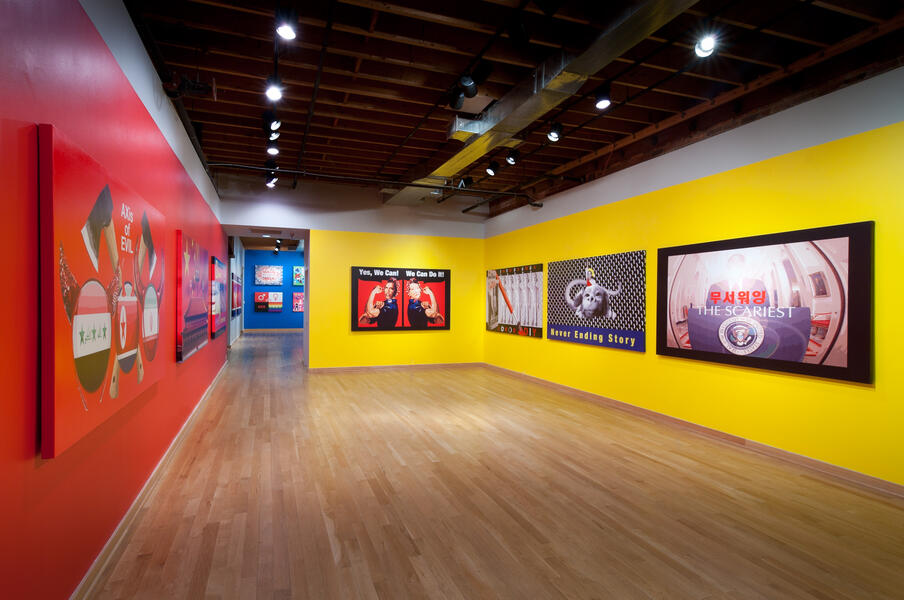 Polipop and Paintings15 of Mina Cheon's Polipop Digital Paintings (8x5 feet each) from Korea were shipped over for a newly curated Polipop exhibitions at Maryland Art Place, the second of the Polipop exhibition series. This exhibition highlights Cheon's background as a painter and includes selections of digital paintings along side her last hand painting 15 Billion Years of the Traveling Atom, 5 sections that culminate in a 72 x 8 feet long painting. This gallery shot shows, three primary colors and digital paintings in the themes of Obama and the war, relationship between East and West.
Polipop and Paintings15 of Mina Cheon's Polipop Digital Paintings (8x5 feet each) from Korea were shipped over for a newly curated Polipop exhibitions at Maryland Art Place, the second of the Polipop exhibition series. This exhibition highlights Cheon's background as a painter and includes selections of digital paintings along side her last hand painting 15 Billion Years of the Traveling Atom, 5 sections that culminate in a 72 x 8 feet long painting. This gallery shot shows, three primary colors and digital paintings in the themes of Obama and the war, relationship between East and West. -
 Polipop and Paintings15 of Mina Cheon's Polipop Digital Paintings (8x5 feet each) from Korea were shipped over for a newly curated Polipop exhibitions at Maryland Art Place, the second of the Polipop exhibition series. This exhibition highlights Cheon's background as a painter and includes selections of digital paintings along side her last hand painting 15 Billion Years of the Traveling Atom, 5 sections that culminate in a 72 x 8 feet long painting. This gallery shot shows digital paintings in the themes of Obama and the war.
Polipop and Paintings15 of Mina Cheon's Polipop Digital Paintings (8x5 feet each) from Korea were shipped over for a newly curated Polipop exhibitions at Maryland Art Place, the second of the Polipop exhibition series. This exhibition highlights Cheon's background as a painter and includes selections of digital paintings along side her last hand painting 15 Billion Years of the Traveling Atom, 5 sections that culminate in a 72 x 8 feet long painting. This gallery shot shows digital paintings in the themes of Obama and the war. -
 Polipop and Paintings15 of Mina Cheon's Polipop Digital Paintings (8x5 feet each) from Korea were shipped over for a newly curated Polipop exhibitions at Maryland Art Place, the second of the Polipop exhibition series. This exhibition highlights Cheon's background as a painter and includes selections of digital paintings along side her last hand painting 15 Billion Years of the Traveling Atom, 5 sections that culminate in a 72 x 8 feet long painting. This gallery shot shows digital paintings that looks at the relationship between East and West.
Polipop and Paintings15 of Mina Cheon's Polipop Digital Paintings (8x5 feet each) from Korea were shipped over for a newly curated Polipop exhibitions at Maryland Art Place, the second of the Polipop exhibition series. This exhibition highlights Cheon's background as a painter and includes selections of digital paintings along side her last hand painting 15 Billion Years of the Traveling Atom, 5 sections that culminate in a 72 x 8 feet long painting. This gallery shot shows digital paintings that looks at the relationship between East and West. -
 Polipop and Paintings15 of Mina Cheon's Polipop Digital Paintings (8x5 feet each) from Korea were shipped over for a newly curated Polipop exhibitions at Maryland Art Place, the second of the Polipop exhibition series. This exhibition highlights Cheon's background as a painter and includes selections of digital paintings along side her last hand painting 15 Billion Years of the Traveling Atom, 5 sections that culminate in a 72 x 8 feet long painting. This gallery shot shows, large digital paintings with the themes of capitalism and the environment, while a new series of six smaller Polipop digital paintings at the size of 4 x 3 feet were created just for the exhibition at MAP.
Polipop and Paintings15 of Mina Cheon's Polipop Digital Paintings (8x5 feet each) from Korea were shipped over for a newly curated Polipop exhibitions at Maryland Art Place, the second of the Polipop exhibition series. This exhibition highlights Cheon's background as a painter and includes selections of digital paintings along side her last hand painting 15 Billion Years of the Traveling Atom, 5 sections that culminate in a 72 x 8 feet long painting. This gallery shot shows, large digital paintings with the themes of capitalism and the environment, while a new series of six smaller Polipop digital paintings at the size of 4 x 3 feet were created just for the exhibition at MAP. -
 Polipop and PaintingsThis gallery shot shows, large digital paintings looking at the relationship between North and South Korea. This image shows the relationship between the rooms at Maryland Art Place and the entering point into the 15 Billion Years painting project.
Polipop and PaintingsThis gallery shot shows, large digital paintings looking at the relationship between North and South Korea. This image shows the relationship between the rooms at Maryland Art Place and the entering point into the 15 Billion Years painting project. -
 15 Billion Years of the Traveling AtomFull gallery shots of 15 Billion Years of the Traveling Atom painting, 72 x 8 feet, acrylic on canvas, originally painted in 1997-8, restored and newly installed and first time under daylight viewing without black light.
15 Billion Years of the Traveling AtomFull gallery shots of 15 Billion Years of the Traveling Atom painting, 72 x 8 feet, acrylic on canvas, originally painted in 1997-8, restored and newly installed and first time under daylight viewing without black light. -
 Polipop and Paintings, Maryland Art Place, gallery shot showing Mina Cheon's Painting 15 Billion Years of the Traveling AtomFull gallery shots of 15 Billion Years of the Traveling Atom painting, 72 x 8 feet, acrylic on canvas, originally painted in 1997-8, restored and newly installed and first time under daylight viewing without black light.
Polipop and Paintings, Maryland Art Place, gallery shot showing Mina Cheon's Painting 15 Billion Years of the Traveling AtomFull gallery shots of 15 Billion Years of the Traveling Atom painting, 72 x 8 feet, acrylic on canvas, originally painted in 1997-8, restored and newly installed and first time under daylight viewing without black light. -
 15 Billion Years of the Traveling Atom under Black LightMina Cheon's 15 Billion Years of the Traveling Atom under Black Light at Maryland Art Place, June 7, 2012 As part of Mina Cheon’s Polipop & Paintings exhibition, Maryland Art Place (MAP) will hold a one-day event, which will illuminate Mina Cheon’s last hand-painted masterpiece, 15 Billion Years of the Traveling Atom under black light. This mammoth 72x8 foot hand painting was created for the renowned abstract-expressionist painter Grace Hartigan between 1997 -1998 while Cheon worked with her at the Hoffberger School of Painting at the Maryland Institute College of Art (MICA). Produced through the use of florescent acrylic on canvas, the piece was originally lit under black light and was presented with the inclusion of performance art and bubbles. MAP is currently showcasing this work for the first time under natural light, but will host a one-day only homage to the paintings original presentation nearly 15 years ago. The 15 Billion Years painting is a celebration of popular science and a cosmic portrayal of the Universe. While at the gallery, viewers will also have the opportunity to spend time with Cheon’s current ‘Polipop’ works. Polipop is an art world that intersects politics and pop art. It takes serious discussions surrounding geopolitics of global, media culture and livens them up as accessible, eye - catching, provocative Pop Art. Cheon’s exhibition includes a series of digital paintings (8x5 feet each) coming from Cheon’s mid-career, solo exhibit at the Sungkok Art Museum in Seoul, Korea. When asked about North Korea, global media, and world politics, Cheon explains, “At the end of 2011, I was in Seoul, Korea when North Korean leader Kim Jong-il passed away. There was a great deal of sadness and empathy amongst the South Koreans about the passing of North Korean's great father. This sentiment did not get across into global media and especially Western and American media. As always, one's national grief is never the business of other nations, especially when there are imperial motives and political agendas at play, but as such, while many South Koreans remembers their family members who still reside in North Korea, the rest of the world seems to be amused at the failure of North Korea. As a Korean-American, I cannot neglect the sadness behind our country's division, and know that one cannot solely blame North Korea. Korea sits between capitalist Japan and communist China, it is already between two dividing westernized Asian countries. While, the split between North and South Korea can be seen as a relic of the cold war, there is also the more immediate neighboring geography that says it all. As a contemporary Asian artist working in global times, it is imperative to look at these co-national geo-politics and respond to how global media shapes or skews our perception on how a nation is (in)formed or disregarded.” Mina Cheon and Polipop and Paintings, have been featured in Voice of America (radio aired to North Korea on May 22), The Signal (WYPR, NPR) with Aaron Henkins, The Washington Korea Times, Artist Organized Art, Urbanite, The Sun Paper, and the Jewish Times. Maryland Art Place 8 Market Place #100, Baltimore, MD 21202 (410) 962-8565
15 Billion Years of the Traveling Atom under Black LightMina Cheon's 15 Billion Years of the Traveling Atom under Black Light at Maryland Art Place, June 7, 2012 As part of Mina Cheon’s Polipop & Paintings exhibition, Maryland Art Place (MAP) will hold a one-day event, which will illuminate Mina Cheon’s last hand-painted masterpiece, 15 Billion Years of the Traveling Atom under black light. This mammoth 72x8 foot hand painting was created for the renowned abstract-expressionist painter Grace Hartigan between 1997 -1998 while Cheon worked with her at the Hoffberger School of Painting at the Maryland Institute College of Art (MICA). Produced through the use of florescent acrylic on canvas, the piece was originally lit under black light and was presented with the inclusion of performance art and bubbles. MAP is currently showcasing this work for the first time under natural light, but will host a one-day only homage to the paintings original presentation nearly 15 years ago. The 15 Billion Years painting is a celebration of popular science and a cosmic portrayal of the Universe. While at the gallery, viewers will also have the opportunity to spend time with Cheon’s current ‘Polipop’ works. Polipop is an art world that intersects politics and pop art. It takes serious discussions surrounding geopolitics of global, media culture and livens them up as accessible, eye - catching, provocative Pop Art. Cheon’s exhibition includes a series of digital paintings (8x5 feet each) coming from Cheon’s mid-career, solo exhibit at the Sungkok Art Museum in Seoul, Korea. When asked about North Korea, global media, and world politics, Cheon explains, “At the end of 2011, I was in Seoul, Korea when North Korean leader Kim Jong-il passed away. There was a great deal of sadness and empathy amongst the South Koreans about the passing of North Korean's great father. This sentiment did not get across into global media and especially Western and American media. As always, one's national grief is never the business of other nations, especially when there are imperial motives and political agendas at play, but as such, while many South Koreans remembers their family members who still reside in North Korea, the rest of the world seems to be amused at the failure of North Korea. As a Korean-American, I cannot neglect the sadness behind our country's division, and know that one cannot solely blame North Korea. Korea sits between capitalist Japan and communist China, it is already between two dividing westernized Asian countries. While, the split between North and South Korea can be seen as a relic of the cold war, there is also the more immediate neighboring geography that says it all. As a contemporary Asian artist working in global times, it is imperative to look at these co-national geo-politics and respond to how global media shapes or skews our perception on how a nation is (in)formed or disregarded.” Mina Cheon and Polipop and Paintings, have been featured in Voice of America (radio aired to North Korea on May 22), The Signal (WYPR, NPR) with Aaron Henkins, The Washington Korea Times, Artist Organized Art, Urbanite, The Sun Paper, and the Jewish Times. Maryland Art Place 8 Market Place #100, Baltimore, MD 21202 (410) 962-8565 -
 Mina Cheon's 15 Billion Years of the Traveling Atom under Black Light at Maryland Art PlaceOne evening event: painting shown under black light to show the florescence in acrylic painting. June 7, 2012. The five sectioned painting totals 72 x 8 feet, it was originally painted in 1997-8 and brought out, restored, and newly installed at Maryland Art Place during Mina Cheon's exhibition Polipop and Paintings, May - June, 2012.
Mina Cheon's 15 Billion Years of the Traveling Atom under Black Light at Maryland Art PlaceOne evening event: painting shown under black light to show the florescence in acrylic painting. June 7, 2012. The five sectioned painting totals 72 x 8 feet, it was originally painted in 1997-8 and brought out, restored, and newly installed at Maryland Art Place during Mina Cheon's exhibition Polipop and Paintings, May - June, 2012. -
 Mina Cheon's 15 Billion Years of the Traveling Atom under Black Light at Maryland Art PlaceOne evening event: painting shown under black light to show the florescence in acrylic painting. June 7, 2012. The five sectioned painting totals 72 x 8 feet, it was originally painted in 1997-8 and brought out, restored, and newly installed at Maryland Art Place during Mina Cheon's exhibition Polipop and Paintings, May - June, 2012.
Mina Cheon's 15 Billion Years of the Traveling Atom under Black Light at Maryland Art PlaceOne evening event: painting shown under black light to show the florescence in acrylic painting. June 7, 2012. The five sectioned painting totals 72 x 8 feet, it was originally painted in 1997-8 and brought out, restored, and newly installed at Maryland Art Place during Mina Cheon's exhibition Polipop and Paintings, May - June, 2012.
POLIPOP: POLITICAL POP ART
Mina Cheon's Solo Exhibition at Sungkok Art Museum, Seoul, South Korea
January 12 – March 11, 2012
Korean-American new media artist Mina Cheon showcases POLIPOP (Political Pop Art) at the Sungkok Art Museum in Seoul, the first of three installments of Cheon’s consecutive solo-exhibitions to be held in 2012. After Seoul, Polipop projects will show at the Maryland Art Place in Baltimore and White Box in New York City.
Polipop is a compilation of artistic research that intersects politics and pop art that looks at contested spaces and geopolitics of global media culture. Through a postcolonial perspective, Cheon instigates the relationship between the East and West, as well as the relationship between Asian countries such as South and North Korea, and Korea, Japan, and China.
As once occurred with Chairman Mao, today’s plethora of images of President Barack Obama are political pop, hence Cheon highlights Obama as the polipop icon of our time. Cheon dedicates a gallery in the museum to him, thematically dividing the show into three large themes that reflect today’s political pop culture. The museum show includes the Obama Room, the Dokdo Room, and the Diamond Room. From the iconic American President and the War in the Middle East to the rise of the Asian Century and circulation of global media, the exhibition includes artworks on Obama, race, pop culture, technology, and capitalism.
Cheon’s Polipop includes more than 50 new pieces. There are over 40 new 8x5 feet digital paintings that look like propaganda banners gone pop art; animation of Obama dancing to Ally McBeal’s dancing baby “Ooga Chaka” song; video installation of traveling to Dokdo island, the contested island that sits between Korea and Japan, both physically by boat and virtually through Google Earth, Second Life, and Dokdo Internet virtual tours; and a mirrored room of massive light installation in the shape of diamonds. Image a Day: Occupy 2011 is an installation made of digital photo frames which rotates 365 images selected from the Internet (one image per day) to document global events all throughout 2011.In a glance, 2011 begins with the up rise in Egypt and ends with Occupy Demonstrations all over the world, with some other media worthy events such as the British Royal Wedding, Japan’s Tsunami and nuclear crisis, on-going global natural disasters, and the passing of Steve Jobs and Kim Jong-il.
The exhibition catalog includes writings from the Sungkok Art Museum’s chief curator Tcheon-nahm Park; art historian and scholar on race and culture, Leslie King-Hammond; cyber-feminist scholar Irina Aristarkhova; and cultural critic Pamela Haag.
Cheon’s interest in political pop art began in 2004 when she visited the North Korea’s Mt. Kumkangsan and made artwork about the Korean Demilitarized Zone, and continued as she traveled to Japan during the 2008 Summer Olympics in China specifically to interview Japanese people what they thought of the Olympics in Beijing, and highlighted while traveling to Doko in 2009, the contested island that sits between Korea and Japan.
Sungkok Art Museum
1-101 Shinmoon-ro 2ga, Jongro-gu, SEOUL 110-062, KOREA
T. +82 (0)2 737 7650
http://www.sungkokmuseum.com
"Polipop" (Artist Statement)
In my mind, a whole world of political pop art exists in the art world but has not yet been fully historicized. Political pop is a style of its own. It ranges from Andy Warhol’s Electric Chair to Barbara Kruger’s interplay between image and text to the array of contemporary Chinese artists and the abundant pop imagery of chairman Mao. It also describes Wang Guangyi, who is known as a “political pop artist,” as exemplified by Coca-Cola (1990-1993), part of The Great Criticism Series that responds to the westernization of communist China. Chinese contemporary artist Ai Weiwei himself has risen as a cultural political pop icon due to the controversy surrounding his arrest by the Chinese government, in turn, artists around the world created politically charged pop artwork to demonstrate for his release, hence bearing witness to unforeseen polipop culture in the making.
As once happened with chairman Mao however, today’s plethora of images of Obama are by far the most exceedingly political pop, making him and his image the polipop icon of our time. Certainly Shepard Farie’s Obama poster is the ultimate political pop image, but Joyce Scott’s Obama White, Obama Black is more important in bringing out the racial controversies and discussions surrounding Obama’s candidacy and presidency. Scott’s piece influenced my Obama series, where, pop elements aside, the racial and class politics, the subject and content, were drawn out to the forefront of the piece.
“Polipop,” my solo exhibition at the Sungkok Art Museum in Seoul (January 13 – March 11, 2012) showcases a variety of political pop artwork. Unhindered by one strict methodology, process, or medium, the work includes everything from digital paintings, video, sculpture, and installation, all categorized as new media art. Polipop is meant to be fun. Like pop art, it takes the serious into the realm of playful and uses the language of entertainment and the kitsch. My new body of work uses primary colors. Many of the pieces are strongly outlined like propaganda posters or banners, and each image, whether it is a digital painting or a video piece, is most successful when it can simply illustrate a clear point about politics and media, the message I want to get across.
The Sungkok Museum’s Main Building has three large galleries, all three spaces totaling around 5000 square feet, and each gallery consists of distinct themes related to political pop art. Gallery 1 is the “Obama Room,” celebrating the icon of polipop, President Barack Obama; Gallery 2 is the “Dokdo Room,” looking at national conflicts between neighboring Asian countries such as North and South Korea, Japan, and China; and Gallery 3 is the “Diamond Room,” displaying the height of capitalism or its downfall.
Each room is characterized by one distinct installation that addresses the themes of the room, surrounded by many works that I call “Polipop digital paintings” which are installed to coincide with each theme of the rooms. The Obama Room’s walls are primarily yellow; Dokdo Room is red and blue; Diamond Room is white. Each digital painting is a glicee print on stretched canvas that was collaged by various images on the Internet, and printed at large scale of 8 x 5 feet, totaling 46 pieces to the series, 42 shown at the museum.
-
Mina Cheon Polipop Feature in Arirang, Korea's Global TVArtist Mina Cheon is featured in Korea's Global TV Arirang, English Channel, in the show Arirang Today. Cheon's mid-career solo exhibition "POLIPOP" was shown at the Sungkok Art Museum, Seoul, Korea from Jan. 12 - March 11, 2012.
-
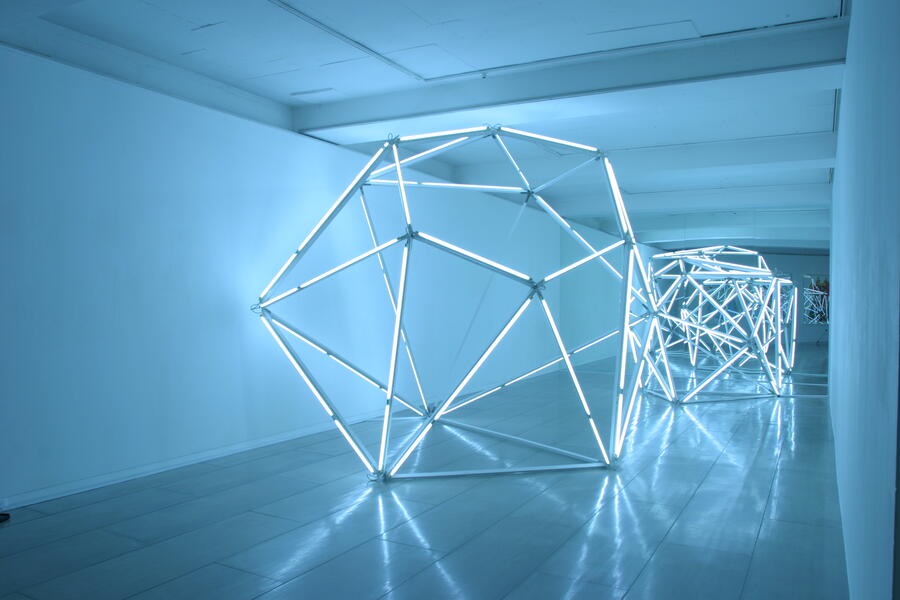 Polipop: Diamond RoomGallery view of Diamond Room, Mina Cheon's solo exhibition "Polipop," at the Sungkok Art Museum, Seoul, Korea, 2012. Mina Cheon's Polipop exhibition includes Polipop digital paintings, video and sculpture installations. This gallery view shows light installation "Diamonds R 4Ever," which is a florescent light installation in the shape of diamonds, scale is at the size of gallery, with mirror at the end wall. Collaboration with Gabriel Kroiz. Gallery 3 is the Diamond Room, which highlights capitalism at its zenith through an installation: three light sculptures in the shape of diamonds made out of thin florescent light tubes and assembled with wooden structure support. The installation Diamonds4Ever is a new version of Mina Cheon and Gabriel Kroiz, artist and architect collaborative installation, Diamonds: Will You Marry Me?, which was first installed at SSamzieGil, Seoul, in 2007, with students from MICA who had come to Korea for a summer exchange that Cheon and Kroiz co-directed called MICA Korea, with students of Korean National University of Art (KNUA). Diamonds, as one of the most valued and fantasized consumer object, can be viewed as the epitome of capitalism, but the hollowness of this structure contrasts with the permanence of diamonds and their cultural value, to highlight both aspects—both the spectacularity and the vapidity of the object. The diamond installation also comments on our world’s spiraling economic woes and the descent of capitalism. The new version will be situated with walls that will be mirrored by mirrors so as to strengthen the installation’s light through reflection.
Polipop: Diamond RoomGallery view of Diamond Room, Mina Cheon's solo exhibition "Polipop," at the Sungkok Art Museum, Seoul, Korea, 2012. Mina Cheon's Polipop exhibition includes Polipop digital paintings, video and sculpture installations. This gallery view shows light installation "Diamonds R 4Ever," which is a florescent light installation in the shape of diamonds, scale is at the size of gallery, with mirror at the end wall. Collaboration with Gabriel Kroiz. Gallery 3 is the Diamond Room, which highlights capitalism at its zenith through an installation: three light sculptures in the shape of diamonds made out of thin florescent light tubes and assembled with wooden structure support. The installation Diamonds4Ever is a new version of Mina Cheon and Gabriel Kroiz, artist and architect collaborative installation, Diamonds: Will You Marry Me?, which was first installed at SSamzieGil, Seoul, in 2007, with students from MICA who had come to Korea for a summer exchange that Cheon and Kroiz co-directed called MICA Korea, with students of Korean National University of Art (KNUA). Diamonds, as one of the most valued and fantasized consumer object, can be viewed as the epitome of capitalism, but the hollowness of this structure contrasts with the permanence of diamonds and their cultural value, to highlight both aspects—both the spectacularity and the vapidity of the object. The diamond installation also comments on our world’s spiraling economic woes and the descent of capitalism. The new version will be situated with walls that will be mirrored by mirrors so as to strengthen the installation’s light through reflection. -
 Polipop: Diamond RoomGallery view of Diamond Room, Mina Cheon's solo exhibition "Polipop," at the Sungkok Art Museum, Seoul, Korea, 2012. Mina Cheon's Polipop exhibition includes Polipop digital paintings, video and sculpture installations. This gallery view shows Polipop digital paintings in the themes of critiquing capitalism, desiring beauty and diamonds, constructs of the Western world. The series of digital paintings in the Diamond Room illustrate the absurd things you can buy in a capitalist world, such as the kiss of Prince William through Skype, or an image of all the 2011 contestants in America’s reality TV shows, such as the Biggest Loser, Bridezilla, Bachelor, and Survivor. Other images show the problems of a world driven by capitalism, pharmaceutical exploitation, going green as a fashion statement (regardless of politics or economy), and natural disasters that result from our neglected environment and global warming. The room is left white to reference the whiteness of diamonds, and the white and Western economic stratum that created much of capitalism today. Dresses for Different Events, which was exhibited in 2008, makes its way to the museum show. It displays seven distinct pieces that illustrate desired Western beauty to the fullest. These dresses were mass printed in 1970s Korea, when the national propaganda urged Korea to grow economically like the West, infusing capitalist values with Confucian ethics of the East. The beauty portrayed in these dresses reveals fantasized Western beauty. These were the paper doll dresses that I played with everyday, growing up in Korea in the 1970s.
Polipop: Diamond RoomGallery view of Diamond Room, Mina Cheon's solo exhibition "Polipop," at the Sungkok Art Museum, Seoul, Korea, 2012. Mina Cheon's Polipop exhibition includes Polipop digital paintings, video and sculpture installations. This gallery view shows Polipop digital paintings in the themes of critiquing capitalism, desiring beauty and diamonds, constructs of the Western world. The series of digital paintings in the Diamond Room illustrate the absurd things you can buy in a capitalist world, such as the kiss of Prince William through Skype, or an image of all the 2011 contestants in America’s reality TV shows, such as the Biggest Loser, Bridezilla, Bachelor, and Survivor. Other images show the problems of a world driven by capitalism, pharmaceutical exploitation, going green as a fashion statement (regardless of politics or economy), and natural disasters that result from our neglected environment and global warming. The room is left white to reference the whiteness of diamonds, and the white and Western economic stratum that created much of capitalism today. Dresses for Different Events, which was exhibited in 2008, makes its way to the museum show. It displays seven distinct pieces that illustrate desired Western beauty to the fullest. These dresses were mass printed in 1970s Korea, when the national propaganda urged Korea to grow economically like the West, infusing capitalist values with Confucian ethics of the East. The beauty portrayed in these dresses reveals fantasized Western beauty. These were the paper doll dresses that I played with everyday, growing up in Korea in the 1970s. -
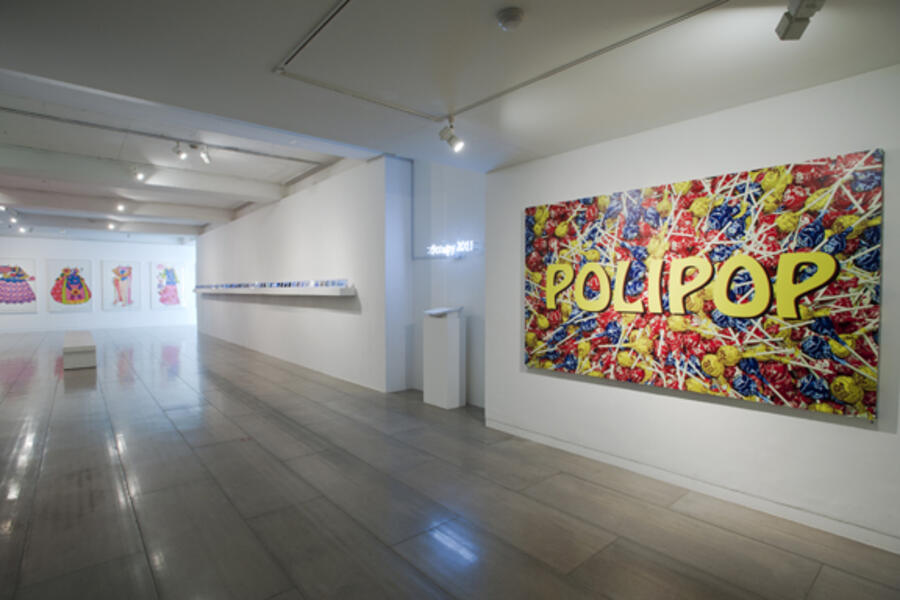 Polipop: Diamond RoomGallery view of Diamond Room, Mina Cheon's solo exhibition "Polipop," at the Sungkok Art Museum, Seoul, Korea, 2012. Mina Cheon's Polipop exhibition includes Polipop digital paintings, video and sculpture installations. This gallery view shows the main digital painting Polipop of the exhibition and Occupy 2011 digital frame monitors digital media piece that deals with collecting a single political pop image of the day throughout 2011. The Diamond Room will include another new piece, Image a Day: Occupy 2011, which is a wall full of digital photo frames that individually rotate pictures. Each frame changes the vast collection of images while all the frames together are showing them in different sync. All throughout 2011, I have selected one image per day that represented the most distinctive political pop image of the day, already existing in news and mass media on the Internet. The selection process was the artistic criteria. The purpose of this piece is to show a collection of one year’s worth of current events as images, encapsulated into digital frames, which signifies the flood of images that repeat throughout the course of the day as headline news framed by televisions or computer monitors. By housing 365 images per digital frame, allowing them to rotate different images, the digital frame installation pays homage to Nam June Paik’s multi-monitor TV installations, with the latest technology of digital photo frame and with a compilation of polipop images of the day over a year. The landscape of photos is a portrait of 2011’s world news and media and the images that are recognizable and that reveal a year’s worth of current events at a glance. The year 2011 ended with a large number of Occupy Demonstrations, starting from Occupy Wall Street to others across the United States to around the world including Occupy Seoul. Hence, the title of the piece includes a subtitle “Occupy 2011.” In a glance, 2011 begins with the up rise in Egypt and ends with Occupy Demonstrations all over the world, with some other media worthy events such as the British Royal Wedding, Japan’s Tsunami and nuclear crisis, on-going global natural disasters, and the passing of Steve Jobs and Kim Jong-il. At the Sungkok Art Museum, this piece is installed in 52 monitors lined up in a row in the middle of the first wall coming into the Diamond Room. Each monitor therefore houses seven images, representing a week worth of images, 52 monitors representing the weeks of the year 2011.
Polipop: Diamond RoomGallery view of Diamond Room, Mina Cheon's solo exhibition "Polipop," at the Sungkok Art Museum, Seoul, Korea, 2012. Mina Cheon's Polipop exhibition includes Polipop digital paintings, video and sculpture installations. This gallery view shows the main digital painting Polipop of the exhibition and Occupy 2011 digital frame monitors digital media piece that deals with collecting a single political pop image of the day throughout 2011. The Diamond Room will include another new piece, Image a Day: Occupy 2011, which is a wall full of digital photo frames that individually rotate pictures. Each frame changes the vast collection of images while all the frames together are showing them in different sync. All throughout 2011, I have selected one image per day that represented the most distinctive political pop image of the day, already existing in news and mass media on the Internet. The selection process was the artistic criteria. The purpose of this piece is to show a collection of one year’s worth of current events as images, encapsulated into digital frames, which signifies the flood of images that repeat throughout the course of the day as headline news framed by televisions or computer monitors. By housing 365 images per digital frame, allowing them to rotate different images, the digital frame installation pays homage to Nam June Paik’s multi-monitor TV installations, with the latest technology of digital photo frame and with a compilation of polipop images of the day over a year. The landscape of photos is a portrait of 2011’s world news and media and the images that are recognizable and that reveal a year’s worth of current events at a glance. The year 2011 ended with a large number of Occupy Demonstrations, starting from Occupy Wall Street to others across the United States to around the world including Occupy Seoul. Hence, the title of the piece includes a subtitle “Occupy 2011.” In a glance, 2011 begins with the up rise in Egypt and ends with Occupy Demonstrations all over the world, with some other media worthy events such as the British Royal Wedding, Japan’s Tsunami and nuclear crisis, on-going global natural disasters, and the passing of Steve Jobs and Kim Jong-il. At the Sungkok Art Museum, this piece is installed in 52 monitors lined up in a row in the middle of the first wall coming into the Diamond Room. Each monitor therefore houses seven images, representing a week worth of images, 52 monitors representing the weeks of the year 2011. -
 Polipop: Dokdo RoomGallery view of Dokdo Room, Mina Cheon's solo exhibition "Polipop," at the Sungkok Art Museum, Seoul, Korea, 2012. Mina Cheon's Polipop exhibition includes Polipop digital paintings, video and sculpture installations. Gallery 2 is the Dokdo Room, a room dedicated to looking at the relationships between neighboring Asian countries such as North and South Korea, and Japan and China, and images that are produced in media culture about each other’s culture, including images of hatred. The main installation for the Dokdo Room is a three-channel video of Dokdo Island. This gallery view shows the video installation about Dokdo, the contested island between Korea and Japan.
Polipop: Dokdo RoomGallery view of Dokdo Room, Mina Cheon's solo exhibition "Polipop," at the Sungkok Art Museum, Seoul, Korea, 2012. Mina Cheon's Polipop exhibition includes Polipop digital paintings, video and sculpture installations. Gallery 2 is the Dokdo Room, a room dedicated to looking at the relationships between neighboring Asian countries such as North and South Korea, and Japan and China, and images that are produced in media culture about each other’s culture, including images of hatred. The main installation for the Dokdo Room is a three-channel video of Dokdo Island. This gallery view shows the video installation about Dokdo, the contested island between Korea and Japan. -
 Polipop: Dokdo RoomGallery view of Dokdo Room, Mina Cheon's solo exhibition "Polipop," at the Sungkok Art Museum, Seoul, Korea, 2012. Mina Cheon's Polipop exhibition includes Polipop digital paintings, video and sculpture installations. This gallery view shows Polipop digital paintings in the themes of rise of Asia, downfall of the Western world, and Dokdo, the contested island between Korea and Japan. This room looks at the relationship between Asian countries, as well as the relationship between the East and West. The series of digital paintings in the Dokdo Room shows images of Asian countries, including China gone capitalistic, Japan’s hatred of Koreans as found in manga imagery, of the dear North Korean dictator Kim Il Sung with Pokémon characters, and images of the Dokdo campaign in various pop ways. The gallery’s wall is painted in red and blue to indicate the political colors of the socialist North and democratic South Korea.
Polipop: Dokdo RoomGallery view of Dokdo Room, Mina Cheon's solo exhibition "Polipop," at the Sungkok Art Museum, Seoul, Korea, 2012. Mina Cheon's Polipop exhibition includes Polipop digital paintings, video and sculpture installations. This gallery view shows Polipop digital paintings in the themes of rise of Asia, downfall of the Western world, and Dokdo, the contested island between Korea and Japan. This room looks at the relationship between Asian countries, as well as the relationship between the East and West. The series of digital paintings in the Dokdo Room shows images of Asian countries, including China gone capitalistic, Japan’s hatred of Koreans as found in manga imagery, of the dear North Korean dictator Kim Il Sung with Pokémon characters, and images of the Dokdo campaign in various pop ways. The gallery’s wall is painted in red and blue to indicate the political colors of the socialist North and democratic South Korea. -
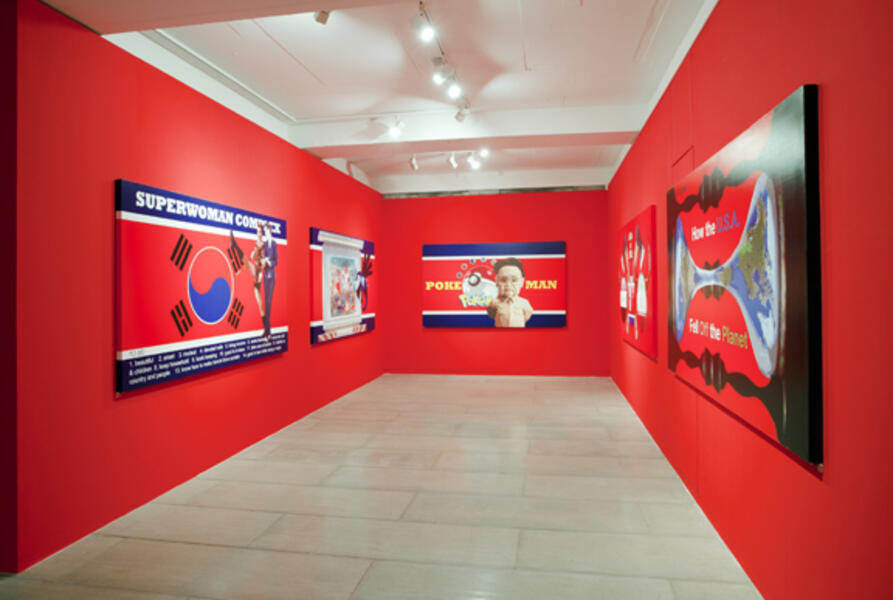 Polipop: Dokdo RoomGallery view of Dokdo Room, Mina Cheon's solo exhibition "Polipop," at the Sungkok Art Museum, Seoul, Korea, 2012. Mina Cheon's Polipop exhibition includes Polipop digital paintings, video and sculpture installations. This gallery view shows Polipop digital paintings in the themes of rise of Asia, downfall of the Western world, and Dokdo, the contested island between Korea and Japan. This room looks at the relationship between Asian countries, as well as the relationship between the East and West.
Polipop: Dokdo RoomGallery view of Dokdo Room, Mina Cheon's solo exhibition "Polipop," at the Sungkok Art Museum, Seoul, Korea, 2012. Mina Cheon's Polipop exhibition includes Polipop digital paintings, video and sculpture installations. This gallery view shows Polipop digital paintings in the themes of rise of Asia, downfall of the Western world, and Dokdo, the contested island between Korea and Japan. This room looks at the relationship between Asian countries, as well as the relationship between the East and West. -
 Polipop: Obama RoomGallery view of Obama Room, Mina Cheon's solo exhibition "Polipop," at the Sungkok Art Museum, Seoul, Korea, 2012. Mina Cheon's Polipop exhibition includes Polipop digital paintings, video and sculpture installations. This gallery view shows Polipop digital paintings in the themes of Obama, the year of the dragon 2012, the war in the Middle East, and issues of race and culture. Many of the digital paintings in the Obama Room are about Obama and the dragon, since the exhibition is the first one of 2012 at the museum, the year of the dragon. These include Falcor from Never Ending Story, Toothless, and the D-War Korean dragon. Other ones in this room explore actors gone politicians, the relationship between entertainment and politics, as well as pieces that comment on today’s ongoing war with the Middle East, and the war’s relationship to media. Hence, the room is also about the American occupation and war in the Middle East, which Obama had to adopt with his presidency. The walls in the gallery are painted yellow overall with just the entrance wall in red. The yellow color works well with the many blue and red palettes of the digital paintings in the room.
Polipop: Obama RoomGallery view of Obama Room, Mina Cheon's solo exhibition "Polipop," at the Sungkok Art Museum, Seoul, Korea, 2012. Mina Cheon's Polipop exhibition includes Polipop digital paintings, video and sculpture installations. This gallery view shows Polipop digital paintings in the themes of Obama, the year of the dragon 2012, the war in the Middle East, and issues of race and culture. Many of the digital paintings in the Obama Room are about Obama and the dragon, since the exhibition is the first one of 2012 at the museum, the year of the dragon. These include Falcor from Never Ending Story, Toothless, and the D-War Korean dragon. Other ones in this room explore actors gone politicians, the relationship between entertainment and politics, as well as pieces that comment on today’s ongoing war with the Middle East, and the war’s relationship to media. Hence, the room is also about the American occupation and war in the Middle East, which Obama had to adopt with his presidency. The walls in the gallery are painted yellow overall with just the entrance wall in red. The yellow color works well with the many blue and red palettes of the digital paintings in the room. -
 Polipop: Obama RoomGallery view of Obama Room, Mina Cheon's solo exhibition "Polipop," at the Sungkok Art Museum, Seoul, Korea, 2012. Mina Cheon's Polipop exhibition includes Polipop digital paintings, video and sculpture installations. This gallery view shows Polipop sculpture and video installation Obama Dancing. The Obama Room is dedicated to the icon of polipop, President Obama and also the year 2012, the year of the dragon. In this gallery, the central installation piece is “Dancing Obama” where DIY Obama action figure, originally manufactured by Jailbreak Toys, Inc. is made as an animation of Obama dancing the famous Ally McBeal dancing baby dance to “Oogachaka” songs. The late 90s hit TV series Ally McBeal was famous for the appearance of a 3D animation baby that became an instant hit, and perhaps sparked a new viral sensation of the animation and music. Obama represented as a white figure suggests the controversy of race that comes along with his presidency, similar to Scott’s piece. Whether color, genetics, or social class determines race, the issues surrounding a black American president is even a household conversation in Korea. The hype over Obama and racial politics can also be found with Donald Trump’s request that Obama produce a birth certificate, where issues of nationality would not have been questioned if he had been a white president.
Polipop: Obama RoomGallery view of Obama Room, Mina Cheon's solo exhibition "Polipop," at the Sungkok Art Museum, Seoul, Korea, 2012. Mina Cheon's Polipop exhibition includes Polipop digital paintings, video and sculpture installations. This gallery view shows Polipop sculpture and video installation Obama Dancing. The Obama Room is dedicated to the icon of polipop, President Obama and also the year 2012, the year of the dragon. In this gallery, the central installation piece is “Dancing Obama” where DIY Obama action figure, originally manufactured by Jailbreak Toys, Inc. is made as an animation of Obama dancing the famous Ally McBeal dancing baby dance to “Oogachaka” songs. The late 90s hit TV series Ally McBeal was famous for the appearance of a 3D animation baby that became an instant hit, and perhaps sparked a new viral sensation of the animation and music. Obama represented as a white figure suggests the controversy of race that comes along with his presidency, similar to Scott’s piece. Whether color, genetics, or social class determines race, the issues surrounding a black American president is even a household conversation in Korea. The hype over Obama and racial politics can also be found with Donald Trump’s request that Obama produce a birth certificate, where issues of nationality would not have been questioned if he had been a white president. -
 Obama DancingGallery view of Obama Room, Mina Cheon's solo exhibition "Polipop," at the Sungkok Art Museum, Seoul, Korea, 2012. Obama Dancing, video installation 2012 Polipop (Political Pop Art) by Mina Cheon was first shown at Sungkok Art Museum, Seoul, Korea in the Obama Room, Polipop, solo-exhibition by Mina Cheon. This is one of the videos of the three channel video installation with rotating Styrofoam sculpture of Obama. The installation was also later installed at the Seoul Olympic Museum of Art in Seoul, South Korea between February 7 - March 31, 2013. Obama Dancing appropriates a small action figure toy known as "Do-It-Yourself (DIY) Obama" and is made into a life-size Styrofoam statue, fabricated at the scale of President Barack Obama's physical height (6'11" or 186 cm). The statue stands on a turntable, rotating slowly in the gallery to music and a three channel video installation. Obama, as the Polipop (political pop art) icon of our time is highlighted both as monumental, larger than life figure, as well as easily accessible due to mass media and proliferation of his imagery in popular culture. The video channels is a series of animation made by the artist of Obama dancing the famous Ally McBeal (American television show series) baby dance to "Oogachaka" songs. The late 90s hit TV series Ally McBeal was famous for the appearance of a 3D animation baby, which became an instant television series hit, and sparked a new viral sensation of the animation and music before the time of the Internet. The artist was fascinated by the action figure (manufactured by Jailbreak Toys, Inc.) that came in a box with a white Obama toy that one can DIY paint. Obama as the first African-American President in the United States has raised continued discussion about race, culture, and politics in America, and the artist felt the need to distill some of the irony of a white Obama toy through this installation. Music: "Dancing Baby" song in Ally McBeal (American television show series) includes variations of "Hooked on a Feeling" and "Oogachaka," sung first by B.J. Thomas and then by Blue Swede.
Obama DancingGallery view of Obama Room, Mina Cheon's solo exhibition "Polipop," at the Sungkok Art Museum, Seoul, Korea, 2012. Obama Dancing, video installation 2012 Polipop (Political Pop Art) by Mina Cheon was first shown at Sungkok Art Museum, Seoul, Korea in the Obama Room, Polipop, solo-exhibition by Mina Cheon. This is one of the videos of the three channel video installation with rotating Styrofoam sculpture of Obama. The installation was also later installed at the Seoul Olympic Museum of Art in Seoul, South Korea between February 7 - March 31, 2013. Obama Dancing appropriates a small action figure toy known as "Do-It-Yourself (DIY) Obama" and is made into a life-size Styrofoam statue, fabricated at the scale of President Barack Obama's physical height (6'11" or 186 cm). The statue stands on a turntable, rotating slowly in the gallery to music and a three channel video installation. Obama, as the Polipop (political pop art) icon of our time is highlighted both as monumental, larger than life figure, as well as easily accessible due to mass media and proliferation of his imagery in popular culture. The video channels is a series of animation made by the artist of Obama dancing the famous Ally McBeal (American television show series) baby dance to "Oogachaka" songs. The late 90s hit TV series Ally McBeal was famous for the appearance of a 3D animation baby, which became an instant television series hit, and sparked a new viral sensation of the animation and music before the time of the Internet. The artist was fascinated by the action figure (manufactured by Jailbreak Toys, Inc.) that came in a box with a white Obama toy that one can DIY paint. Obama as the first African-American President in the United States has raised continued discussion about race, culture, and politics in America, and the artist felt the need to distill some of the irony of a white Obama toy through this installation. Music: "Dancing Baby" song in Ally McBeal (American television show series) includes variations of "Hooked on a Feeling" and "Oogachaka," sung first by B.J. Thomas and then by Blue Swede.
